
Spring/Summer 2023 | Volume 2 | Issue 1
BOARD OF TRUSTEES, 2023-2024
Anthony (Tony) R. Sapienza, Chair
Paulina Arruda
Christina Bascom
Ricardo Bermudez
Susan Costa
Douglas Crocker II
Betsy Fallon
John N. Garfield, Jr.
David Gomes
Edward M. Howland II
Meg Howland
James Hughes
D. Lloyd Macdonald
Ralph Martin
Eugene Monteiro
Michael Moore, Ph.D.
Gilbert Perry
Victoria Pope
Dana Rebeiro
Maria Rosario
Lucy Rose-Correia
Brian J. Rothschild, Ph.D.
Nancy Shanik
Hardwick Simmons
Bernadette Souza
Carol M. Taylor, Ph.D.
R. Davis Webb
Alison Wells
Lisa Whitney
Susan M. Wolkoff
David W. Wright
Front Cover Image: Detail of Fred Albert Harvie (American, 1929-2005), Model of 227 Arnold Street, New Bedford, MA [Interior view] circa 1982. Dollhouse and interior furnishings, NBWM, 2021.30. Gift of Mary Edwards.
Back Cover Image: Detail from Daphne Ollivierre (Bequia, St. Vincent and the Grenadines; 1944-2021), Flensing a Pilot Whale at Petit Nevis, 1975. Hand-sewn cotton, 30 x 40 inches, NBWM, Kendall Collection, 2001.100.4867. Gift of Norman Flayderman.
Vistas: A Journal of Art, History, Science and Culture
Copyright © 2023 New Bedford Whaling Museum
All rights reserved. No part of this publication may be reproduced, distributed, or transmitted in any form or by any means, including photocopying, recording, or other electronic or mechanical methods, without the written permission of the publisher, except in the case of brief quotations embodied in reviews and certain other non-commercial used permitted by copyright law.
18 Johnny Cake Hill
New Bedford, MA 02740
www.whalingmuseum.org
Spring/Summer 2023 | Volume 2 | Issue 1
Publisher
New Bedford Whaling Museum
President & CEO
Amanda McMullen
Design and Production
Brian Bierig, Graphic Designer
Consulting Editor
Naomi Slipp
Photography
Melanie Correia
Editor Michael P. Dyer
Contact
mdyer@whalingmuseum.org
(508) 717-6837
Scholarship & Publications Committee
Michael Moore (Chair)
Mary Jean Blasdale
John Bockstoce
Mary K. Bercaw-Edwards
Tim Evans
Ken Hartnett
Judy Lund
Daniela Melo
David Nelson
Victoria Pope
Brian Rothschild
Tony Sapienza
Jan da Silva

1 | Spring/Summer 2023
Dean Chase Wright (American, 1819-1895). Sea creatures including a sunfish drawn in his “Commonplace Book” kept onboard the ship Benjamin Rush of Warren, RI, 1841-1845. Pencil and watercolor on paper, 12 ½ x 7 ½ inches. NBWM, Kendall Collection. A-145.
Spreading
2 Contents Foreword ............................................................ 3 The Old Dartmouth Historical Society Finding Its Home, 1904-1916 5 Feature Articles From Sailors to Boarding House Keepers: Portuguese Mobility in New Bedford (1815-1900) By Anne-Sophie Coudray ......................................... 7 Documenting a Fred Harvie Miniature Model House By Dave and Marilyn Ferkinhoff ............................ 13 Book Talk Comets, Meteors, and UFOs in NineteenthCentury Skies By Mark D. Procknik ............................................. 17 Sharing Our Local History A Metaphor in Dartmouth: DHAS and its Quaker Transcription Project By Sally Aldrich, Robert J. Barboza, Richard W. Gifford, Robert E. Harding, Andrew Marcovici, and Marian Ryall .................................................... 21 From Our Fellows Picturing Pilot Whales, from George Hathaway Nickerson to Daniel Ranalli By Marina Dawn Wells 25 Paper Money and the “Free Banking Era” of 18371862: The NBWM Paper Currency Collection By Aidan Goddu..................................................... 29
About Stuff Stitching as Personal History: Quilts in the Collection By Naomi Slipp ...................................................... 35 Fresh Perspectives “A Catalyst for the Greater Good” By Waverly Verissimo 39
All
the Word “Contrary to both law and reason”: The Danish seizure
the
Nancy
1810 Transcriptions by John Ricketson and Bob Hussey with explanatory notes by Michael P. Dyer ............. 41 Lighting the Way Women of Both Energy and Enterprise By Cathy Saunders and Carole Clifford .................. 45 Poetic Insights The Cutting-In. After reading Fathoms by Rebecca Giggs By Richard Dey 47 Animals and Issues Holy Mola! By Carol “Krill” Carson .......................................... 49 Exhibit Highlights A Singularly Marine & Fabulous Produce: The Cultures of Seaweed By Maura Coughlin ................................................ 53 Common Ground: A Family Reunited By Emily Reinl........................................................ 55 “All Hands”: Yankee Whaling and the U.S. Navy By Emma K. Sylvia ................................................. 57 Book Reviews Black Lives, Native Lands, White Worlds –A History of Slavery in New England By Janine V. da Silva 61 Yankees in the Indian Ocean: American Commerce and Whaling, 1786-1860 By Michael P. Dyer ................................................. 63 Connecting Women: National and International Networks during the Long Nineteenth Century By Anne Boyd 65
of
brig
of Rochester, MA,
By Bob Rocha and Emma Rocha 68 Spring/Summer 2023 | Volume 2 | Issue 1
Looking Back
Foreword
Our first issue of Vistas: A Journal of Art, History, Science and Culture was very well received. I am delighted to be providing our encore. With July 22nd marking 120 years of the Old Dartmouth Historical Society, this moment has me reflecting on the Museum’s legacy – an interesting, important, and complicated word.
Established as a legacy museum, our purpose was well defined by Old Dartmouth Historical Society President William W. Crapo, who noted in 1903:
No effort should be spared to preserve the story of the past, describe its events and incidents or keep alive the memories of the men and women who contributed to the advancement of the community. The coming generations are entitled to this knowledge, and it rests upon us to furnish it.
Last year when Daniel Weiss, President & CEO of the Metropolitan Museum of Art, addressed members at our annual meeting he spoke about the creation and evolution of museums globally. Noting the unique nature of the “American museum experiment” in the 19th and 20th century, Weiss commented that “there was something very new and distinctive about the American museum,” because they are created by the local community and not established by kings or governments.
Thanks in large part to the trans-global whaling industry, our local community became one of the first truly cosmopolitan communities in the United States. Today, the New Bedford and SouthCoast population remains greatly diverse. The Museum’s five-year strategic plan, launched in 2020, prioritized the consideration of our institutional legacy and how we connect with and serve our community. Emphasizing our purpose through the overarching goals to Welcome, Engage, Steward & Thrive, NBWM chartered a deeper and more intentional path towards diversity, equity, accessibility, and
inclusion across our collections, galleries, staffing, and programming.
Putting focus on our community, we began our exploration by inviting feedback and I was pleased to hear from more than 500 members, neighbors, staff, trustees, volunteers and visitors. In 2021, I issued a report entitled “Building a Museum for All” which outlined a thoughtful, multi-year approach to advancing our commitment through deeds and not performative words. Since then, we have accelerated our efforts through numerous guided learning sessions for our staff, volunteers, and trustees, established a staff DEAI committee, increased representation on our board, shaped a position dedicated to the visitor and community experience, conducted a year-long Equity in Leadership learning program for our High School Apprentice alumni, created paid fellowships and internships, expanded the range of narratives and stories presented on our walls, and grown the diversity of our public programs. Every single step to date has resulted in increased visitation and broader community participation.
An important next step is to examine our collections and institutional history. A museum’s collection illustrates its priorities. It records whose histories were collected and, therefore, whose histories were deemed important at different moments in time. We must ask ourselves, when it comes to our collection: who is represented, who is underrepresented, and who is misrepresented? To be clear, this is not about eliminating narratives; it is about adding in. Our duty begs consideration of how we can best reflect the diversity of our community today, and strive to be responsible stewards for items in our collection that were created by Native and Indigenous makers.
Our work is being noticed and we are emerging as leaders in this critical space. Recently the Jessie Ball duPont Fund awarded us a $100,000 grant to accelerate our steps towards being a Museum for All. The grant will provide training for creating
3 | Spring/Summer 2023
sensory-friendly museum experiences to expand access, support work towards ethical stewardship in partnership with Indigenous descendant communities and heritage stakeholders, and underwrite the work of our staff Diversity, Equity, Accessibility, and Inclusion task force.
I have been asked if I am worried about what we will find when we look inward. My answer is simple: I am far more concerned about what we will find if we do not take these steps. Relevance is the quality of being closely connected. How can the NBWM engage in relevant leadership in the closely connected community of New Bedford without fully understanding who we are as an institution, how we got here, and where we are going?
In his closing address, Weiss noted the common question of who owns museums. In the United States, he noted, they are “founded by our citizens. In New Bedford it was 100 citizens who came together to create this museum. And it was founded by the idea that we will all own it, we will work together to develop a vision for this institution in service to our community.” He went on to observe that “over the course of more than a century in New Bedford, you have increasingly perfected the realization of that mission by serving more and more different constituencies in the larger community.”
That, right there, is the legacy we are building.
Amanda McMullen President & CEO New Bedford Whaling Museum
4
The Old Dartmouth Historical Society Finding Its Home, 1904-1916
The Masonic Building was built in 1893 and for many years housed the offices of civil engineers, insurance companies, stenographers and other professionals before the new Old Dartmouth Historical Society rented space for their meetings and exhibitions.
In June 1903, Abbot P. Smith (1853-1943), member of the ODHS Committee on a Temporary Museum (later Chairman of the Museum Section), reported that a room had been secured at the Masonic Building over the Ruggles and Ellison Dry Goods Store at 191 Union Street. Forty-eight men and women made up the Museum Section and “aroused an interest in the community that nothing else would have done.” The first ODHS exhibition opened in February 1904, and included portraiture, samplers, fans, decorative arts, marine ivories, objects from the Arctic and Oceania, whaling equipment, ship models, ship carvings, furniture, and curiosities. In years to come, some of the objects visible in these exhibit photographs would come into the Museum’s permanent collection.

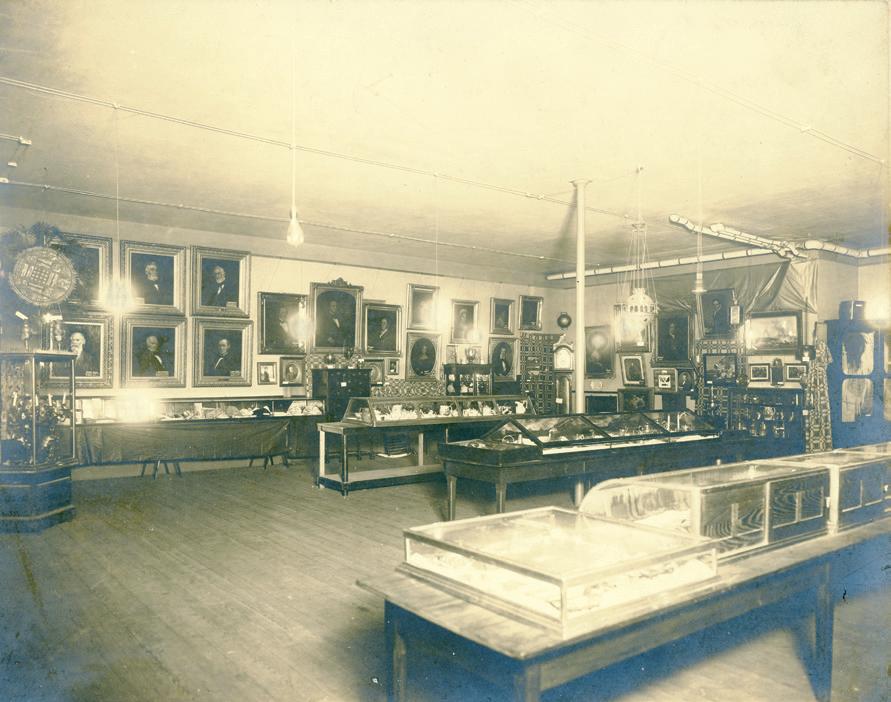

5 | Spring/Summer 2023
Figs. 2 & 3. Joseph G. Tirrell (American, 1840-1907), Views of the first Old Dartmouth Historical Society Loan Exhibition, 1904. Mounted albumen prints. NBWM 1988.6.312; NBWM 2000.100.44
Fig. 1. Norman Fortier (American, 1919-2010), View of the Masonic Building, Corner of Union and Pleasant Streets, 1951. Image derived from an acetate negative. NBWM, 2004.11.57256.1
The 35 North Water Street building was originally built as the National Bank of Commerce in 1884. The bank moved to the Masonic Building on Pleasant and Union Streets and went into liquidation in 1898. The New England Cotton Yarn Company purchased the Water Street building in 1899, and then failed. At the urging of ODHS President William W. Crapo (1830-1926), Fairhaven oil magnate Henry Huttleston Rogers (1840-1909) bought the building and donated it to the Old Dartmouth

Society in 1906, when it became popularly known as the “Rogers Building.”

Several objects in this photograph of the ODHS exhibition space in the Rogers Building were on loan to the organization, illustrating the fledgling organization’s relationship to the community. For example, the William Bradford portrait of the ship Twilight (on wall at right) would not be accessioned into the permanent collection until decades later and the Manuel Pacheco Gamboa diorama of a sperm whaling scene (to the right of the fireplace) was acquired by the Kendall Whaling Museum in the 1960s. Captain Benjamin Cleveland acquired the two penguin specimens on a whaling voyage to Antarctica in the brig Daisy with ornithologist Robert Cushman Murphy in 1913. His wife, Emma A. Fish Cleveland donated the specimens in 1930.
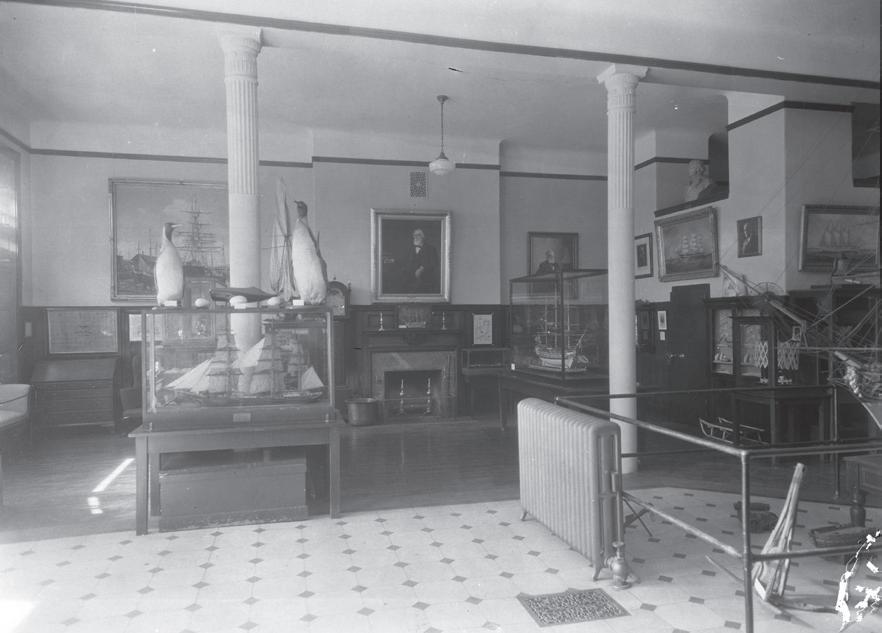
Emily Howland Bourne’s (1835-1922) generous cash donation enabled the ODHS to construct a building memorializing her father, Jonathan Bourne Jr’s, success as a whaling agent. The Bourne Building, modeled on the Custom House at Salem, MA and housing a half-scale model of the whaling bark Lagoda, is an important example of purpose-built museum architecture in the early twentieth century.
As the Bourne Building was being constructed on the other side of the block, it was business as usual along North Water Street. The ODHS sat in the middle of a busy business district. The Rogers Building housed galleries devoted to colonial history, whaling, textiles, photography, and arts of Oceania. Their neighbors included firms like Slocum & Kilburn selling mill supplies, John Cleary manufacturing cigars, and electrical contractors like Gatenby & Swift.
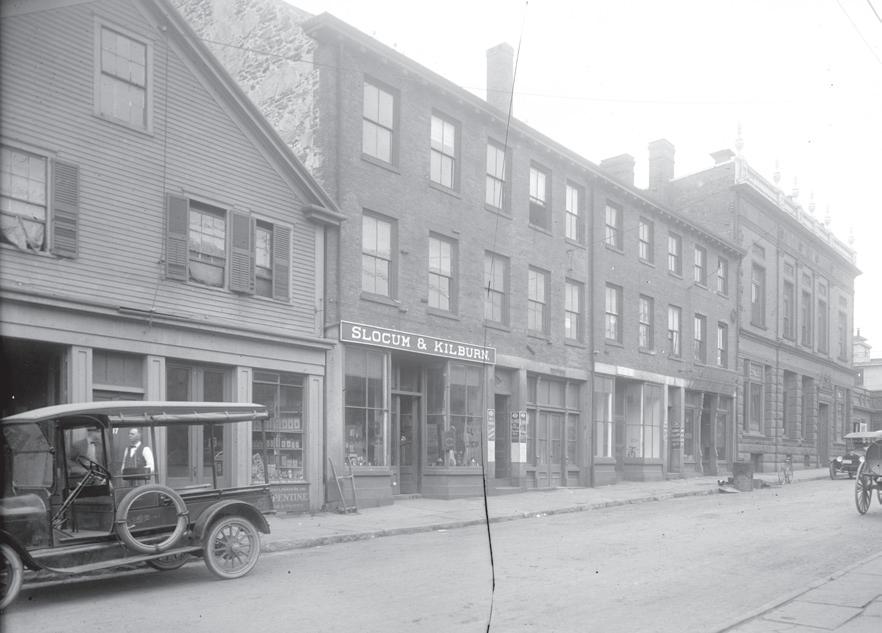
6
Fig. 7. Standard-Times photograph, View of the buildings along the west side of North Water Street, circa 1915. Image derived from a glass plate negative. NBWM, 1981.61.926
Fig. 6. Attributed to Joseph S. Martin (American, 1883-1947), View of the Jonathan Bourne Memorial Whaling Museum at the ODHS Under Construction, October 25, 1915. Image derived from a silver gelatin print. NBWM, 2000.100.89.3.324
Fig. 5. Joseph Sisson Martin (American, 1882-1947), Interior view of an early ODHS exhibition gallery, c. 1920. Image derived from an acetate negative. NBWM, 2000.100.85.317.
Fig. 4. Fred W. Palmer (American, fl. New Bedford, 1889-1910), View of the National Bank of Commerce Building, c. 1906. Image derived from a glass plate negative. NBWM, 2000.100.80.226.
Historical
From Sailors to Boarding House Keepers
Portuguese Mobility in New Bedford (1815-1900)
By Anne-Sophie Coudray, Ph.D, Student, École des Hautes Études en Sciences Sociales, International Research Center on Slaveries & Post-Slaveries (CIRESC)
Seaport cities and towns like New Bedford catered to a large number of itinerant seamen. Whaling merchants commonly recruited men from many American seaports and whaling masters did so as well at many ports of call around the world. Providing lodging for these men as they waited for their voyage to sail or after they had returned to New Bedford was an integral function in the workings of the seaport.
In 1856, Joseph Vera (circa 1820-1894) was one of the first Portuguese immigrants to open a boarding house in the city of New Bedford, at 113 South Water Street.1 Having emigrated a few years earlier to the United States as a sailor, Vera was among those who saw the whaling enterprise as a means of economic mobility in the United States. Born in Pico in the Azores archipelago, he joined several whaling ships


7 | Spring/Summer 2023
Feature Article
1 Managed either by Joseph or his son, Frank, this establishment would have a twenty-eight-year long tenure and become the most sustainable boarding house in New Bedford.
Fig. 1. William Allen Wall, Portraits of Joseph Vera and Anne Rose Donavan Vera, ca. 1867. Oil on canvas, NBWM 1989.48.1-2. Gift of Joseph S. Vera.
before settling permanently in New Bedford.2
Between 1857 and 1880 he invested in thirteen whaling voyages alongside individuals belonging to the political and industrial elite of New Bedford. In the time-honored tradition of this highly successful whaling port, he partnered his investments in ships with other influential merchants. During the Civil War, he diversified his activities, invested in the ownership of several whaling ships, and became a merchant clothier in addition to running his boarding house.3
In the late 1860’s, Vera abandoned the management of the boarding house and fully devoted himself to his whaling investments. In 1867, John Rose, a former sailor originally from Faial, took over the management of the boarding house.4 At the same time, he and Joseph Vera partnered in the creation of the “Vera & Close” corporation, specializing in the sale of textile products.5 Located at the same address as the boarding house, the establishment became a multipurpose place offering various services for transient and immigrant populations.
In 1869, Joseph Vera’s thirty-two-year-old son Frank took over the management of the boarding house.6 Born in 1837 in Pico, he joined his father in the United States in 1853 through whaling.7 Although it is difficult to measure how long Frank Vera had been a whaleman, it is likely that he first joined a whaling ship as a cabin boy before joining
2 Massachusetts Vital Records, 1840-1911 (Boston, MA: New England Historic Genealogical Society, 1894), 266.
3 New Bedford whaling merchants were often ship chandlers, grocers, clothiers, or operated other businesses of direct value to whaling. These businesses not only provided cash for investment, but also served the outfitting needs of the vessels and the men who operated them.
4 The New-Bedford City Directory for 1867-68, Containing the General Directory of the Citizens city and County Register, Business Directory (Boston: Dudley & Greeough, 1867), p. 218.
5 Ibid, p. 226.
6 New England Historic Genealogical Society; Massachusetts U-S Marriages Records 1840-1915, Boston, Massachusetts; Massachusetts Vital Records, 1911–1915, 1870.
7 National Archives at Boston; Waltham, Massachusetts; ARC Title: Petitions and Records of Naturalization, 8/1845 - 12/1911; NAI Number: 3000057; Record Group Title: Records of District Courts of the United States, 1685-2009; Record Group Number: RG 21.
subsequent voyages. In 1861, he joined the ship Majestic, Alexander Augustus Tripp, master, for a fivemonth sperm whaling voyage to the North Atlantic. Thanks to their various commercial activities, the Vera family experienced a rapid economic rise that propelled them up the social hierarchy, with their accumulation of economic capital largely due to the operation of their boarding house.
In the 1850’s, individuals of Portuguese origin were poorly represented among the community leaders of New Bedford, including the boarding house ownership. Of the seventy-three such establishments, eight were held by Azoreans and Cape Verdeans in 1859.8 While the second half of the nineteenth century heralded the gradual decline of the whaling industry, it also saw an increase in the recruitment of seafarers from the Azores and Cape Verde. They became among the most widely represented groups of crew on the whaling ships. When Joseph Vera opened the doors of his boarding house in 1856, 1600 sailors from the Portuguese Atlantic islands were recruited on board whaling boats from New Bedford, representing 12% of the crew. Between 1845 and 1920, the presence of Portuguese sailors on board whaling ships increased from 6.7% to 50%.9 Vera’s boarding house thus became a privileged accommodation for Portuguese sailors.
The increasing involvement of the Portuguese in the whaling industry coincided with a period of mass immigration to the industrial metropolises of New England. Between 1840 and 1850, more than four million European emigrants joined the east coast cities of the United States.10 The city of New Bedford saw the growth and development of commercial textile manufacturing, making it an important center of European immigration. Between 1880 and 1900, the city’s population doubled from 26,840 to
9 Russel G. Handsman, Kathryn Grover, Donald Warrin, New Bedford Communities of Whaling: People of Wampanoag African and Portuguese Island Descent, 1825-1925 (Boston, MA: National Park Service, 2021), 306.
10 Roger Daniels, Coming to America. A History of Immigration and Ethnicity in American Life (New York: Harper Perennial, 1991), 124-125.
8
8 The New-Bedford City Directory, Containing the City Register and a General Directory of the Citizens (New Bedford, MA: Charles Taber & Co., 1859).
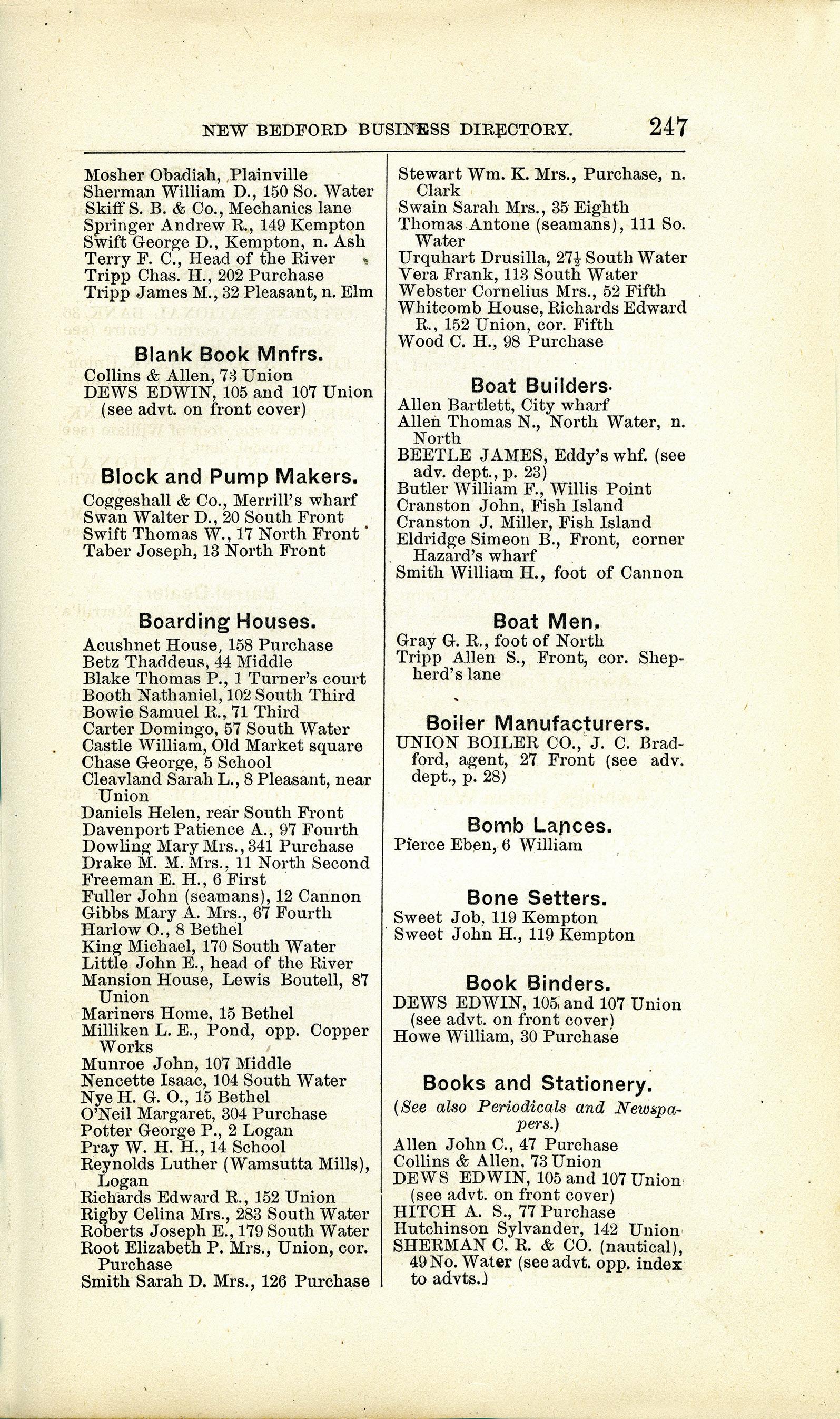
9 | Spring/Summer 2023
Fig. 2. List of boarding houses in 1875, New Bedford, Massachusetts, City Directory, p. 247.
62,442. Portuguese immigrants represent 14% of the immigrant population.11 In 1880, the number of Portuguese immigrants in the United States is estimated at 16,650; it reached 114,321 in 1921.12
In seaports such as Boston, New Bedford, and Providence, boarding houses became places of reception not only for sailors but also for laborers, skilled craftsmen, and employees from the new white-collar middle class.13 Throughout the century, the boarding houses catering to itinerant workers and seafarers were a recurring feature of the urban seaport landscape and a testament to the many demographic changes experienced by industrial metropolises. As a reception and place for socialization, these establishments offered services including sleeping, meals, clothing, and other necessary goods that distinguished them from mere lodging houses. The increase in Portuguese emigration through the whale fishery strongly influenced the emergence of a new group of Portuguese boarding house owners. The maritime experience of the latter was a critical attraction for individuals seeking more permanent settlement. This made some Portuguese boarding houses in New Bedford and Boston important places of recruitment of Portuguese sailors.
Over nearly three decades, the Vera family supplied many whaling ships with manpower, some recruited for their own vessels. Many investment partnerships linked them to more established shipowners making them privileged interlocutors in the search for sailors. On the strength of his economic success, in 1880 Joseph Vera became the sole owner of the schooner Lottie E. Cook of New Bedford, which made five whaling voyages until 1887. Of the eighty-five crew members who made up these voyages, fifty-six were from the Portuguese Atlantic, the majority from the Azores, Cape Verde, and to a lesser extent Lusophone Africa, including Mozambique and Angola. The
11 Christine A. Arao, and Patrick L. Elefey, Safely Moored At Last, Cultural Landscape Report For New Bedford Whaling National Historical Park, Vol 1 (Boston, MA: National Park Service, 1998), 41.
12 Marylin Newitt, Emigration and the Sea, An alternative history of Portugal and the Portuguese (Oxford, UK: Oxford University Press, 2015), 191.
13 Wendy Gamber, The Boardinghouse in Nineteenth-century America (Baltimore: Johns Hopkins University Press, 2007), p. 3.
exceptional longevity of the Vera boarding house seems justified by their complementary commercial activities. While several of the owners of these boarding houses were former sailors, those who managed to broaden invests in the purchase of whaling vessels were a minority.
Between 1856 and 1896, only four other Portuguese boarding house keepers, Francis T. Perry (18281901), Joseph F. Lima (1835-1882), John Joseph Fernandes, and Joseph Fernandes Pinna (401 South Water St.) acquired sufficient prosperity to move towards investment in shipping after the opening of their boarding house.14 Both Pinna and Fernandes invested in packet schooners although their investments were short-lived. Fernandes bought the schooner Irving of New Bedford which was wrecked off Nantucket in 1875 en route to Cape Verde with passengers and a cargo of goats and whale oil. Pinna invested in one voyage of the schooner Sarah E. Lee of New Bedford in 1906. Like the Vera family, these individuals also owned clothing stores for sailors. In 1872, for instance, former sailors Francis T. Perry and Joseph F. Lima shared ownership of the brig George J. Jones of Fairhaven, with other investors.15 The similar trajectories of these Portuguese sailors who were boarding house keepers, merchants, and shipowners illustrate how whaling was a pathway to economic flexibility for some sailors.
Perry was originally from the Azores and opened a clothing store in 1859 at 89 South Water Street in New Bedford; this address became a boarding house in 1865.16 He subsequently sold his businesses to Joseph Fernandes Lima (1829-1882), who became the new owner in 1877.17 Between 1878 and 1881, Lima invested 4/52 shares in the schooner Surprise
14 Late nineteenth century immigrants’ names often appear in their anglicized forms in New Bedford records like the City Directories
15 Ship Registers of New Bedford, Massachusetts Compiled from original documents stored in the New Bedford Custom House, Volume III 1866-1939 (Boston: National Archives Project 1940), p. 68.
16 The New-Bedford City Directory, Containing the City Register and a General Directory of the Citizens (New Bedford, MA: Charles Taber & Co., 1859), p. 140.
17 The New-Bedford City Directory, Inhabitants, Institutions, Manufacturing Establishments, Business, Societies, Business Firms, etc, in the City of New Bedford for 1877-1878 (Boston: W.A. Greenough & Co., 1877), p. 277.
10
of New Bedford, alongside several city craftsmen, including coopers, a physician, another boarding house manager, a pump and block maker, and other skilled laborers.18 The management of the schooner Surprise stands as a prime example of whaling as a means toward community investment and upward economic mobility. For each of the vessel’s five voyages under this disparate group of investors, Portuguese seamen represented most of the crew members. They were likely recruited through the local complex of boarding houses.
In the 1880’s, merchants encountered many difficulties recruiting maritime labor in New Bedford. Some used coercive methods, called crimping or shanghaiing, to recruit sailors. In 1881, a report prepared by the United States Commission of Fish and Fisheries mentions the major role New Bedford clothing merchants, outfitters, and boarding house owners played in sailor’s recruitment:
The crews at New-Bedford are generally furnished by a class of merchants known as “outfitters” assisted by boarding house keepers. [….] Both of these classes are known locally as “sharks”. When the Agent of a ship wants a crew, he notifies the outfitter who draw upon “the shipping master” in New York, Boston or the boarding house keepers in New Bedford for the number of men required.19
Howland Street in New Bedford. In 1890, John Wing, part-owner with his brother William of the merchant tailor firm J. & W R Wing & Co., along with Justino A. Ferreira, supported Antonio Tavares de Pinna’s request for access to naturalization as witnesses.20 A year after obtaining his US citizenship, the latter opened his own boarding house located at 8 Walnut Street in New Bedford.21
After 1850, boarding houses became important channels of migration. Alongside ship owners and sailors, boarding house owners from the first wave of emigration encouraged the naturalization of other Portuguese boarding house keepers and sailors. In 1862, Joseph F. Lima obtained American naturalization thanks to the support of Francis T. Perry and Francis Lewis, a shoe merchant.22 On November 15, 1880, Frank Vera obtained American naturalization thanks to the support of two Boston boarding house keepers, Joseph J. Alves and Antonio J. Avellar, who were both actively involved in naturalization procedures of Portuguese sailors and boarding house keepers. The same day, he supported the request for naturalization of a Portuguese sailor named John Oliver Perry, alongside another Boston boarding house keeper named Antonio Enos.23 These initiatives all suggest a national solidarity, revealing above all some common interests for the exchange of maritime labors. At the end of the 1800s, the boarding house keepers of New Bedford forged real commercial links for the recruitment of labor and the realization of economic benefit.24
20 National Archives at Boston; Waltham, Massachusetts, Copies of Petitions and Naturalizations in New England Courts, 1787-1906, Bristol County, Third District Court, New Bedford, Ma, Vol· 1885 to 1896, Pg 805-1453 B, Ca· 1787-1906.
21 The New-Bedford City Directory, Inhabitants, Institutions, Manufacturing Establishments, Business, Societies, Business Firms, etc, in the City of New Bedford (Boston: W.A. Greenough & Co.,, 1891), p. 390.
at 47
While the involvement of boarding house keepers in the exploitation of an immigrant workforce cannot be affirmed, their presence as witnesses alongside shipowners in the individual acts of naturalization of seamen and other Portuguese immigrants demonstrate a clear alliance in the recruitment of sailors. In 1890, Antonio Tavares de Pinna obtained US Citizenship. Born in 1859 in Brava, he emigrated to the United States in 1874 as a whaleman. Between 1874 and 1890, he made four whaling voyages, while living intermittently in the boarding house of Justino A. Ferreira
18 Ship Registers of New Bedford, Massachusetts Compiled from original documents stored in the New Bedford Custom House, Volume III 1866-1939, (Boston, The National Archives Project, Work Projects Administration, 1940), p. 163.
19 George Brown Goode, United States Commission of Fish and Fisheries, The Fisheries and the Fishery Industries of the United States, Section V, History and Methods of the Fisheries …, Volume II (Washington: Government Printing Office 1887), p. 224.
22 The New-Bedford City Directory, Inhabitants, Institutions, Manufacturing Establishments, Business, Societies, Business Firms, etc, in the City of New Bedford (New Bedford, 1867), p. 219.
23 National Archives at Boston; Waltham, Massachusetts; ARC Title: Petitions and Records of Naturalization, 8/1845 - 12/1911; NAI Number: 3000057; Record Group Title: Records of District Courts of the United States, 1685-2009; Record Group Number: RG 21.
24 Bureau of the Navigation, Annual Report of the Commissioner of Navigation to the Secretary of the Treasury (Washington: Government Printing Office, 1898), p. 198.
11 | Spring/Summer 2023
In 1883, the Vera boarding house and clothing business closed. Frank Vera Jr. (1874-1959) chose quite a different career path from his father, becoming a lawyer.25 Thanks to the economic prosperity and strong community engagement created by his family through the whaling era, he was integrated in the professional life of New Bedford. While he became justice of the peace in 1900, he nevertheless continued to maintain close ties with Portuguese sailors and

25 United States federal Census, Massachusetts, Bristol, New Bedford Ward 05, District 0194, Massachusetts; Roll: 637; Page: 13; Enumeration District: 0194; FHL microfilm: 1240638, 1900.
boarding house keepers, validating naturalization requests into the 1950s.
12
Fig. 3. Joseph G. Tirrell, Boarding houses on the east side of Bethel Street looking north from Union St., New Bedford, circa 1900. Silver gelatin print, NBWM 2000.100.89.1.1.26.
Documenting a Fred Harvie Miniature Model House
By Dave and Marilyn Ferkinhoff, New Bedford Whaling Museum Volunteers
We’ve recently had the opportunity to restore a rather spectacular model house donated to the NBWM in 2021. The model is based upon an old New Bedford house originally built in 1876 at 227 Arnold St. which still stands today.1 The donor, Mary Edwards, is the niece of George and Katherine Castino, the former owners of the house. Ms. Edwards commissioned famed miniaturist Fred Albert Harvie (1929-2005) to build it, stating that she had “fond memories of it” growing up. Harvie was originally a carpenter and house builder in Hingham, MA, but in 1975 he and his wife Jean opened “Fred’s Dollhouse and Miniature 1 Zillow search, https://www.zillow.com/homedetails/227-Arnold-StNew-Bedford-MA-02740/55996079_zpid/
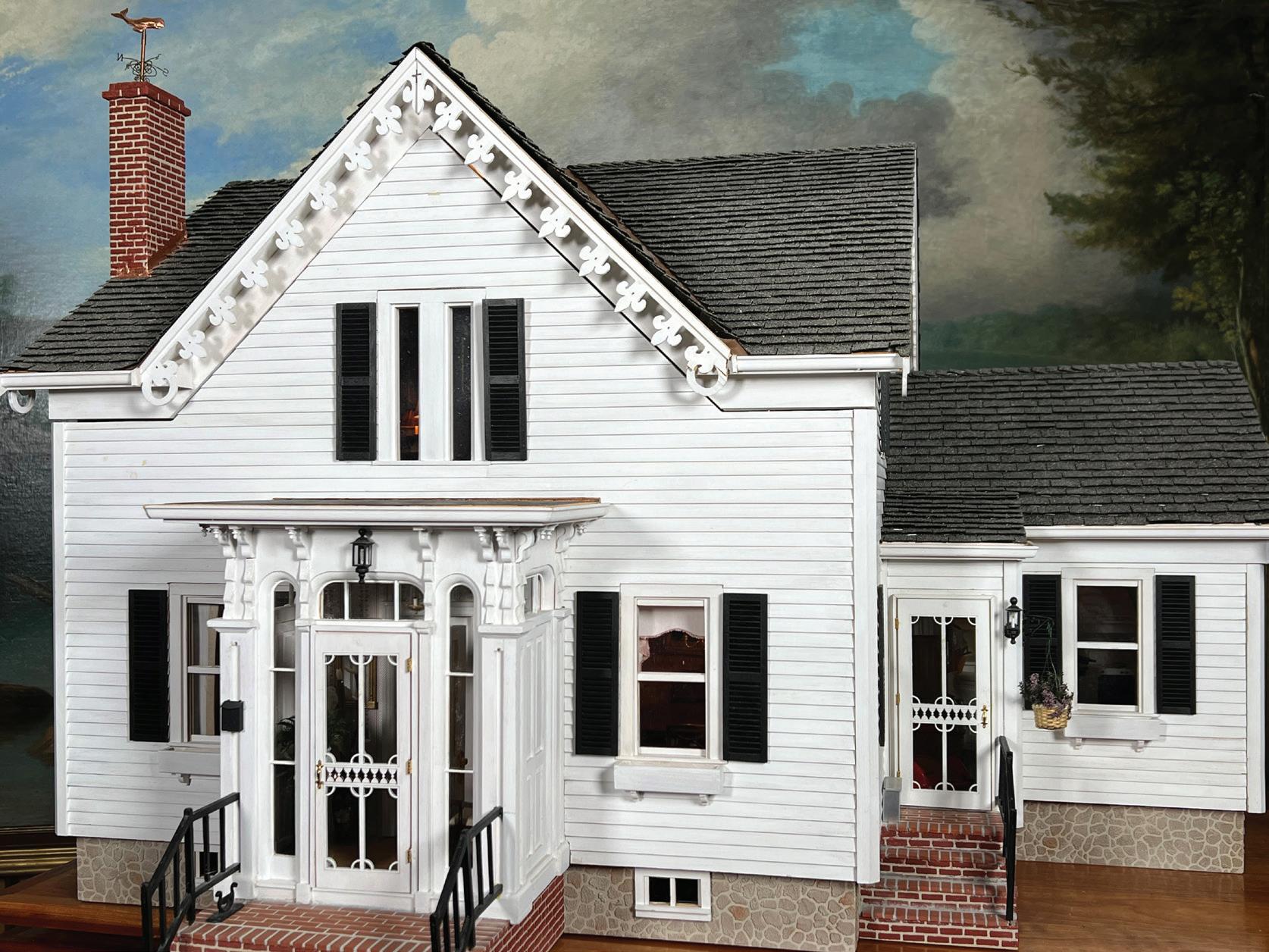
Center” in Pittsford, VT, where they specialized in miniatures. The Arnold Street House is a superb example of their work. The model is mounted on a custom-built cherry wood chest of drawers that stores many extra objects and other accoutrements, some of which are listed later in this article.2
We consider it a model versus a dollhouse, which warrants an explanation of the difference between a
2 An excerpt of the database description reads: “Custom built highly detailed modeled house of the New Bedford home of George F. Castino and Katherine MacDonald Castino, built by Fred Harvie, ca. 1985. George was grandson of Capt. John A. Castino (18301910) and Etherlinda Gage Baker (1836-1917). John A. Castino commanded three whaling voyages onboard the ships Congress and Governor Troup between 1859-1872.”
13 | Spring/Summer 2023
Fig 1. Front view of the Fred Harvie model of the house at 227 Arnold St., New Bedford. NBWM 2021.30. Gift of Mary Edwards.
miniature, a model, and a dollhouse. A miniature is any object representing a normal object but scaled down. Many examples of miniatures can be seen in this Harvie model including paintings, furniture, books, kitchen utensils, etc. Conversely, a dollhouse is generally modeled after a particular style, but the finishing and interior architecture can be radically different from any real house in order to facilitate play. For this reason, dollhouse rooms generally go either all the way or half way from the front to the back. Dollhouses come in five popular scales. Play scale (think “Barbie”) is 2 inches to the foot (2:12). Most miniaturists collect 1 inch, ½ inch, or ¼ inch. Lately, 1/144th scales have become popular.
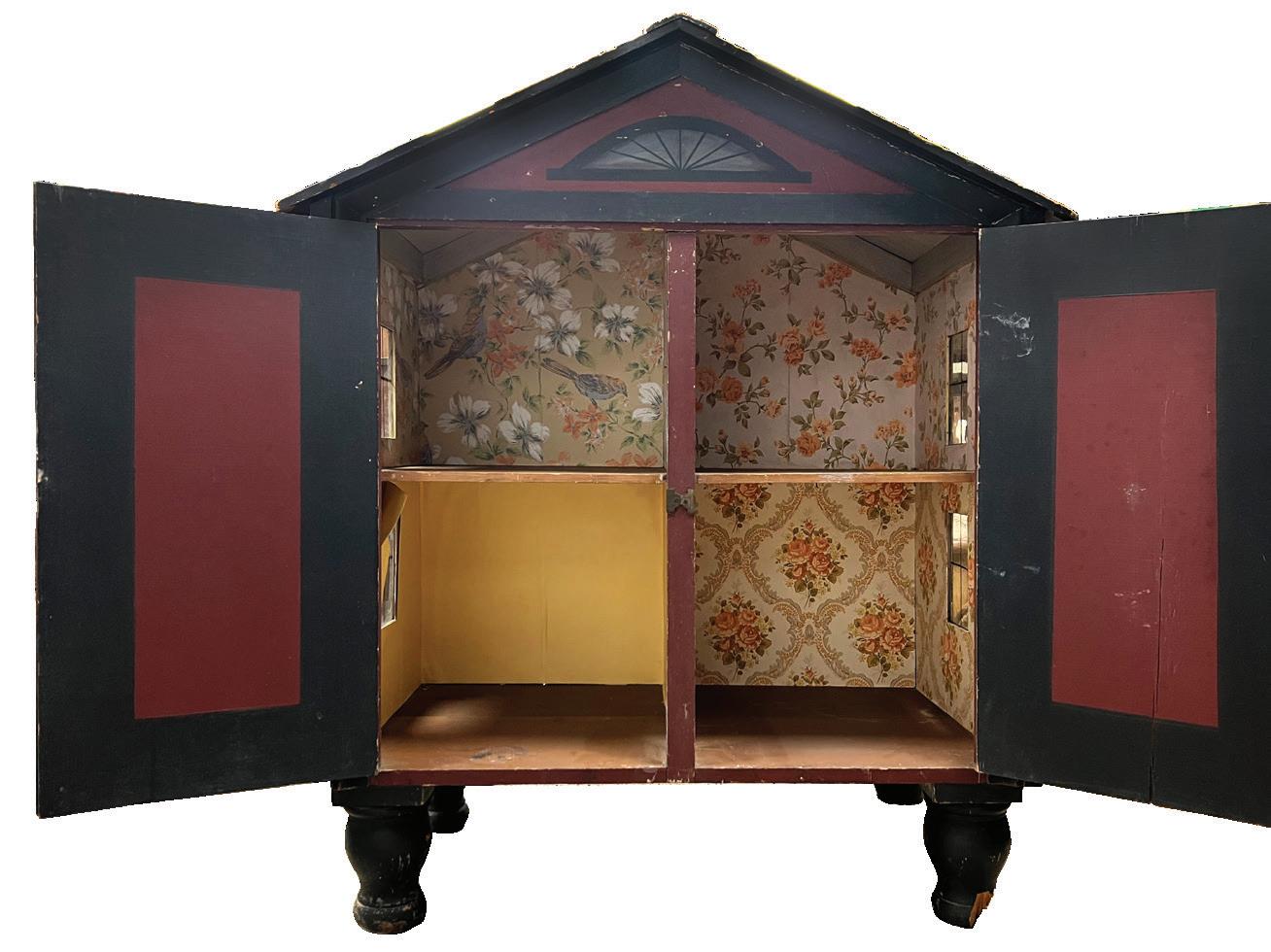
A model on the other hand tries to duplicate the architectural and decorative styles of an object. A model of a house would include interior hallways, paint colors, etc. Sometimes, as in the case of this Arnold Street house, even the furnishings are recreated. Actually, it would not be inappropriate to call a house model a dollhouse, as the term dollhouse has become somewhat generic, and in truth most models could be played with as a dollhouse. So, a model and a dollhouse can both be considered miniatures, but a dollhouse is not necessarily a model – although it can be. A central hallway points to this being a replica model of the real house instead of a simple dollhouse.
This 1:12 scale house consists of 16 rooms including:
• Front: a front porch, living room, half bath and dining room downstairs; 2 bedrooms upstairs and an attic on top.
• Side: a side porch and kitchen downstairs and an attic.
• Rear: a pantry, bathroom and study downstairs; a bedroom and a bathroom upstairs.
• A central hallway with stairs.
As model houses go this is a larger one in terms of the number of rooms, and while its overall size is impressive it’s not an excessively large model. The construction and finishing are extremely well done, although many of the artworks and furnishings are fanciful additions not meant to represent actual pieces either owned by the family or in their possession in the house.
In early October of 2021 a curatorial team went to the donor’s home, took pictures of all the rooms in the dollhouse on site, then packed up the objects for transportation to the museum. As volunteers, Marilyn and I worked diligently to clean, repair and catalog each of the small items on days when we were not busy giving highlight tours or walking the halls on busy days as docents.
A general cleaning was very important. The true beauty of the house was hidden under a layer of dust. In fact, the dust was so evenly distributed and so well
14
Fig 2. View of a nineteenth-century dollhouse. Note the limited number of rooms and their large size, twice as large as the Harvie model. The wallpaper appears to date from the late nineteenth century. NBWM, 00.49.32
stuck down to the rough roofing asphalt shingles, that everyone originally thought the shingles were grey. A good vacuuming with a special miniature brush cleaned them up so their true color could shine.
We then used the photos taken at the time of acquisition to identify where each of the items originally came from and reconfigured the rooms and their contents, as they had been at the donor’s home. Many of the small items incorporated into the room arrangements, as well as the extra pieces, are of the highest quality and most are still in superb condition. During the cataloging process repairs were done to some damaged items and the house itself. For example, we glued things like doorknobs back on, and repaired bed frames and the wind vane. The house is electrified with tape wiring, so all the lamps were checked one by one to ensure both they and all the plug sockets are operable.
Finally, we are photographing groups of items from each room for inclusion in the museum’s collection database. With these photographs, their placement can easily be determined in the future. This step makes it easier to redecorate if the items are ever removed for long term storage, or if future generations want to put it back as it was. Extra objects are photographed as a group of like objects, e.g., Christmas items, kitchen utensils, pantry items, etc.
A Description of the Downstairs Rooms
The grandfather clock in the sitting room has exquisite inlay in the body, a William Bradford reproduction painting hangs on the wall, fine quality rugs adorn the floors, and working floor lamps give the room light and warmth.
The pink dining room with matching drapes contains a fully stocked bar, cherry furnishings, and a working chandelier. High quality plates adorn the plate racks along the top of the walls. A silver punch bowl, coffee and tea set, and candelabras sit waiting on the sideboard. With the side table in back closed up to hold a silver and glass lamp it looks like the missing residents are preparing for a party.
Several of the more interesting items are displayed in the study. They include a whale cribbage board,
telescope, inlayed cabinet, sextant in a case, sailing ship model, and other knickknacks. Each of the items mentioned are of superb quality, as are the remaining furnishings in the room.
The pantry has the most items, and as such will be the most difficult to catalog. It is fully stocked with dry goods of all sorts, including a case of Coca Cola, a box of oatmeal, bag of sugar, fresh veggies just in from the garden, as well as jars of preserves on the shelves. Dishes are stored in the cupboard on the other side of the shelves. Other adornments include a water cooler, jug, cleaning supplies, and even a mouse trap.
The kitchen is very well done and includes a white porcelain stove, sink, marble table and chairs, braided rug, muffins, and everything needed to fix a scrumptious meal.
A Description of the Upstairs Rooms
The two front bedrooms appear to be decorated as adult’s rooms. Working lamps are used to bring light to these rooms that would otherwise be in shadow. The cherry furnishings, glass lamps, porcelain bowl, and fabrics are extremely well made. Pictures of nuns and someone in uniform adorn the walls. A painted chest and screen, and even shoes bring the sense of a space being lived in.
The back bedroom is the kid’s room. One of the lights in the room is a working whimsical lamp and serves its purpose. A rocking chair, bed, shelves with books, and toys decorate the room. The dolls, games, and toy soldier bring back memories of a child’s fantasy world.
The half bath downstairs contains a painted porcelain toilet with matching sink and mirror. A simple light lends elegance to the room with its painted decorations. The open white wicker shelving rounds out the room making it look larger than it is.
The upstairs full bath has gold plumbing on white porcelain fixtures. The same central light as the room below adorns the ceiling and ties the two bathrooms together. A robe hanging on the back of the door and slippers by the tub make one wonder who will come through the door next. Maybe you surprised someone and they had to run out of the room in a hurry!
15 | Spring/Summer 2023
The attics are a jumble of items like you would find in any attic, well any attic of a whaling captain. If you’re not careful you might even stub your toe (well, finger) on a case of harpoons stored up there.

There are several drawers in the cabinet with additional items. They include tools and supplies for working on the house, new plants, holiday decorations, and odds and ends that were swapped out during the change of seasons.
Future Exhibition Possibilities and Concerns
This model house presents some challenges as far as exhibition is concerned. The hundreds of little
bits that populate the rooms are fragile in their arrangements. This model would not make a suitable interactive experience on its own. Sitting as it does on a custom chest of drawers the entire ensemble is a work of art and would need to be both protected in its entirety as well as being seen that way. Two of the walls of the house itself can be opened allowing the interiors to be examined in detail. However, having the walls open increases the footprint of the model as well as stressing the wall hinges as they are open. These walls are not designed to remain open for long. Perhaps one day a suitable case will be constructed that allows for this splendid example of the miniaturist’s art to be publicly enjoyed.
16
Fig 3. Interior view of the sitting room of the Fred Harvie model of 227 Arnold St., New Bedford, MA. NBWM 2021.30. Gift of Mary Edwards.
Comets, Meteors, and UFOs in Nineteenth-Century Skies
By Mark D. Procknik, Librarian
In June 2021, the United States Office of the Director of National Intelligence issued a Preliminary Assessment on Unidentified Aerial Phenomena.1 For the first time, an official statement was shared with the public on a subject that captivated the popular imagination for generations. From an archivist’s viewpoint, this report begs the question of whether the experience of such phenomena has an historical record, and if so, could it be gleaned from the deep resources of an archive devoted to preserving the day-to-day observations of thousands 1 https://www.dni.gov/files/ODNI/documents/assessments/PrelimaryAssessment-UAP-20210625.pdf
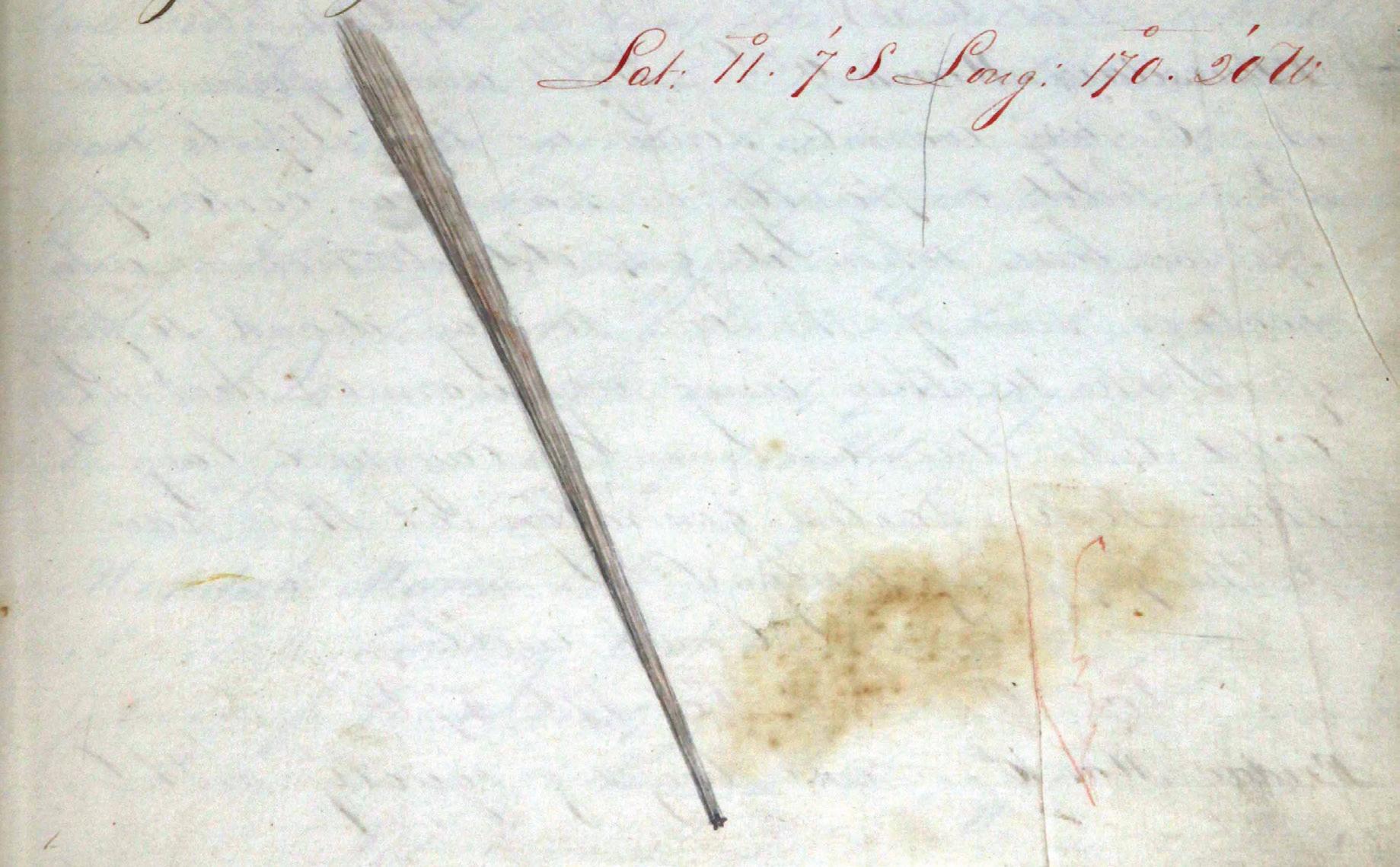
of American mariners? The logbook and journal collection of the New Bedford Whaling Museum seemed an ideal place to search.
Countless pieces of whalemen’s artwork depict anatomically correct sea mammals, accurate whaling scenes, intricate ship portraits, and precise representations of foreign ports. The keepers of whaling logbooks and journals often recounted their experiences at sea in great detail. Whalers were constantly immersed in the natural world for years at a time, so it is no surprise that some were keen observers and accurate reporters of their experiences.
17 | Spring/Summer 2023
Book Talk
Fig. 1. John F. Martin, “Great Comet,” c. 1843. NBWM, KWM 434. Martin drew this picture in his journal kept onboard the ship Lucy Ann of Wilmington, DE, in March 1843.
They were also no strangers to the night skies, as a correct observation of the stars was fundamental to navigation. Captains and officers regularly turned their gaze towards the heavens, and logbooks and journals sometimes record unusual occurrences in the night sky. Examples include comets, meteors, lunar eclipses, planetary movement, and shooting stars. As a result, the Museum’s logbook and journal collection offers a unique repository of nineteenth-century celestial observations ranging from historically renowned comets to unidentified objects that seemingly defy explanation.
For over 150 years, the Great Comet of 1843 held the distinction of the longest known cometary tail and is one of history’s most well-documented nineteenth-century comet sightings. Due to its brightness and the length of its tail, many written and pictorial accounts exist, including sightings in China describing it as “broom-star,” the Australian Anglican Bishop, William Grant Broughton (1788 -1853), describing it as a “remarkable spectacle,” and additional accounts noting that the comet’s dramatic appearance “produced great alarm” and caused “widespread panic.” Charles W. Austin of the ship Charles Phelps of Stonington, Connecticut, for instance, recorded a sighting of the comet in his entry for March 5, 1843 (ODHS 899), while cruising in the South Pacific Ocean. Austin wrote that the comet’s tail “came down to the horizon and extended far into the Heavens in such a way all of the men said that they never saw before.” Comet sightings were nothing unusual for whalers, but the brightness, magnitude, and length of this particular comet no doubt presented whalers onboard the Charles Phelps with a unique view to a comet that according to modern astronomers will not reappear in the Earth’s skies until at least the year 2443 due to its 600 to 800-year orbital period.
Some whalers, not content to simply write about celestial bodies, also illustrated what they witnessed. While onboard the ship Lucy Ann of Wilmington, Delaware, in 1843 (KWM 434), John Martin wrote of the same comet Austin encountered onboard the Charles Phelps and described its tail stretching “from the horizon to almost directly overhead.” A gifted artist whose journal includes several brilliant watercolors of
whales, whaling scenes, wildlife, and distant shores, Martin not only included multiple entries about the comet in March 1843, but included two watercolor illustrations showing the comet and its historic tail. In the absence of photography, Martin’s journal illustrations, along with nineteenth-century paintings by Australian artist Mary Morton Allport (18061895) and Scottish astronomer Charles Piazzi Smyth (1819-1900), endure as visual representations of the comet and provide valuable historical documentation for modern day astronomers.
History’s notable comets were not the only illuminated objects that captured the minds and attention of whalers. Logbooks and journals document predictable phenomena such as meteors, shooting stars, eclipses, and planets. However, at least one whaleman’s observation describes an object that defies astronomical explanation. Robert Joy, captain of the ship Roman’s 1835 to 1839 voyage out of New Bedford (NBW 1378), pens one of the most notable period celestial sightings in the entire collection. Cruising in the Pacific Ocean near Hawaii on April 12, 1837, Captain Joy observes a “remarkable meteor” visible in the night sky for ten to twelve minutes. Joy describes the object as very bright, noting that it “illuminated the ship more than two full moons would” and writes that some of the men and officers on duty could feel heat emanating from the object. What makes Joy’s account so remarkable is that this meteor does not move in a straight line like a meteor would or should. According to Captain Joy, this meteor witnessed by his entire crew “zig-zagged” through the night sky and “made one complete round turn in its course.” This is obviously atypical behavior for natural objects like meteors or meteoroids, commonly called “shooting stars,” that have entered the Earth’s atmosphere moving in a straight-line trajectory.
What was it, then, that Captain Joy reported and what his crew witnessed? With little apart from Joy’s observations to analyze, it sounds like neither a meteor nor any other object intrinsic in nature. Captain Joy only described it as “a remarkable meteor” as that was the best he could do given his (granted great) knowledge of naturally occurring celestial objects. Whalers would often observe something unusual in
18
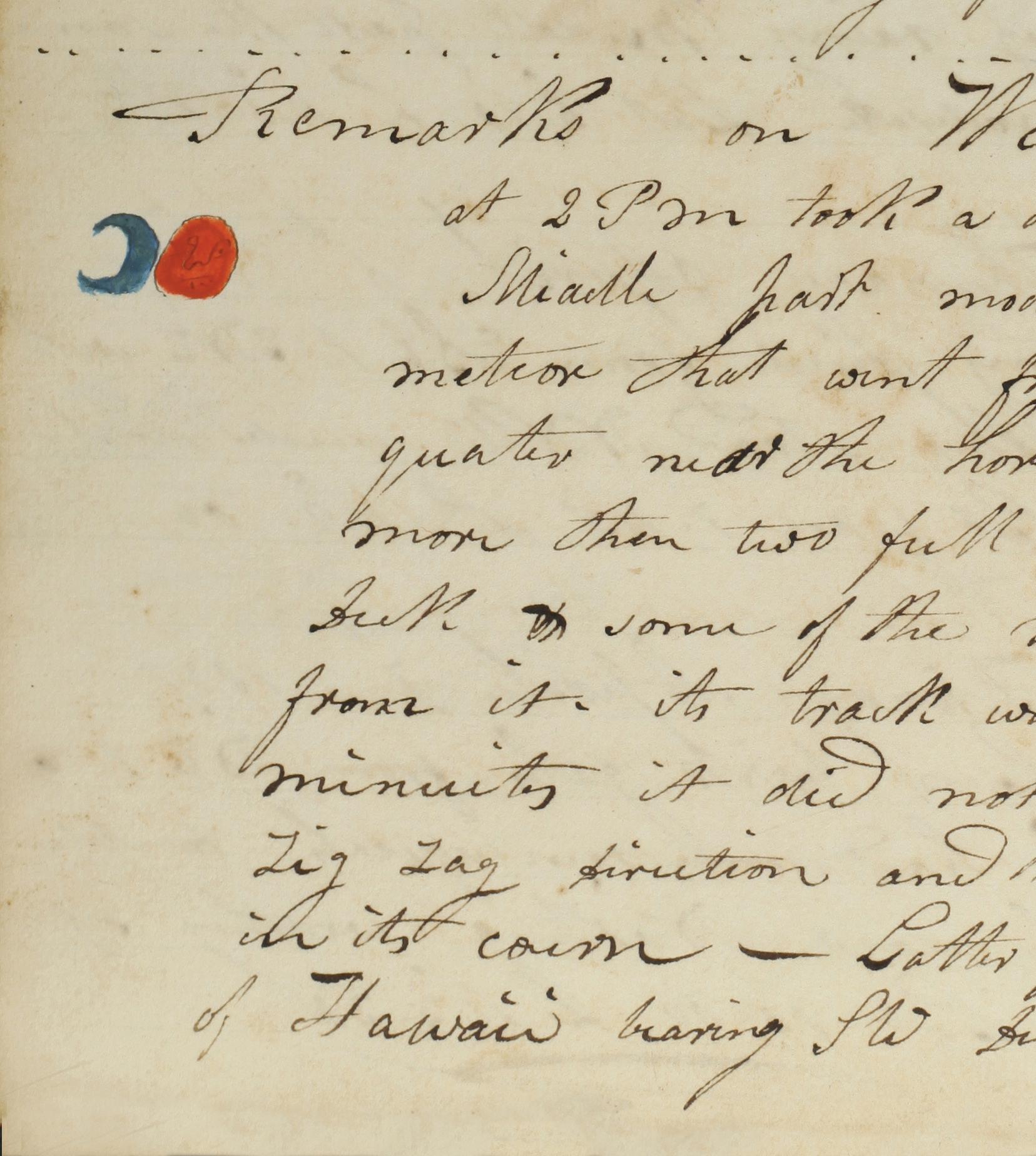
19 | Spring/Summer 2023
Fig. 2. Section of text dated Wednesday, April 12, 1837 from Captain Robert Joy’s journal kept onboard the ship Roman of New Bedford, MA, 1835-1839 on a sperm whaling cruise to the Pacific Ocean. NBWM, NBW 1378.
the sky and frame their descriptions in terms they were familiar with and understood. This would occasionally result in descriptions of a “fiery meteor lighting up the night as if it were midday,” a “blazing planet,” or a “blazing star” that “hovered” in the sky. The “remarkable meteor” that zig-zagged, turned, and maneuvered its way through the Pacific skies in
1837 will likely remain unidentified, forever marking this April 1837 entry as a whaling captain’s credible account of a nineteenth-century unidentified flying object.
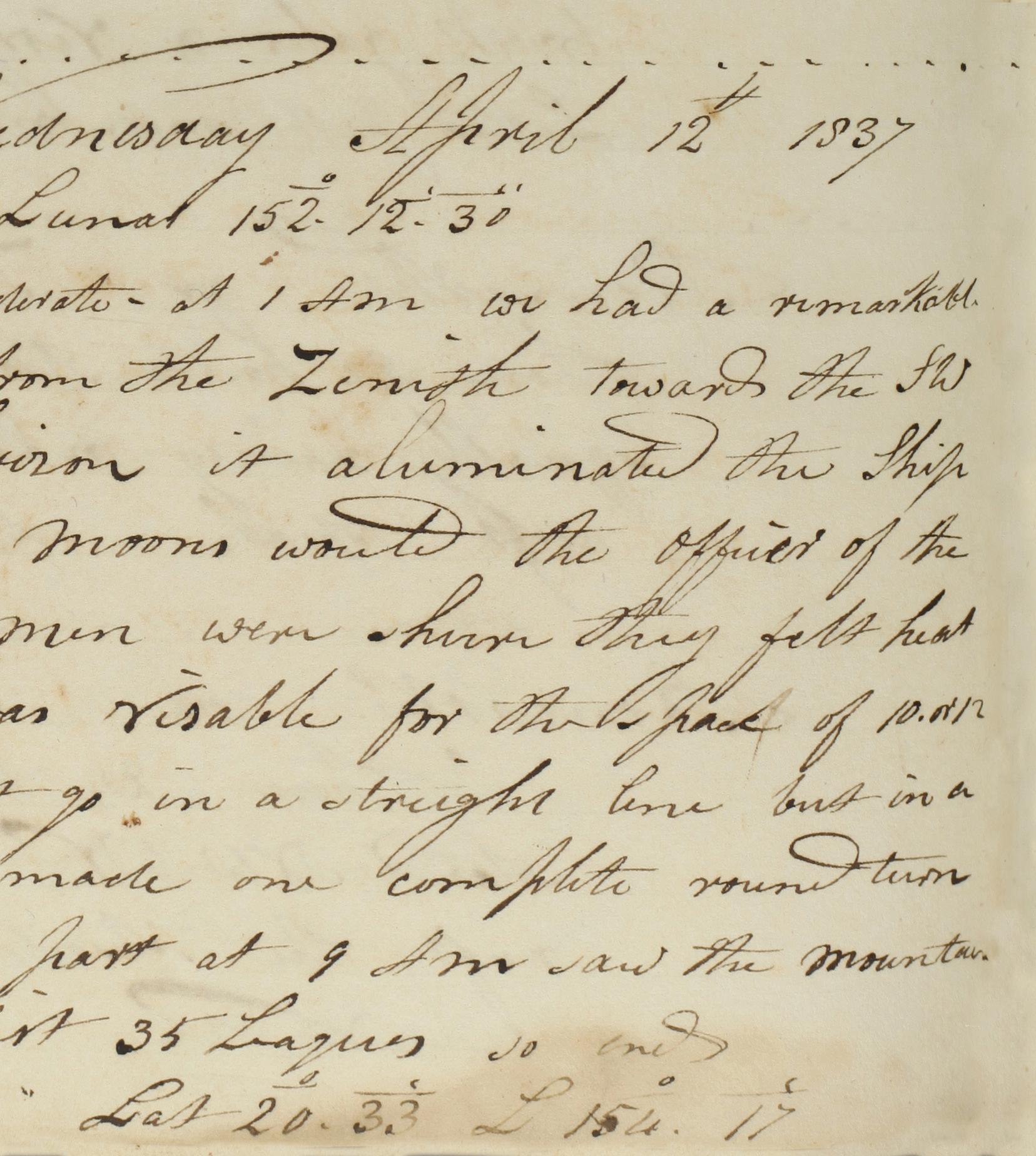
20
Sharing Our Local History
A Metaphor in Dartmouth: DHAS
and its Quaker Transcription Project
By Sally Aldrich, Robert J. Barboza, Richard W. Gifford, Robert E. Harding, Andrea Marcovici, and Marian Ryall of the Dartmouth Historical and Arts Society, Inc.

“The absolute truth is that happiness really comes from within, when we can be content with what we have and are doing in the present.”
Dan Socha, The Seeker and the Owl: Of Truth and Wisdom (Kindle edition, 2018).
Tales of Mighty Mouse, an “ordinary mouse with extraordinary powers,” emerge metaphorically as the Dartmouth Historical and Arts Society, Inc., known locally as “DHAS,” steps into the publishing realm of serious scholarship as a partner with the Colonial Society of Massachusetts in the new two-volume set The Minutes of the Dartmouth Monthly Meeting of Friends, 1699-1785, Thomas D. Hamm, ed., Publications of the Colonial Society of Massachusetts, Vol. XCVIII (Boston, 2022).
Noted historian John W. Tyler, long term Editor of Publications for the Colonial Society of Massachusetts, worked with DHAS on their recent publication of the Quaker records of Dartmouth and commented in a recent issue of the CSM Newsletter that “These volumes are a cooperative venture with the Dartmouth Historical and Arts Society, an extremely ambitious and active local historical organization.”1 Founded in 2011, the DHAS mission statement concisely explains the motivation driving its ambitions: “To preserve, promote, and disseminate the historic and cultural diversity of Dartmouth, Massachusetts.”
In pursuit of this mission DHAS has set out to secure primary records, preserve them, and make
1 John W. Tyler, “A Brief Report on Publications,” in CSM Newsletter ; Volume 27, Number 1 (September 2022).
them accessible for researchers and genealogists. DHAS often describes its website, as a “researchers’ workbench.” Many primary record sets are uniquely available on the website including:
(1) Town Meeting records of the old township of Dartmouth, 1674-1787
(2) The Bristol County Land Record Abstracts of Dan Taber
(3) Records of the Dartmouth Monthly Meeting of Friends2
2 Quality checking the last 5% of the 6,000 pages is still in process but will be finished shortly. This collection of primary source records for the Dartmouth Monthly Meeting are held in the Special Collections of the UMass Dartmouth Libraries, http://findingaids.library.umass. edu/ead/mums902-d378
21 | Spring/Summer 2023
Fig. 1. Quaker Meetings in the Old Dartmouth region.
The Dartmouth Quaker record begins in late 1698 and early 1699 when the Dartmouth Monthly Meeting was “set off” from the Rhode Island Friends Monthly Meeting. Located on the western edge of Plymouth Colony and an equally remote border with settled Rhode Island, the “Old Dartmouth” region was a convenient refuge for Native Americans, freed Blacks, and religious dissidents.3 The region became a refuge for many Quakers who, being viewed as deviants from orthodoxy, were commonly mistreated and generally unwelcome elsewhere in Plymouth Colony and the Puritan Massachusetts Bay. The Friends became a majority population of colonial Old Dartmouth and remained so for many years.
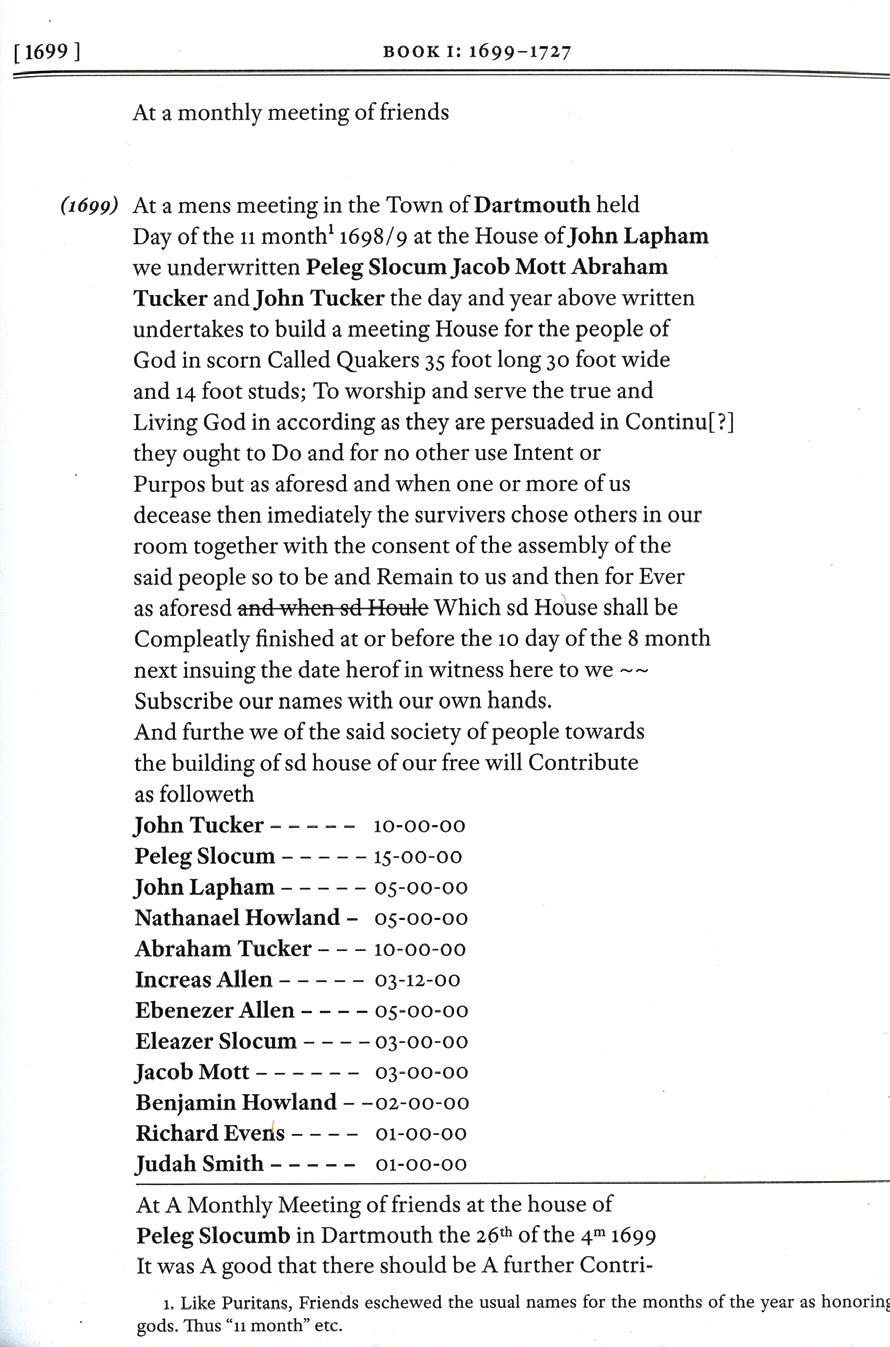
One feature of Quakerism, enforced from its earliest days, was the requirement to have Monthly Meetings for business which, while not “worship meetings,”
were worshipful and, significantly, were required to keep written minutes. These minutes were (and still are) kept in journals which were preserved, dated, and certified by the Clerk of the Meeting. The Dartmouth Monthly Meeting (DMM) recorded monthly minutes from “11th month 1698” forward. A large collection of journals resulted with their roots in the seventeenth-century Old Dartmouth colonial experience. These journals were variously named Men’s Minutes, Women’s Minutes, and Combined Minutes reflecting the fact that for a time only men met in the Men’s Meeting, women in the Women’s Meeting, and later in the mid-nineteenth century, the two met together in the Combined Meeting. Other types of records were journalized and preserved by the DMM as well. These included Journals of Births, Marriages and Deaths, Book of Discipline (Rules for Faith and Practice), and Book of Removals (documenting the permanent or temporary transiency of Friends between Meetings in other geographical settings).

22
3 John W. Tyler, “Foreword,” in The Minutes of the Dartmouth, Massachusetts Monthly Meeting of Friends 1699-1785, ed. Thomas D. Hamm (Boston, 2022), xi.
Fig. 2. Select pages from The Minutes of the Dartmouth (MA) Monthly Meeting of Friends, 1699-1785 showing original 1699 manuscript and transcription text. “Dartmouth Monthly Meeting of Friends Records,” Image courtesy of Smith’s Neck Meeting.
These archival materials are highly significant, and quickly became an area of focus for the efforts of DHAS. To execute the publication of The Minutes of the Dartmouth Monthly Meeting of Friends, 16991785, the original minutes had to be digitized and then transcribed. DHAS played a pivotal role in this effort, thanks to the support of Marcia Cornell Glynn and Russell Cornell, Katherine Plant, Robert E. Harding, and The Monthly Meeting. The latter became aware of the need to find another way by which these fragile, environmentally sensitive records might be consulted, settling on digitization as the best path forward and granting the DHAS permission to undertake the project. DHAS leaders Bob Harding and Dan Socha and advisor Jane Fletcher Fiske tackled the transcription and digitization project. The now-completed DHAS Quaker Transcription Project consumed several years of work from a dedicated management team, volunteers (both members and friends of DHAS), and two commercial transcription companies. It produced an accessible and valuable mine of detailed information about the Dartmouth
“Friends,” as Quakers are commonly known, and provided the foundation for this recent two-volume publication.
The Dartmouth Quaker records have special value to genealogists and historians because they are primary sources, recorded at the time the events occurred by reliable clerks of the DMM. These types of records provide multiple opportunities to ensure the correct spelling of names and details of most of the incidents chronicled, because of the Friends’ particular custom of patiently repeating issues and waiting for general acceptance by the whole meeting. All the minutes are dated, thus placing them accurately within a timeline, and the Quaker requirement for “certificates of removal” when individuals or families moved from the jurisdiction of one monthly meeting to another (whether for marriage, visiting, preaching, or permanent relocation) yields very detailed information about patterns of geographic migration, since they specify locations, people, and specific times.

23 | Spring/Summer 2023
Fig. 3 Manuel Goulart (Azorean-American, 1866-1946). View of Apponegansett Meeting House, South Dartmouth, 1933. Image printed from a glass plate negative. NBWM, 1993.48.18.95.
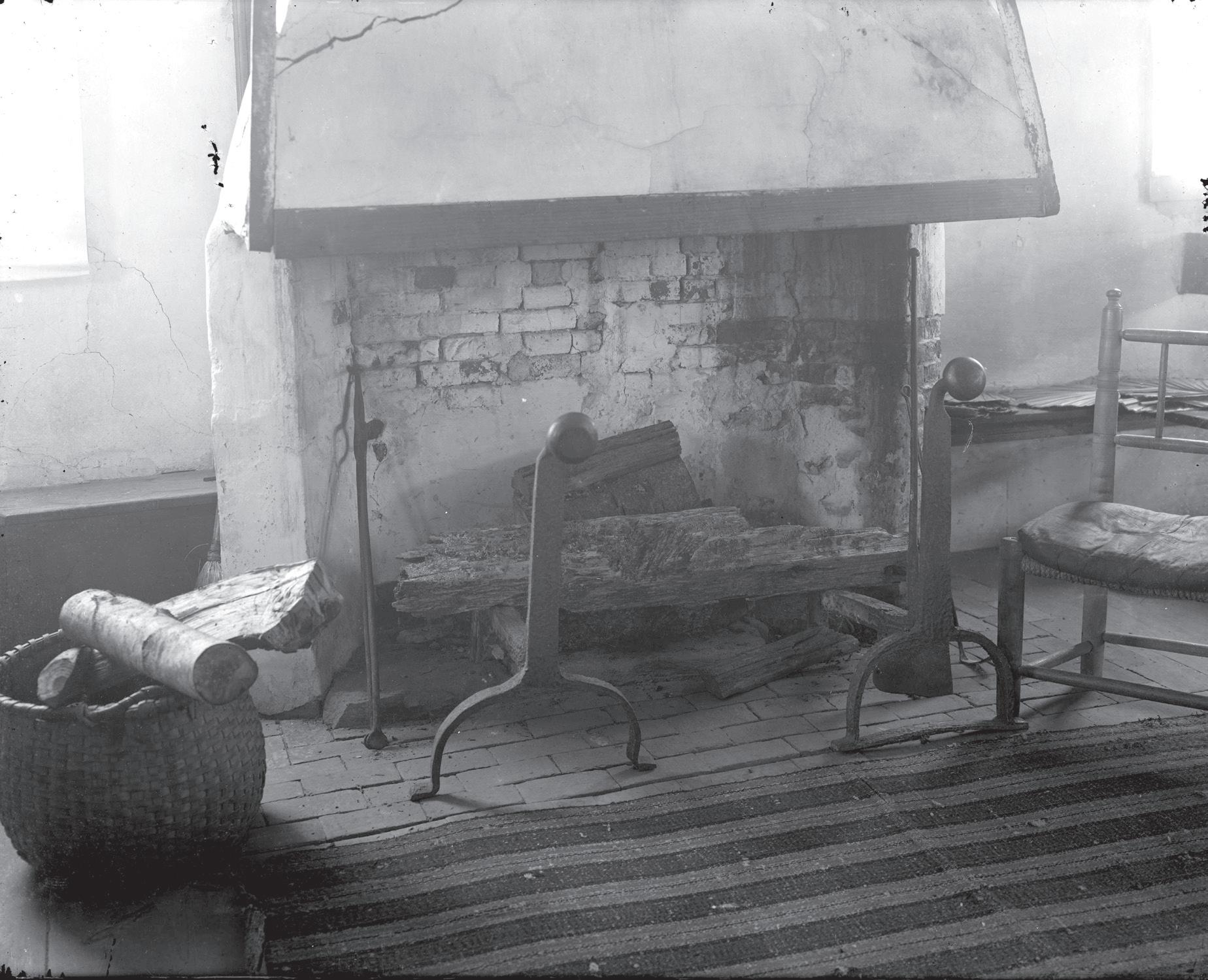
24
Fig. 4. Joseph G. Tirrell (American, 1840-1907). Fireplace at the Apponegansett Meeting House, circa 1880. Image derived from a glass plate negative. Built in 1799 on the site of the original 1699 Meeting House, this structure has two fireplaces, one at each end of the building for the comfort of the separate women’s and men’s meetings. NBWM, 2000.100.85.353.
Picturing Pilot Whales, from George Hathaway Nickerson to Daniel Ranalli
By Marina Dawn Wells, Photography Collection Curatorial Fellow
“
Amid the torrent of whale strandings in the 2020s, it is painful to imagine a time when such events were sought out and glorified. Many of the NBWM’s paintings, prints, photographs, postcards, and advertisements actually celebrate the oft-overlooked history of pilot whales dying along Atlantic shores.
Blackfish," now known as long-finned pilot whales (Globicephala melaena), swim along New England’s coast, while short-finned pilot whales (Globicephala macrorhynchus) make their homes farther south. These small cetaceans were easier to capture than larger species, and oil manufacturers valued their smooth, spermaceti-like oil. In the late nineteenth

25 | Spring/Summer 2023
From
Our Fellows
Fig. 1. Cape Cod Post Card Co. after George Hathaway Nickerson, “Blackfish Driven Ashore,” 1939. Postcard, 3.5 x 5.5 inches, NBWM #2000.101.173.
century, long-finned pilot whales were also captured through a photographic lens. From professional pictures in the 1870s to point-and-shoot snapshots of the 1900s, people have often looked at dying pilot whales with positive interest. Today, artists and activists grapple with how to depict pilot whales, whose visual representations have gathered different meanings over time––as demonstrated by the 2023 exhibition of multimedia works by Daniel Ranalli (b. 1946) at the New Bedford Whaling Museum. Ranalli’s artwork laments whale strandings (including deliberate hunts of pilot whales) and builds upon the ambivalence of historical imagery toward human-animal relations.
Only 150 years ago, people killed massive numbers of pilot whales, responding to demands for watch and chronometer lubricants. Manufacturers like Ezra Kelly and William Nye of New Bedford and David C. Stull of Provincetown made their fortunes from jaw oil and what they called “melon” oil from the pilot whale’s head, where the animal carries an oleaginous organ that avoids coagulating in cold temperatures. Some killed the whales systematically alongside other species during offshore whaling voyages. Others took advantage of schools that swam close to shore, embarking in small craft to violently herd the animals onto the beach with harpoons and bare hands. It was likely in 1874 that professional photographer George Hathaway Nickerson (1836-1890) climbed into a boat in Provincetown to chase a pilot whale school that had entered Cape Cod Bay. As the Provincetown Advocate wrote, Nickerson was one of about three hundred “clerks, printers, clergymen, veteran whalers, shipmasters, and photographers all participating in the fracas and all coming in for a portion of the proceeds.”1 Clearly, such news excited hopes to profit from the animals. The community also scrambled to see the sheer spectacle created by the hunt. Given this visual interest, the photographs Nickerson snapped would live on long after the whales died of dehydration on the beach.
In the years that followed, Nickerson’s images of pilot whales sold as stereocards, postcards, and even
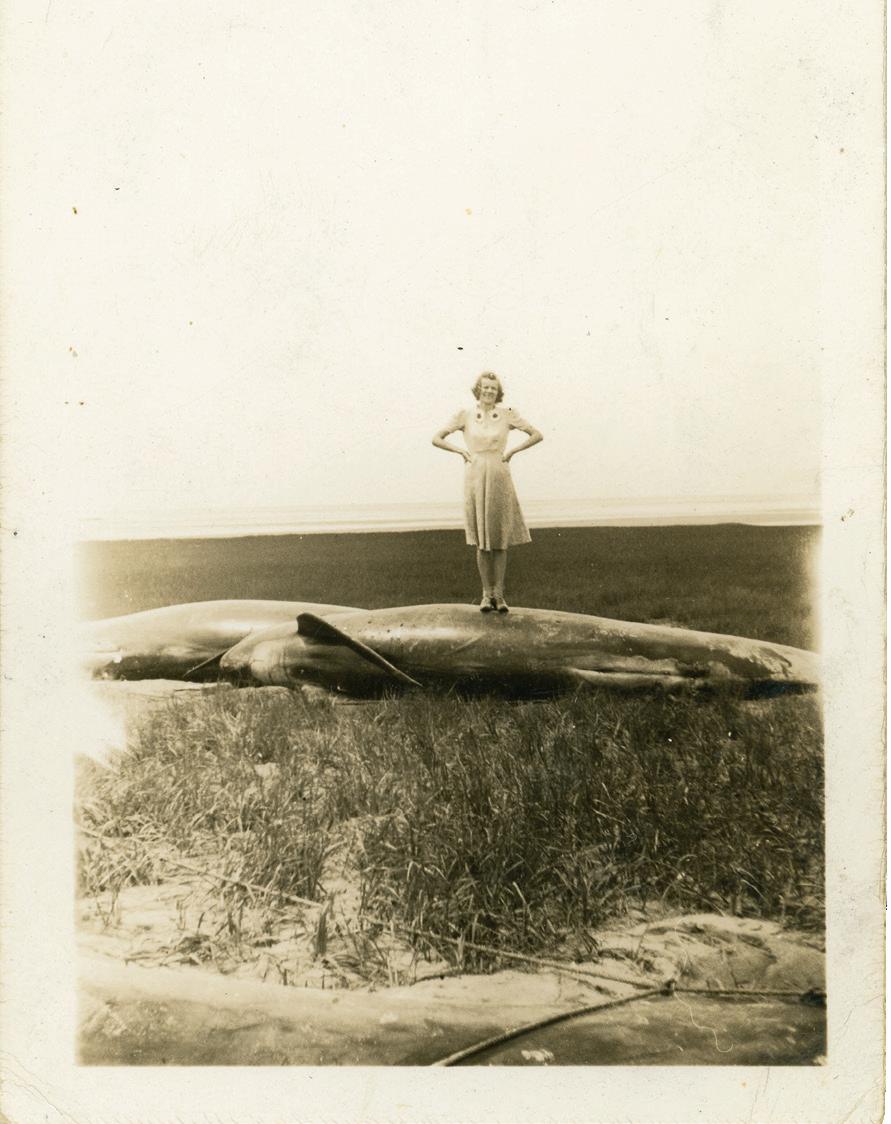
1 Provincetown Advocate (December 24, 1874); quoted by G. Brown Goode, The Blackfish and Porpoise Fisheries, from The Fisheries and Fishery Industries of the United States V I and II (Washington, D.C., 1884), 304.
advertisements for oil manufacturers. These photos and others like them appeared repeatedly in the northeast, even after the turn of the century when the dominant Nye oil company moved its “fishery” to Hatteras Island.2 Postcards burgeoned in popularity as towns on the outer Cape shifted their economies away from fishing and toward tourism. As the deliberate stranding events fell further into the past, these pieces of visual culture captured a quaintness that was useful for the area’s image. Postcards were even accompanied by references to the tip of the Cape as the “First Landing Place of the Pilgrims,” trading in Colonial Revival-era historical nostalgia. As advertisements, such images also explicitly promoted oil manufacturers like Nye and Stull, acting as origin stories for their company’s products. On the back of these morbid pictures, visitors penned lighthearted messages to friends and family, as one did in 1939: “What an old fashioned town.”3
2 David S. Cecelski,
Clock Oil and the Bottlenose Dolphin Fishery at Hatteras Island, North Carolina, in the Early Twentieth Century,” The North Carolina Historical Review 92, no. 1 (January 2015): 49-79; Ed Parr, The Last American Whale-Oil Company: A History of Nye Lubricants, Inc., 1844–1994 (Fairhaven, MA: Nye Lubricants, Inc., 1996).
Time and the Sea:
26
“Of
Nye’s
3 NBWM #2000.101.173.
Fig. 2. Maker once known, “Woman with pilot whale,” 1945. Gelatin silver print, 2.5 x 3.5 inches, NBWM #2016.2.1.
Into the mid-twentieth century, blackfish strandings continued (as they continue today), and the practice of photographing them continued as well. Building on postcard imagery, anyone with a camera could now capture these scenes for personal amusement. In one 1940s photograph, a woman stands with a proud stance on top of a pilot whale body (Figure 2). The whale she stands on was less likely to be urgently commodified for oil than its predecessors; however, by making a photo like this, she rendered its body into entertainment. Such snapshots continued the legacy of celebrating whale death, rather than responding to it with grief.
Nye Lubricants continued producing porpoise oil as long as it lawfully could into the 1970s. In a photograph from that time, Black workers and families stand on the beach on the island of St. Vincent and the Grenadines, where Nye outsourced their operation. The unknown photographer followed others, like

Albert Cook Church (1880-1965) and Clifford W. Ashely (1881-1947), who documented American pelagic whaling with anticipatory nostalgia. In this scene, well-dressed women and a dog look on as men in minimal clothing work on pilot whale bodies that lay in pieces on the ground. This perspective immerses the viewer in the gory process of rendering life into death, in the years that the industry itself also approached its own end.
With these scenes now decades in the past, contemporary artwork provokes further questions about how to picture pilot whale strandings, even in a culture with ostensibly changed sensibilities. In Whale Stranding, an ongoing series inspired by the firsthand experience of a stranding event, Daniel Ranalli creates work that extends to sculptural and conceptual forms. Pieces like 1405 Whales (1997) contrast the explicit photographic depictions of whale bodies examined thus far (Figure 4). In fact, 1405 Whales refers to the
27 | Spring/Summer 2023
Fig. 3. Maker once known, “Men working on blackfish for Nye Oil on St. Vincent and the Grenadines,” c. 1968-1972. Negative, 4 x 5 inches, NBWM #39080.
same stranding event that likely resulted in Nickerson’s original photographs in 1874. While Ranalli and Nickerson both emphasized the abundance of bodies, Ranalli renders the whales as stylized figures. His stamps represent whale deaths, referring to nineteenthcentury whalemen’s documentation in logbooks. Although the marks are dynamic with alternating colors and angles, many look faded as if inked with a tired hand. Additionally, unnamed bone fragments pile into a window below the collection of stamps, representing the tangible but anonymous bodies lost in such an event. Ranalli’s depictions unsettle the viewer, given the contradictory affects the same event could generate. They seem to alienate the positive excitement experienced by people in the past, to instead highlight horror for contemporary viewers.
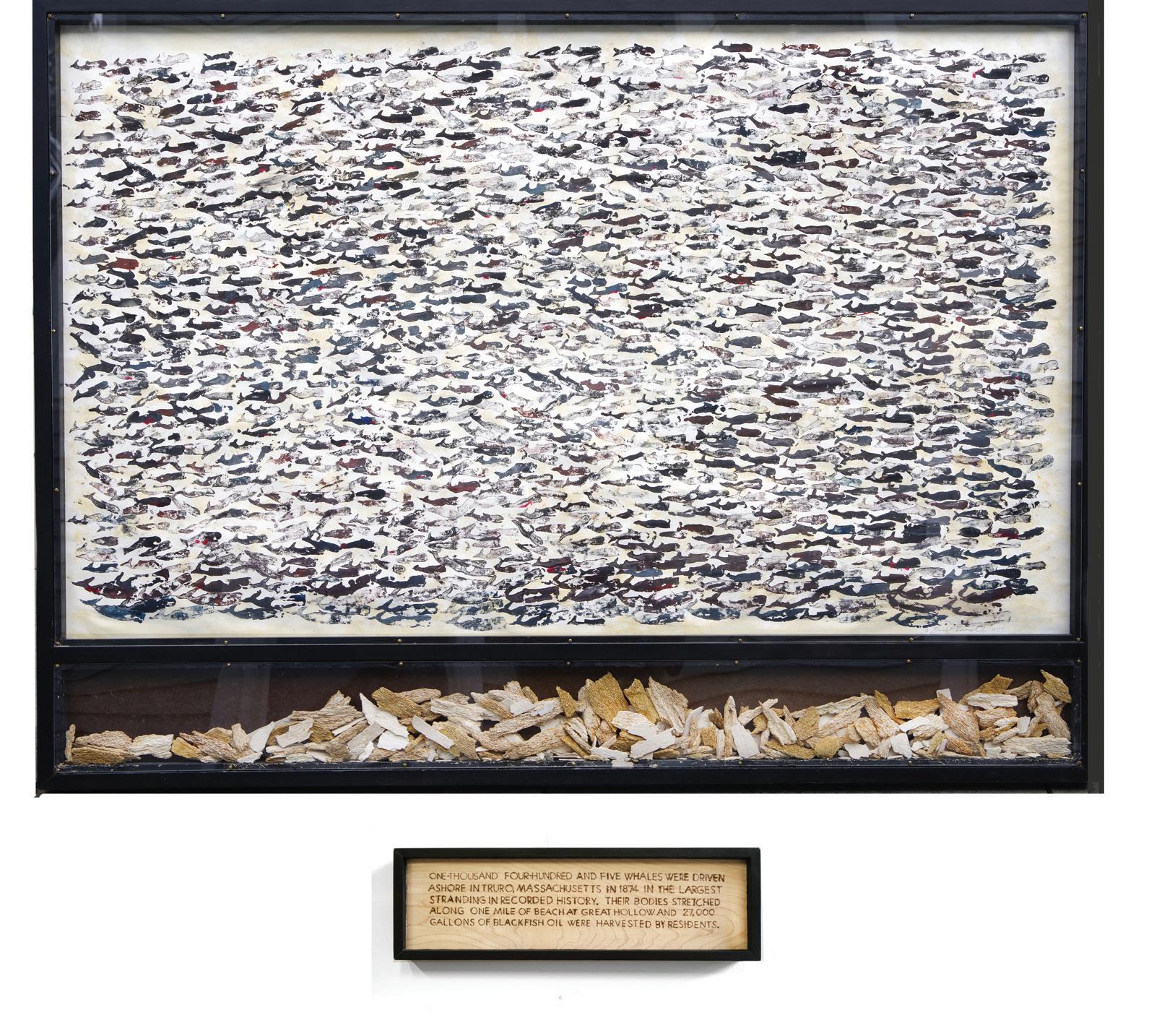
From Nickerson to Ranalli, every image of a whale––alive, dead, or dying––initiates a relationship between viewer and viewed, killer and killed. Ranalli’s work calls
attention to the systematic whaling of the nineteenth century through its whale stamps, the bones of animals on the beach, and by implicating historic actors both past and present. As Ranalli’s work suggests, humans have long participated in these tragedies, whether by causing them, recording them, or bearing complicit witness to them. Thankfully, prevailing sentiments have changed alongside protective laws mandating that whales not be killed––particularly with intent. However, as whale deaths become more visible in the twenty-first century, we should continue to feel their weight rather than become habituated to them. Every story and picture of a new mortality event requires that we resist returning to a recent past, when dead whales provoked pleasurable awe, spectatorship, or even celebration as they breathed their last breaths on the beach.
28
Fig. 4. Daniel Ranalli (b. 1946), 1405 Whales, 1997. Unique block print on rag paper with bone fragments in artist’s frame & woodburned text panel, 38 x 49 inches, collection of the artist.
Paper Money and the “Free Banking Era” of 1837-1862: The NBWM Paper Currency Collection
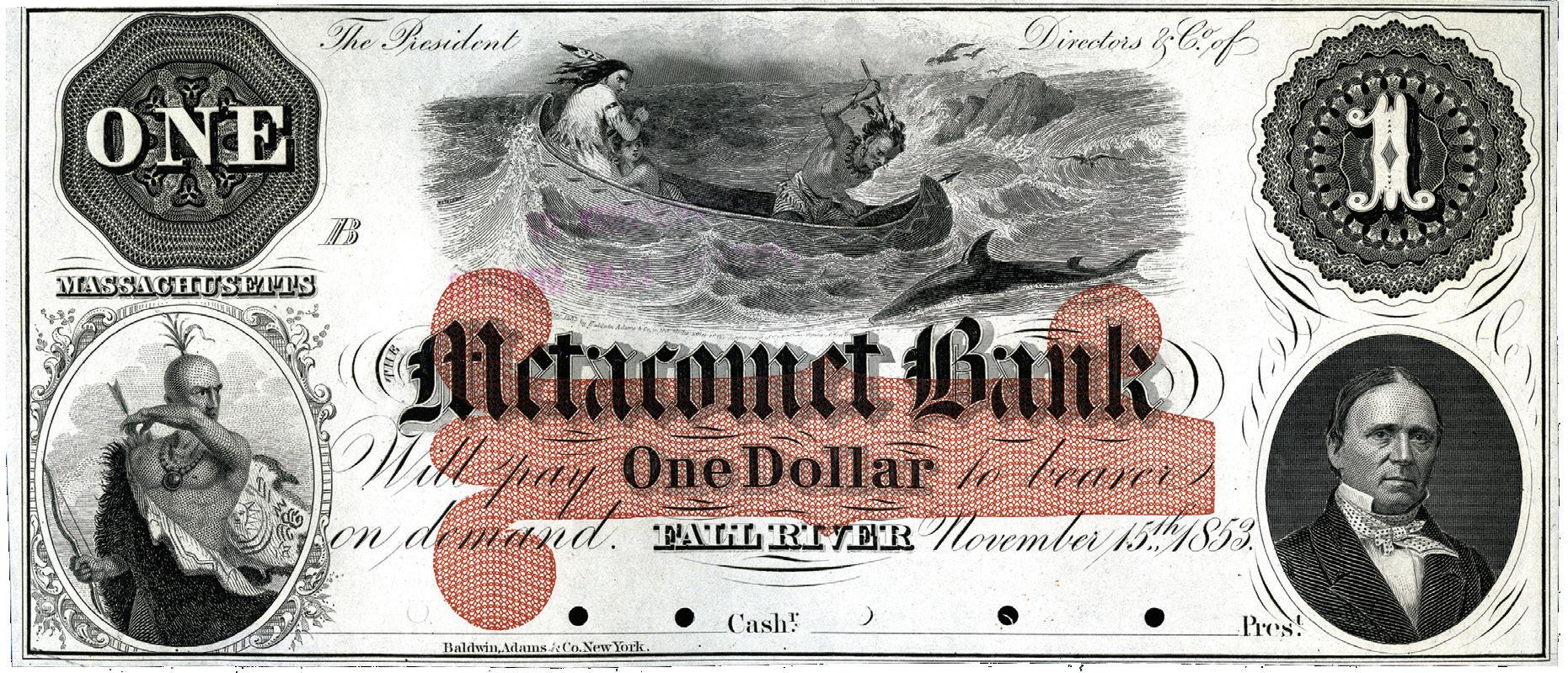 By Aidan Goddu, Undergraduate Curatorial Intern, New Bedford Whaling Museum
By Aidan Goddu, Undergraduate Curatorial Intern, New Bedford Whaling Museum
For much of the history of the United States, questions surrounding the function of the central financial institution of the country, its role, power(s), and responsibilities surrounding monetary policy have been common. The first National Bank of the United States was a politically contentious issue, and after twenty years, its charter was not renewed upon its original expiration in 1811. Supporters of the first National Bank would eventually avenge its fall by chartering a second. Both the first and second national banks performed many functions that were similar to commercial banks during the period, but they also functioned to more easily facilitate the payment of taxes and as a receiver of deposit from the federal government. Opponents of the national bank would once again prove victorious when President Andrew Jackson vetoed the renewal of its charter.
Once the charter of the 2nd National Bank expired in 1836, the country was once again without a central
financial institution, leaving only state-chartered banks to fill the gaps. These types of banks had existed for over fifty years at this point, with the first of these – The Bank of North America – being chartered in Philadelphia, PA on December 31, 1781. Statechartered banks would issue currency for circulation in their local area with little government oversight until the introduction of the National Banking Act in 1863 brought about the eventual demise of the state-chartered banking systems in favor of national charters.
Across the nation as a whole, the “Free Banking” period was one of general insecurity in the financial institutions present in the country. Under the system, many poorly managed and unstable banks issued currency that would be rendered valueless once the issuing bank went under. Notes that were traded a sufficient distance away were traded at a discount of their par value, reflecting the travel costs of redemption as well as the risk of default by the issuing bank.
29 | Spring/Summer 2023
Fig. 1. One Dollar banknote issued by the Metacomet Bank of Fall River, November 15, 1853. 3 x 7 inches, NBWM, 2002.59.35. Gift of the Kendall Whaling Museum Trust.
Despite the general trends of insecurity and the declining value of notes further away from their banks of issue, in New England state-chartered banks proved to be more resilient, partly due to the Suffolk System. The Suffolk system, named after the Suffolk Bank of Boston, operated by having each member bank maintain a reserve deposit in the Suffolk Bank (or other participating Boston bank), with the Suffolk Bank then accepting and clearing all banknotes issued by the members of the system at par value.
State-chartered banknotes in the collection: The Museum preserves many notes from several state-chartered banks, principally from the local SouthCoast area. Many of the designs are common among different banks since banks would order notes from the same suppliers and engravers. These notes have various artistic motifs, from whaling and farming to classical American depictions of Liberty personified.
Notes in our collection issued from regional banks include:
• The Fall River Bank (Fall River)
• The Metacomet Bank (Fall River)
• The Marine Bank (New Bedford)
• The Bedford Commercial Bank (New Bedford)
• The Merchants Bank (New Bedford)
• The Mechanics Bank (New Bedford)
• The Fairhaven Bank (Fairhaven)
In addition to these local notes, the museum also possesses various notes issued from state-chartered banks in Massachusetts, Rhode Island, Connecticut, and several other states, with a particular focus on the Northeast. Many of these, including notes from the Whaling Bank of New London, the Commercial Bank of Perth Amboy, NJ, and the Suffolk County Bank of Sag Harbor, NY, were collected specifically for their whaling imagery. Banks represented in this part of the collection include:
• Manufacturers & Mechanics Bank (Nantucket, MA)
• The Citizens Bank (Nantucket, MA)
• Phoenix Bank (Nantucket, MA)
• Nantucket Bank (Nantucket, MA)
• The Warren Bank (South Danvers, MA)
• The Broadway Bank (Boston, MA)
• The East Bridgewater Bank (East Bridgewater, MA)
• The Leicester Bank (Leicester, MA)
• The Dorchester & Milton Bank (Dorchester, MA)
• The Marblehead Bank (Marblehead, MA)
• Washington Bank (Boston, MA)
• Bank of Rhode Island (Newport, RI)
• Mount Vernon Bank (Providence, RI)
• The Farmers and Mechanics Bank (Pawtucket, RI)
• The Washington Bank (Westerly, RI)
• The Franklin Bank (Chepachet, RI)
• Brunswick Bank (Brunswick, ME)
• Hall and Augusta Bank (Hallowell, ME)
• Castine Bank (Castine, ME)
• The Commercial Bank (Bath, ME)
• The Claremont Bank (Claremont, NH)
• Hillsborough Bank (Amherst, NH)
• The New Hampshire Union Bank (NH)
• The Whaling Bank (New London, CT)
• Stonington Bank (Stonington, CT)
• Union Bank of New London (New London, CT)
• The Bridgeport Bank (Bridgeport, CT)
• The Merchants’ Bank (Norwich, CT)
• Phoenix Bank (Litchfield, CT)
• The Eastern Bank (West Killingly, CT)
• The Hartford Bank (Hartford, CT)
• Bank of Orange County (Chelsea, VT)
• The Bank of the Wilmington and Brandywine (Wilmington, DE)
• The Marine Bank (Baltimore, MD)
• The Commercial Bank of Wilmington (Wilmington, NC)
• The Commercial Bank of New Jersey (Perth Amboy, NJ)
• The Farmers and Manufacturers’ Bank (Poughkeepsie, NY)
• The Merchants Banking Co. (New York, NY)
• The Marine Bank (Buffalo, NY)
• The North American Bank (New York, NY)
• Suffolk County Bank (Sag Harbor, NY)
• The Commercial Bank
• Albany, NY
• Saratoga, NY
• Rochester, NY
• Clyde, NY
30
National banknotes in the collection: The Museum also preserves banknotes issued as national currency in concordance with the National Banking Act beginning in 1863. These notes are more similar to one another than their state-chartered predecessors, and represent a shift towards greater federal control over the financial systems in the country. The Act established requirements for banks to use Treasury bonds to back notes at 90% of their value and a 25% specie reserve on circulation and deposits, as well as a $300 million circulation ceiling and ban on loans secured by real estate.
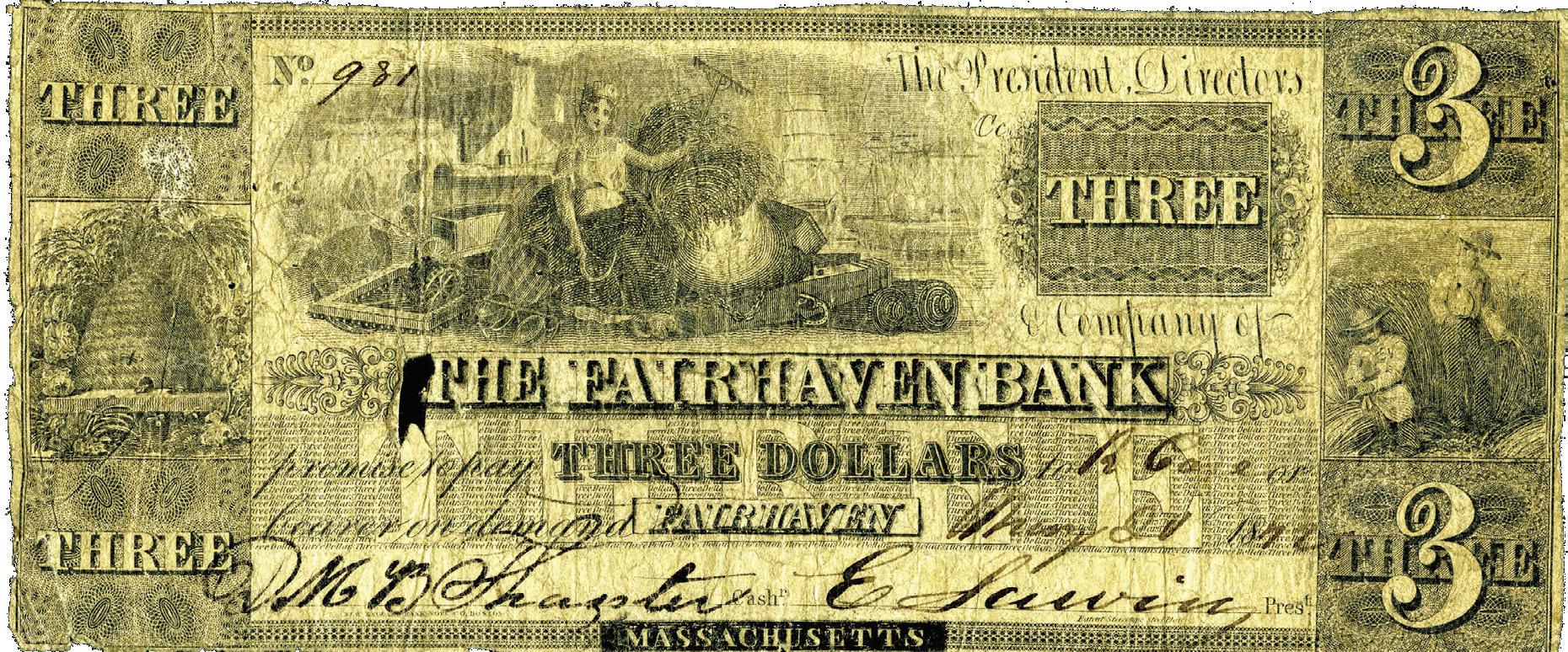
In its original form, the National Banking Act proved unpopular. For the system to function better, amendments were made to entice large banks in New York, as well as smaller “country” banks, to engage in the national banking system. In the spring and summer of 1864 congress amended the system, lowering the reserve requirements for country banks from 25% to 15%, and allowed for the multilayered pyramiding of reserves for New York banks. The amendments helped the system gain popularity among banks across the nation, and the national banking system would last across the nation until the institution of the Federal Reserve System in 1913.
The National banknotes in the Whaling Museum’s collection are a smaller collection than the “free banking” era notes, and consequently come from
a smaller range of banks. All of the notes in our possession from this system are from the New England region, with the majority of issuing banks located in New Bedford, MA. National banknotes in the collection include examples issued by:
• The First National Bank of New Bedford (New Bedford, MA)
• The Merchants National Bank of New Bedford (New Bedford, MA)
• The Safe Deposit National Bank of New Bedford (New Bedford, MA)
• The Mechanics National Bank of New Bedford (New Bedford, MA)
• The National Bank of Commerce of New Bedford (New Bedford, MA)
• The National Bank of Fairhaven (Fairhaven, MA)
• The National Whaling Bank of New London (New London, CT)
• The First National Bank of Biddeford (Biddeford, ME)
For further reading on this subject see: Jaremski, Matthew. “State Banks and the National Banking Acts: Measuring the Response to Increased Financial Regulation, 1860-1870.” Journal of Money, Credit and Banking 45, no. 2 (2013): 379-399. http://www.jstor.org/stable/23463525.
31 | Spring/Summer 2023
Fig. 2. Three Dollar banknote issued by the Fairhaven Bank of Fairhaven, MA, May 20, 1842. 2.75 x 6.5 inches, NBWM, 2003.101.95. Bequest of Eliot S. Knowles.
Klebaner, Benjamin J. “State-Chartered American Commercial Banks, 1781-1801.” The Business History Review 53, no. 4 (1979): 529–38. https:// doi.org/10.2307/3114737.
Michaels, Walter Benn. “The Gold Standard and the Logic of Naturalism.” Representations, no. 9 (1985): 105–32. https://doi.org/10.2307/3043767.
Newman, Patrick. “The Origins of the National Banking System: The Chase-Cooke Connection and the New York City Banks.” The Independent Review, 22, no 3. (2018): 383-401. http://www.jstor.org/ stable/26314773.
Rolnick, Arthur J., Bruce D. Smith, and Warren E. Weber, “Lessons from a Laissez-Faire Payments System: The Suffolk Banking System (1825-58).” Federal Reserve Bank of St. Louis Review, May/June (1998): 105-16.
Smith, Bruce D., and Warren E. Weber. “Private Money Creation and the Suffolk Banking System.” Journal of Money, Credit and Banking 31, no. 3 (1999): 624–59. https://doi.org/10.2307/2601080. Van Fenstermaker, J., and John E. Filer. “Impact of the First and Second Banks of the United States and the Suffolk System on New England Bank Money: 1791-1837.” Journal of Money, Credit and Banking 18, no. 1 (1986): 28–40. https://doi. org/10.2307/1992318.
32
For much of the history of the United States, questions surrounding the function of the central financial institution of the country, its role, power(s), and responsibilities surrounding monetary policy, have been common.

33 | Spring/Summer 2023
Piecework lap quilt “made by women of the Cummings family, circa 1865.” Satin. 55 x 56 inches. This quilt is made in the “log cabin” pattern. NBWM, 00.221.101

34
Stitching as Personal History
Quilts in the Collection
By Naomi Slipp, Douglas and Cynthia Crocker Endowed Chair for the Chief Curator and Director of Museum Learning
When it comes to traditional written histories, women’s stories are often hidden in the margins. Historically, women’s lives were defined by their class, race and ethnicity, social position, marriageability, domestic skills, husband, and children. If recorded, their names are often subsumed by the surname of father or husband. For the majority, their labors were domestic and familial, tied to the innumerable duties of home and the raising of children. When we look at the visual and material culture of a museum collection, however, we find vivid evidence of their work and skill, their artistry and vision. Quilts are one such product.
“Quilting” is defined as “a method of stitching layers of material together. Although there are some variations, a quilt usually means a bed cover made of two layers of fabric with a layer of padding (wadding) in between, held together by lines of stitching. The stitches are usually based on a pattern or design.”1 Quilts can also be comprised of piecework, where textile scraps are stitched together in a patchwork pattern to form a bedcover. Whatever their method of construction, a quilt can be “read” as an object in many ways. We can consider the pattern used, the fabric employed, the maker(s), the owner, or the event that a quilt might commemorate. Every quilt has a story.
In North America quilting became a popular domestic handicraft by the 1700s and took off in the 1800s, as machine-made textiles and massproduced domestic manuals disseminated patterns
1 An Introduction to Quilting and Patchwork, Victoria & Albert Museum, https://www.vam.ac.uk/articles/an-introduction-toquilting-and-patchwork.
and materials to far flung locations across the country. Household textiles, like quilts, were highly valued, and into the 1800s were listed in wills and inventories. During this time, quilts became regarded as popular trousseau items and were also made to record a birth or wedding.2 Traditions emerged like the “quilting bee,” wherein individuals gathered to stitch and gossip. They worked on individual pieces that would be quilted together into an entire quilt. They might create a piece for a woman about to get married or a sailor off on his first voyage. Bees were a way to collaborate for personal gift giving, make money for individual economic need, or fulfill collective activist aims. Quilting bees were an opportunity to forge community, often for women who may have had little opportunity for gathering otherwise. Quilting bees continue today. The Freedom Quilting Bee and Gee’s Bend Quilting Collective are two famous twentieth-century examples. Established in the Black Belt in Alabama, they were a means to achieve economic independence and became radical symbols of female-led Black craft traditions and community organizing. Quilting, at a bee or within a family, served to pass on skills, to share culturally important patterns, to tell stories, and to create intergenerational practices and ensure legacies.
Quilting is a visual language, a lexicon of tried-andtrue patterns as well as innovation. The Museum has twenty-three full-sized quilts in the collection. They range from the traditional log cabin and churn dash or Greek square patterns to crazy quilts, from the nine-patch style set on a bias and the Ohio star to calico checkerboard and trapunto work. Every quilt is a record.
2 A “trousseau” is the personal possessions of a bride usually including clothes, accessories, and household linens and wares.
35 | Spring/Summer 2023
All About Stuff
The fabrics used for quilting include the make-do utility of scraps and odds and ends, and the use of more elaborate stamped or plain but elaborately quilted designs. Some quilts in the collection utilize silks, satins, and velvets, others employ handwoven linen, machine stamped calico, or homespun fabric. One quilter elected to use “plain” white cotton and focus on stitching for their spectacular design (1980.46.2). Grape clusters, squash, floral bouquets, and swags are trapunto work: a technique of stuffing embroidered designs with cotton batting to create a dimensional surface. There is no printing or color here, only the needlework of a skilled practitioner.
Printed cotton textile production evolved over the 1700s from block-stamped calico to cylinder printed chintz (patented in 1783). The names “calico” and “chintz” referenced the Indian origin of most cottons in the 1600s.3 By the 1700s, American colonialists mostly used English printed cottons and French imitations, called Indiennes. The increasing availability of US-manufactured cotton prints by the 1850s in a range of colors, pattern, quality, and price meant consumers could afford them. The American pieced quilt grew in popularity as a result.
There was a stark reality behind the rise in Americanmade, industrially produced cotton. Before the Civil War, American cotton was farmed, picked, and sorted by enslaved African Americans in the US South and, long after emancipation, by Black sharecroppers whose lives offered little opportunity. Textile mills across the country employed children, women, and recent immigrants, who worked under dangerous and difficult conditions. Despite the politics behind American textile production, quilts and quilting united individuals across class and race. No matter one’s background, quilting proved an enduring familial legacy.
In around 1815, Hetty Howland Hussey (1795-
3 For reference, see: N.A. Reach, “Printed Fabrics,” Bulletin of the Pennsylvania Museum (Vol. 20, No. 95 (May 1925), 143-153; World Quilts: The American Story, https://worldquilts.quiltstudy. org/americanstory/business/textiletrade; Linda Welters and Margaret Ordonez, eds., Down by the Old Mill Stream: Quilts in Rhode Island (Kent, OH: Kent State University Press, 2000); Elena Phipps, The Materials and Techniques of American Quilts and Coverlets, https:// www.metmuseum.org/toah/hd/mtqc/hd_mtqc.htm
1869) created a pieced quilt that relied not on elaborate patterned squares or stitchery but instead emphasized the calico print itself (00.221.104). A field of small, plain floral print squares is surrounded by a wide border of calico toile with vernacular farm scenes of haying and animals. The overall brown tonality of the quilt may be due to fading, as most printed textiles in this period used natural vegetable dyes. Another unusual quilt from 18601875 (1988.29.1) uses mostly machine-made calico fabrics and combines diamonds, kite shapes, and central stars. Looking closely, it demonstrates a combination of hand and machine stitched quilting. The first American sewing machine was patented in 1846, but they were not widely introduced for domestic use until 1889. This fact indicates either an intergenerational production for this quilt or, at the least, multiple modes of manufacture.
In some cases, the maker of a quilt employed colored floss to accent their quilt. A crazy quilt (2000.16.4) made by Mellonie Jane Suydam Otis (1853-1928) around 1915 combines bright irregularly shaped pieces and is backed in gold cotton. Popular around the turn of the twentieth century, so-called “crazy quilts” were intentionally highly individualistic and emphasized handwork in the face of increasing mechanization. Mellonie used vividly colored embroidery to create patterns around the edges of pieces and designs in some squares, like flowers, a dog, and jumping horses. This is a fancy quilt made with cotton, but also satin, silk, and velour. A second crazy quilt (00.221.103) also employs luxurious fabrics like satin and velvets and elaborate embroidered pieces including a cat named “Louie,” swallow, flowers, a compass rose, an anchor and rope, a butterfly, and a peacock feather. Some of the embroidery work includes initials, indicating that perhaps this quilt was a collective endeavor.
A few examples in the collection are signature quilts, made by a collective in which each contributor signed their square. The Bakerville Quilt (1982.27) was made around 1878 by the Bakerville women of South Dartmouth in the churn dash or Greek square pattern. There are twenty-eight squares, each made by a different person. This quilt was likely made for Alexander J. C. DeHart (1858-1934) of Dartmouth,
36
MA, age 20, who sailed as a seaman onboard the bark Sea Fox out of New Bedford on a whaling voyage to the Pacific Ocean 1878-1882.1 Signatures and inscriptions mark each individual square, and messages by the women are inscribed on the quilt: “Be a good boy,” “Good luck to you and a plenty
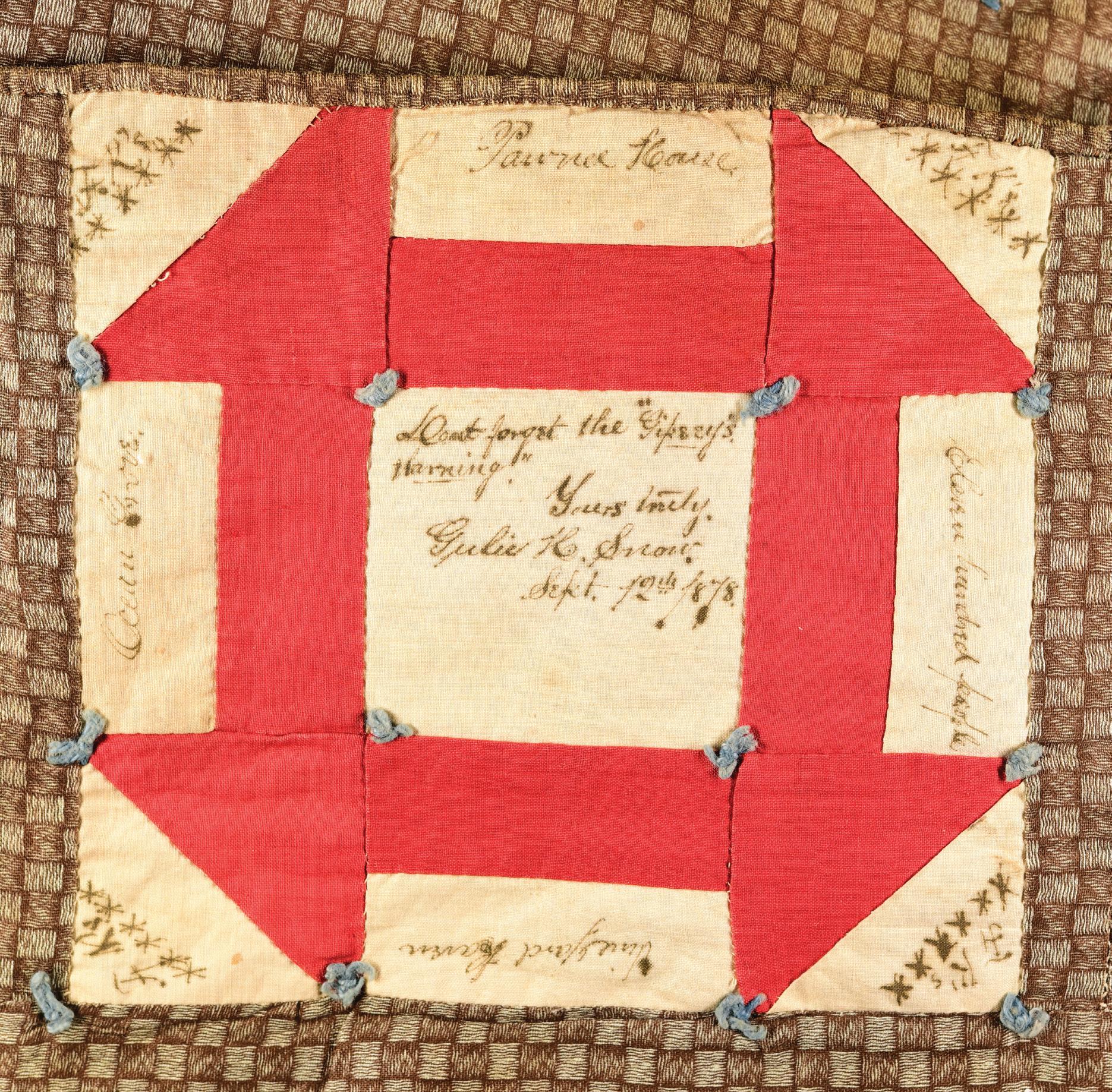
1 Alexander J. C. DeHart was born onboard the ship Roman II of New Bedford, Abraham DeHart, master, while whaling in the South Pacific. His parents were Captain Abraham DeHart (1822-1883) and Charlotte Weeks Sherman (1829-1911), both of Dartmouth. His brother John L. DeHart (1861-1872) was also born at sea homeward bound on the same voyage. He and his family lived in “Bakerville,” a village along a section of road in South Dartmouth.
of sperm,” “May you prosper in your undertaking,” and “Don’t forget the Gypsy’s warning.”2 Similarly, a wedding quilt from 1849 (1985.28) includes ninetynine squares in the nine-square pattern; each was made by a different hand and is inscribed in the center with a name and picture. It was created for Elizabeth Bartlett Bunker (1829-1893) upon her marriage to Philip Stites Leaming of Cape May, NJ. Likewise, a presentation quilt (1992.22) in the Ohio star pattern was made for Drusilla P. Sawyer
2 “The Gypsy’s Warning” was a popular parlor song of the mid-1860s cautioning maidens against the actions of a rakish man.
37 | Spring/Summer 2023
Fig. 1. Bakerville Women of South Dartmouth, MA. Piecework quilt, 1878. Cotton. 48 ¾ x 78 ¼ inches. This specific panel of the quilt is signed “Julie H. Snow,” and conveys the message to “Don’t forget the ‘Gypsy’s warning’, Sept. 12, 1878.” NBWM, 1982.27. Gift of Mrs. Kinga Spelman Low.
(1830-1895) by her female students at the Centre Grammar School in Fairhaven, MA. Each wrote a name in a square, and likely gave the quilt as a gift to commemorate Sawyer’s 1852 marriage in New Bedford, MA to William Knights. In this way, the quilt commemorates female kinship and marks marriage as a significant moment in a woman’s life.
Quilts represent warmth, domestic comforts, and care. Often, a quilt is an act of love. In this respect, the quilts in the Museum collection are artifacts of material culture that illustrate the strong relationships that existed between individuals. In some cases, enduring ties between generations are signaled in the provenance of a quilt. Two quilts tell this story. Made by members of the Cummings family around
1865, a log cabin quilt (00.221.101) and a pieced quilt (00.221.102) in a herringbone pattern employ stunning satins in vivid colors, likely achieved using newly developed synthetic dyes. These two quilts were donated to the Museum with a hand-written note: “Piece quilts made by women of the Cummings Family.” With this inscription, the donor aimed to reference and record those absent hands, who pieced and quilted these family heirlooms.
Each quilt in the Museum collection serves as a reminder that their makers, most often women who left little else behind in the historical record to remember them by, were here. They created legacies of their own, across generations and stitch by stitch.
38
For the majority, their labors were domestic and familial, tied to the innumerable duties of home and the raising of children. When we look at the visual and material culture of a museum collection, however, we find vivid evidence of their work and skill, their artistry and vision. Quilts are one such product.
“A Catalyst for the Greater Good”
When we think of sperm whales, the first thought that comes to mind might be Moby Dick or the tale of the angry sperm whale that wrecked the whaleship Essex of Nantucket. Maybe we think about their grand size or their mysterious nature, or possibly the industrial whale hunt. After all, commercial hunting began in the colonial period when the great whales were plentiful on the high seas and relatively close to home. This was a time when Americans sailed into the deep ocean seeking sperm whales for the spermaceti found within their massive head cavities. Either way, from literature, science, or history, sperm whales have become an icon or perhaps even a mascot for our world-renowned maritime industries, past and present, here in New Bedford, Massachusetts.
When I first started my apprenticeship, I was able to explore multiple opportunities provided by the museum. They helped me investigate many different ideas, causing me to question what I wanted to do after I graduated high school. One thing that sparked my career interest in marine biology was the sperm whale. Specifically, the skeleton of the sperm whale in the Turner Gallery intrigued me, and I couldn’t help but wonder how this wild animal ended up here. I had so many questions. What was its life like when it had the freedom of the vast ocean, swimming without restraint through endless miles of blue sea? From what I could imagine through research, photographs, and documentary films, such a life must have been filled with wondrous and endless adventures. Then I made a heart wrenching discovery.
Our beloved sperm whale’s journey to the Whaling Museum started when residents of Nantucket Island found the specimen beached dead upon the shore on June 7, 2002. Whales do sometimes wash ashore and sperm whales sometimes wash ashore at Nantucket, but what’s to be done with a dead whale on the beach? What can be done about something when it is far too late to do anything resembling a positive outcome? In this case, the options were few. The carcass could be either destroyed entirely, towed out to sea, or accepted by a museum. One way or the other, the whale had to move. Fortunately, the New Bedford Whaling Museum was interested in taking it. In 1998 the Nantucket Historical Association had added a sperm whale skeleton from a similarly dead animal to their exhibits. But this time the carcass was hauled 65 miles down the coast and across Buzzards Bay to a flatbed truck in Fairhaven, where it was loaded on and taken to the New Bedford landfill. At the landfill the carcass was autopsied, most of the soft tissue removed, and the bones buried beneath a combination of horse and elephant manure to allow microbes to completely de-flesh them, extracting and entirely consuming any oily residue in the bones as well.1 Months later, the bones were dug up and stored in the museum to be reassembled by a crew of marine biologists and college students. The skeleton was put on display in 2005.
The end of this whale’s journey sparked the beginning of one of my own. My questions were still burning, but now they had changed. What causes whales to beach themselves? Even though whales have been
39 | Spring/Summer 2023
1 The elephant manure was supplied by Ruth and Emily, residents of the Buttonwood Park Zoo in New Bedford, MA.
Waverly Verissimo, New Bedford Whaling Museum High School Apprentice
Fresh Perspectives
recorded stranding themselves throughout history, we still don’t have any explanations as to why this specific whale washed ashore dead. Is it due to illness or global warming, or are humans making decisions that have caused whales to lose their ability to navigate? To the demise of this particular sperm whale, I owe a debt of gratitude. I now know that I want to build a career in marine biology with a tie to the environmental sciences. In this way, I may become a catalyst for the greater good, not only for this species but for all wildlife that are not immune to negative human decision-making regarding the environment.
What was its life like when it had the freedom of the vast ocean, swimming without restraint through endless miles of blue sea?
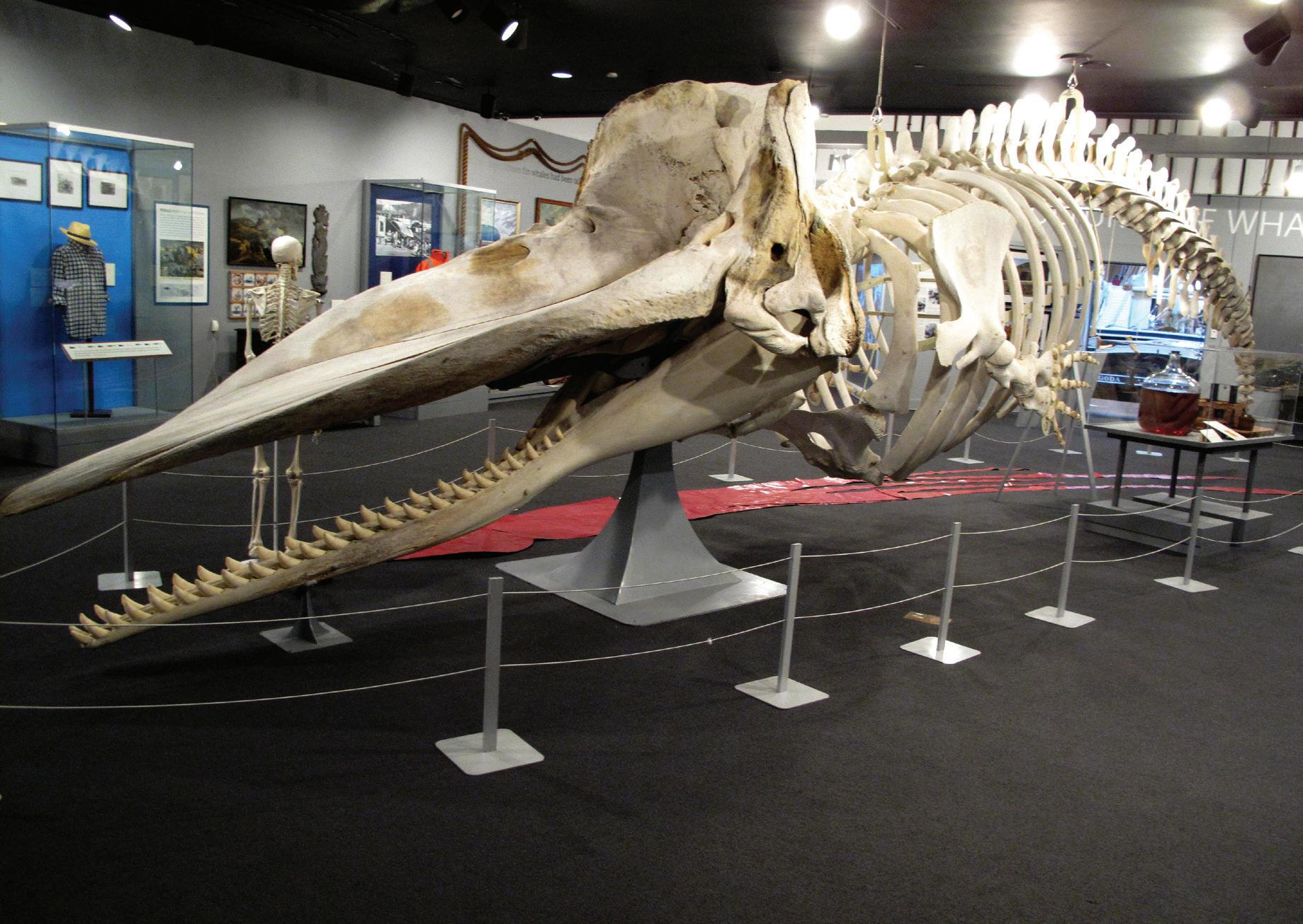
40
Fig. 1. The skeleton of a sperm whale (Physeter macrocephalus), National Marine Fisheries Service (NOAA Fisheries) Sperm Whale #14.65, ID #MH02-673PM, NBWM 2003.95.
“Contrary to both law and reason”
The Danish seizure of the brig Nancy of Rochester, MA, 1810
Transcriptions by John Ricketson and Bob Hussey with explanatory notes by Michael P. Dyer
These transcriptions were created by NBWM Volunteers John Ricketson and Bob Hussey from: NBW 1450 Nancy (Brig) of Rochester, Nathan Briggs, master, Seth Barlow, second mate, keeper, on voyage from New York to Gothenburg, Sweden, March 26, 1810-May 28, 1810, January 20, 1811- May 20, 1811. The journal volume was confiscated when Barlow and his shipmates were taken onboard the Danish privateer North Star and later confined at Trondheim for seven months.

41 | Spring/Summer 2023
Spreading the Word
Fig. 1. First page of Seth Barlow’s manuscript sea journal of a voyage from New York to Gothenburg, Sweden, March 25, 1810. NBWM 1450.
During the Napoleonic Wars (1803-1815), neutral nations like the United States attempted to maintain trade despite wartime upheavals in Europe. However, Napoleonic France often perceived mundane trading voyages to Baltic ports as smuggling ventures. On April 4, 1810, the brig Nancy of Rochester, MA (Nathan Briggs, master) cast off from New York and set sail on a voyage to Gothenburg, Sweden carrying a cargo of tobacco, logwood, cotton, and raisins. Gothenburg was the first leg of a multi-port voyage which included collecting a cargo of salt from Cape Verde and gold specie from Ireland, before ultimately returning to New York. The second mate of the Nancy, Seth Barlow (1780-1870) of Rochester, MA, kept a very fine and detailed account of the voyage in several volumes. One volume presents an exciting incident, that also highlights the complications facing American merchant ships during an unpredictable period in maritime history and international relations.
Barlow’s journal commences on March 26 with details like the loading of the brig’s cargo, including “hogsheads” of tobacco, “bales” of cotton, “kegs” of raisins, and “sticks” of logwood.1 In his daily entries, he recorded his leisure activities in New York over a few days at the end of March, as well as the subsequent voyage across the North Atlantic. With characteristic skill and a calligraphic hand, Barlow documented all of the particulars requisite to a proper seaman’s journal such as the hours of the day, the course, direction, and speed of the vessel, wind direction, latitude and longitude, the variation of the compass, and the weather. He offers brief insights and details about the officers and crew, illustrations of wildlife and ships seen, and other interesting details including land recognition drawings.
The voyage took an unexpected turn on May 28, 1810, when the Danish privateer North Star overtook the Nancy off the coast of Norway and seized the
1 All of these commodities except for the logwood were the produce of the enslaved population of South Carolina. This cargo clearly demonstrates how integrated the economy of slavery was in the U.S. The logwood, a reliable commodity used for the dying of wool, could only have come from ports in the Caribbean controlled by either the British or Spanish, hence if there was possibly some controversy over the cargo being shipped as contraband, it would most likely have been the logwood.
vessel, cargo, and crew. Barlow’s journal abruptly stops on that date. There is a brief notation in an unidentified language dated 15 June 1810, followed by another notation in Barlow’s hand: “The above scrawl was wrote in Copenhagen while the book was before the court.” His next entry in this volume is January 20, 1811. Below is the transcription:
Remarks on board Norway Brig Nancy in the Elva2
Sunday Jany 20th
This Day, Again Commence Writing in this journal, which has been absent from me upwards of 7 Months. It has been thro the Prize Court of Drontheim, and the high Court of Admiralty in Copenhagen, has been Signed by the Clerk of the last Court as [Genuine?], and found its way to me about the 10th of the Present Month. The first Part of these 24 Hours Strong Gales at S. W. attended with rane. Latter Part moderate and warm. Clear and Calm. One Brig droped out into the Bay ready for Sea. Read the Novel of PAUL and VIRGINIA
and The Indian Cottage, or a ramble after truth which is to be found no where but in NATURE3 Revd of Capt Briggs -- 7,,0,,0 -- Wages
Cook -- 3,0,,0 -- Money Lent
Silas -- 1,,0,,0 -- D.
Paid to the Wash Woman for Washing mending and making Clothes -- 5 Dollars. So ends the Sabbath Day
The entire time that Barlow and his shipmates were confined at Trondheim, Norway, he kept a detailed journal describing the port, its people, and his dayto-day activities as a prisoner.
2 The Nidelva River flows into the port of Trondheim. The header text places “Norway” as the location of the vessel and is not intended as an indication that the vessel is Norwegian.
3 Transcriber John Ricketson notes: Paul and Virginia (1788) and The Indian Cottage (1790) are novels by Jacques-Henri Bernardin de Saint-Pierre (1737-1814). In the 1800s, he was very popular and evidently Barlow obtained a copy in English, most likely the W. Suttaby, Crosby and Co., and Scatcherd & Letterman, London, 1810 edition. According to Nuttall’s Encyclopedia it is a “wildly romantic but irreproachably moral tale.”
42
Why had the Danes seized an American merchant brig in Norwegian waters carrying a general cargo for trade and examined the personal papers of the crew? The answer lies in American neutrality through the Napoleonic Wars.
In the aftermath of the American Revolution, maritime trade was the best option for American economic freedom. However, during the French Revolution and the Napoleonic Wars, England and France each sought to cripple US trade with
the other. Americans tried to maintain neutrality through the 1790s but American trade treaties with England brought the US and France into conflict. This prompted the oft-cited “Quasi-war with France” (1798-1801), and led French privateers to attack American ships in the Caribbean. In response to French actions and the on-going impressment of American seamen by the British, President Thomas Jefferson sought to isolate and protect American interests by forbidding all overseas trade by American vessels. Jefferson’s embargo ran from 1807-1809

43 | Spring/Summer 2023
Fig. 2. Seth Barlow, “Norway. Remarks on board big Nancy in the Elve.” Trondheim, Norway is located at the mouth of the Nidelva River and it is to this place that the vessel and crew were taken after being seized by the Danish privateer. NBW 1450.
and was particularly damaging to the economy of maritime New England. The brig Nancy (and dozens of other American vessels) which sailed shortly after the embargo was rescinded, sailed straight into what President James Madison would term the “licentious cruisers under the Danish flag.”
At the time, the Danes controlled Norway and the Skagerrak (identified as “the Sleeve” on some early charts), a very important seaway constricting the passage to the Baltic Sea. Denmark was also allied with France. The French considered American trade with the Baltic illegal. Barlow describes how the Danish “privateersmen” went into the hold of the brig Nancy seeking contraband and “tore away some of the pump room in hopes to find that which is not on
board and never was.” Ultimately, the court cleared the brig Nancy, ordering Captain Nathan Briggs to pay $300.00, plus court costs, for sailing without a proper Bill of Sale. In 1830 under the Andrew Jackson administration, Danish spoliations from this period, which amounted to over $650,000.00, were ultimately redressed.
In April 1811, Nathan Briggs, Seth Barlow, and the crew of the Nancy loaded a cargo of Norwegian lumber and sailed for Ireland, one long year after beginning their voyage in New York. Barlow’s journal brings these complex years to life through his narrative experience as an American mariner in European waters during the Napoleonic wars.
44
With characteristic skill and a calligraphic hand, Barlow documented all of the particulars requisite to a proper seaman’s journal such as the hours of the day, the course, direction, and speed of the vessel, wind direction, latitude and longitude, the variation of the compass, and the weather.
Lighting the Way
Women of Both Energy and Enterprise
By Cathy Saunders, former Coordinator of Lighting the Way: Historic Women of the SouthCoast, and Carole Clifford, Museum Volunteer and Docent
Exploring the galleries of the Whaling Museum you may wander into Energy and Enterprise: Industry and the City of New Bedford, which tells the story of New Bedford’s evolution from a whaling port to a manufacturing center. A striking oversized reproduction of a photograph of a woman standing at a milling machine in the Morse Twist Drill Factory, circa 1900-10, is a visual reminder
that women were instrumental in the rise of labor and industry. In particular, New Bedford’s textile industry exploded during the early 1900s and women workers were needed. During this period, immigration to the region increased dramatically, providing a new potential workforce. Young women, very often from large families who would benefit from the income, were pulled out of school, despite
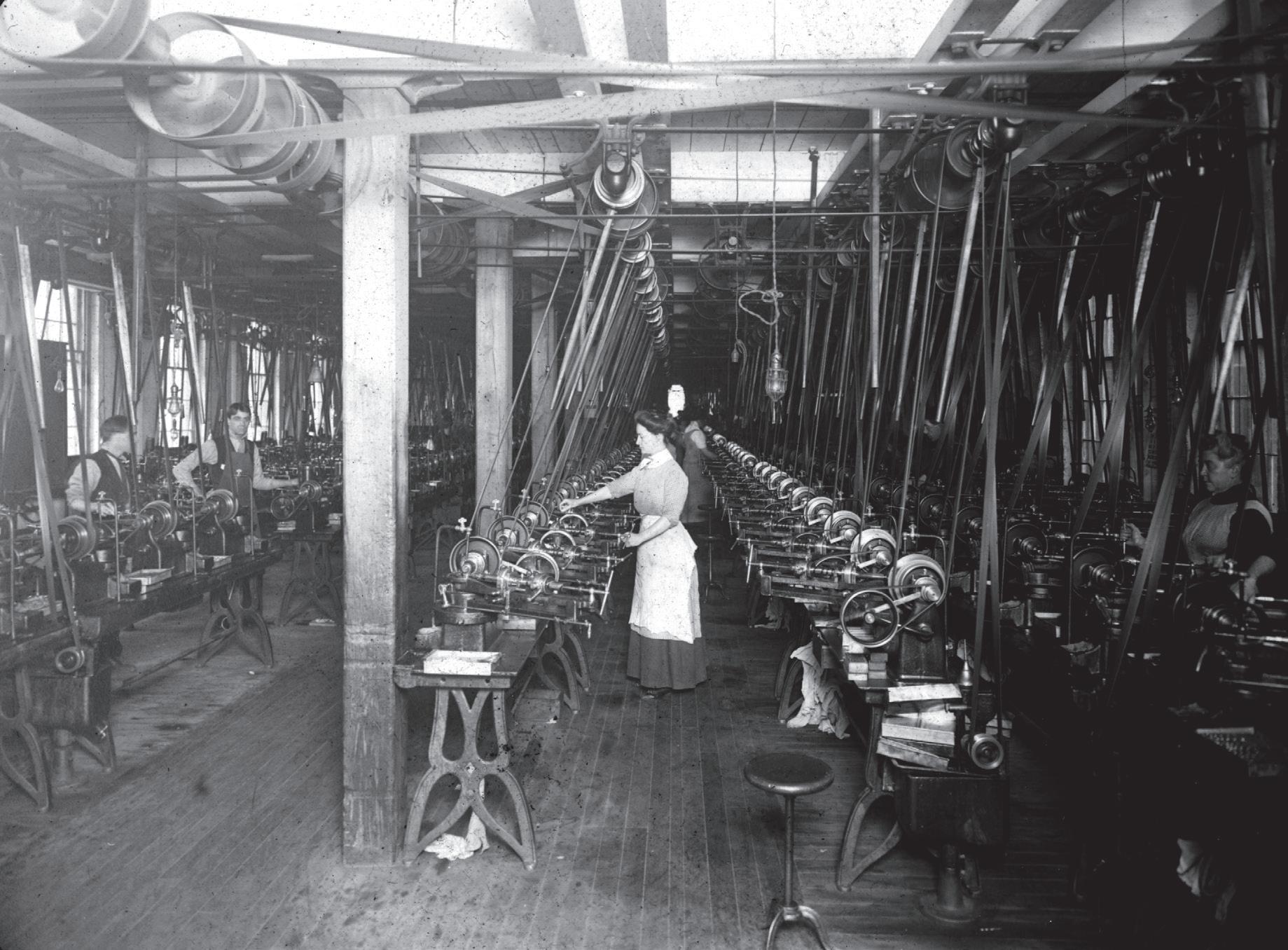
45 | Spring/Summer 2023
Fig. 1. Maker once known, Workers at the Morse Twist Drill and Machine Company, c. 1910. Lantern slide, NBWM #1990.41.1.93.
Massachusetts’ mandated public school attendance laws passed in 1852, to work in the factories.1 Other women sought out work as an emerging alternative to the more traditional pathway of marriage. By the 1920s, the textile industry workforce in New Bedford was comprised of both men and women, who were mostly recent immigrants. At the outbreak of WWII, New Bedford reportedly had the highest percentage of women workers in the country.2
Unfortunately, while her identity was undoubtedly known at one time, like many workers in old photographs, the name of the woman in the Morse Twist Drill and Machine Company photograph is unrecorded. However, through the Museum’s online resource Lighting the Way: Historic Women of the SouthCoast, we do have stories of women of both energy and enterprise that help illuminate the history of this period and some of the new roles that women adopted in a changing economy.
In 1928, when 20,000 New Bedford textile workers went on strike to oppose a planned 10% wage cut, at least two women were Union leaders in their immigrant communities. Portuguese immigrant Eulalia “Eula” Mendes (1910-2004) was a bobbin worker at City Mill textile factory. She translated speeches from English into Portuguese and gave her own speeches encouraging Portuguese industrial migrant workers to participate in the strike. Her activism, at the young age of 18, led to a leadership role with the strike’s executive committee and a lifelong commitment to workers’ rights. Similarly, French Canadian veteran union leader Aurélia Benoît Lebeau (1874-1955), a former secretary of the New Bedford chapter of the Amalgamated Textile Workers’ Union, traveled to Montréal, Canada seeking aid for strikers’ families. There she told the “pathetic story of bread lines of families of the strikers lined up to receive food,” resulting in vital assistance back in New Bedford.
1 https://historicwomensouthcoast.org/eulalia-mendes/ 2 https://www.capeandislands.org/in-this-place/2014-09-23/newbedfords-textile-mills-relics-of-an-industry-that-flourished-thenfaded-into-history.
Nora Ouimette Duprey (1909-1987) and Dora Bastarache (1915-1988) are two New Bedford born workers and union activists profiled on Lighting the Way. Like many, Nora had to drop out of school to support her family. She worked at both Wamsutta Mills and National Spun Silk Company. She was determined to further her education and make a difference for female workers. She became an organizer for the Amalgamated Clothing Workers of America and, through continuing education, became an engineer at Acushnet Company. Dora was a stitcher in various New Bedford shops and a leader in the International Ladies’ Garment Workers’ Union in southeastern Massachusetts. As a single mother who struggled to make ends meet, Dora fought for quality child care, low cost health care, and accessible higher education. These were all things denied to her as a young woman worker. To this day, “The Dora Bastarache On-the-Line Award” is annually presented to recognize strong collective action by the Arnold M. Dubin Labor Education Center at the University of Massachusetts Dartmouth.
The Museum’s exhibitions are complemented by vast collections and online resources that can be accessed anytime from anywhere. The Lighting the Way: Historic Women of the SouthCoast website profiles more than 130 women whose stories and accomplishments help increase our understanding of the community’s history. Additionally, the museum has solidified its commitment to understanding, documenting, and interpreting the lives of SouthCoast women by forming a new board-level Women’s History Advisory Committee. For example, the lives of the four women described in this article – Eulalia Mendes, Aurélia Benoît Lebeau, Nora Ouimette Duprey, and Dora Bastarache – and their involvement with labor organizing and the New Bedford textile industry, illustrate that women’s history is history.
46
Poetic Insight
The Cutting-In

After reading Fathoms by Rebecca Giggs
By Richard Dey
Richard Dey (b. 1945) is an American poet, who writes about New England and the West Indies. As a teenager, he sailed in the Schooner Tabor Boy out of Marion, MA. After serving in the US Army as a journalist in Washington DC, he graduated from Harvard College in 1973, where he was poetry editor of The Harvard Advocate. In the summer of 1971, while working as crew in a charter yacht, he first visited Bequia, a dependency of St. Vincent in the Grenadines. The island became the inspiration for many of his works. After college, Dey worked as an offshore lobsterman out of Westport Point, MA, and as a writer in the Windward Islands. During this time, he
47 | Spring/Summer 2023
Fig. 1. Daphne Ollivierre (Bequia, St. Vincent and the Grenadines; 1944-2021), Flensing a Pilot Whale at Petit Nevis, 1975. Hand-sewn cotton, 30 x 40 inches, NBWM, Kendall Collection, 2001.100.4867. Gift of Norman Flayderman. Nicola Redway, Curator of the Bequia Heritage Museum, recently identified the maker and story behind this piece: Daphne’s husband, Julian Ollivierre, was a harpooner and also a whale butcher, learning his craft from Bluesy Simmons. So it is likely that it is Julian – or possibly both Julian and Bluesy - that are depicted in the hanging.
Of two minds, I responded to the church bell’s ringing call to watch the cutting-in and join in the long-standing celebration. One of hundreds, I stood on the stone wall
above the whaling station watching Bluesy, lance at his arms’ end, flense the whales, the humpback calf first, then the bigger cow on the broad concrete ramp, in water red
with blood, the bible leaves of blubber pulled back, revealing the veined meat, mattress thick. I understood the cutting-in meant food, that fresh or cooked or dried it would be sold;
the rest, without refrigeration, preserved up to six months in the boiled blubber’s fat; and knew the oil in Trinidad would sell for lubricant, that crew shares would be paid.
I understood the harpooner was brave, an island hero, and drank rum neat with him while eating meat cooked on a coal pot, greasy. I did not care for the hunter’s strategy
but I understood killing the calf first in order then to kill the cow, the prize. Was I not a fisherman myself, who harpooned swordfish off the New England coast?
But I stood sick there, sickened by the butchered carcass, the cow’s flukes limp, her fins flopped, its dead hemal stink on the Trade Wind, yachtsmen at anchor, eyes binoculared;
stood embarrassed, a part of the spectacle, a carryover from times poor and still, to nascent affluence from tourists earned— refrigerators fueled by propane in tanks.
I’d yet to learn these baleen animals had sucked in microscopic slivers of pelagic plastic, straining water to feed, their blubber laced with land-leaked chemicals.
Still, as a mariner I understood the whales’ vast oceanic home reduced to this hard concrete ramp, their solitude to this uncomprehending raucous crowd; their songs that reached across the seas to speak with others and with which to see silenced, as if they were defiant, brazen protests, their lively spouting curbed to lifeless bleeding.
A reader, I understood that whaling, once an economic force that shaped a culture of derring-do and dreams and obeah, was now in glossy magazines, a feature.
I knew there was no longer any standing for the crew in their grim hunt, the slaughter leading to extinction—not for an island tourist-dependent in a changing world.
I understood the humpback and the swordfish are resources, sentient and finite, to understand like elephants and parrots, linkage with a world much larger than ourselves hungry, greedy, selfish, vain, bound and blinded by the church bell’s call, by thinking Nature ours to rape, one way and another, without end—unless our own.
(1976-1993; 2021)
also started publishing poems in Poetry, Harvard Magazine, and Sail, and articles in Harvard Magazine, Yachting, Sail, and the Boston Globe, among other publications.
Excerpted from the biography of Richard Dey written by Leah Feldman (2013) for the Williams-Mystic Searchable Sea Literature web page. https://sites.williams.edu/searchablesealit/d/richard-dey/
48 1
2
Animals and Issues
Holy Mola!
By Carol “Krill” Carson, Marine Biologist President and Founder, NECWA New England Coastal Wildlife Alliance
The ocean sunfish (Mola mola) is an odd-looking pelagic fish that is a common visitor to our New England waters. This ocean wanderer has an unusual body shape that is mostly head attached to a small, scalloped tail. Although ocean sunfish are powerful swimmers, they are often observed floating at the surface, as if sunning themselves, hence the common name “ocean sunfish.” Even their swimming behavior is unusual as they oscillate their large dorsal and anal fins back and forth in a manner referred to as “skulling.” Their tail fin is called a clavus and acts as a rudder to help steer the fish as it moves through the water.
Each spring, ocean sunfish migrate north to feed in our cold productive waters throughout the summer and fall. Most individuals are juveniles with an average length of 6 feet and a weight of 600 lbs. It is hard to imagine how these fish grow to such an immense size on a diet of jellyfish, ctenophores, and small fish. They have lightweight bones with a spongy texture that feels more like cartilage than true bone. Their skin is gray in color, rough like sandpaper, and is often covered in a thick layer of mucus. Underneath the skin is a thick layer of reticulated collagen that is white in color and hard in

49 | Spring/Summer 2023
Fig. 1. John F. Martin, “Sun-fish,” c. 1842. Watercolor on paper. New Bedford Whaling Museum, KWM 434. Martin drew this picture of an ocean sunfish in his journal kept onboard the ship Lucy Ann of Wilmington, DE, while right whaling off the coast of Western Australia in the Indian Ocean in 1842. Whalemen often harpooned large sunfish, some of which weigh over a ton, which they then ate. Martin described the flesh as tasting like lobster.
texture.1 The purpose of the reticulated collagen is not well understood but could be used as a structural support when diving deep.
The New England Coastal Wildlife Alliance (NECWA) is a nonprofit based in southeastern Massachusetts and one of the few organizations that rescues and studies these fish in New England waters.
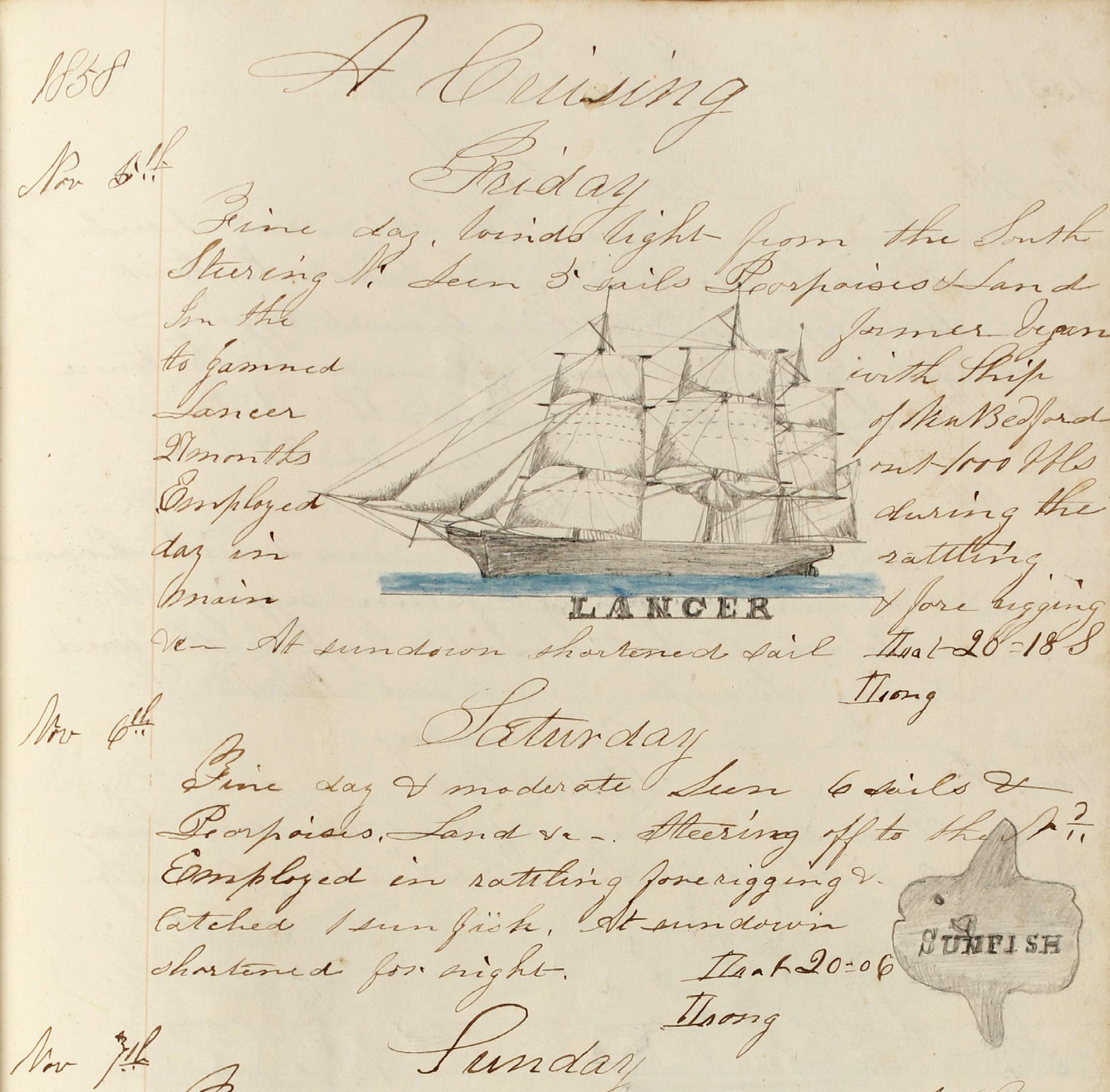
1 Reticular fibers, reticular fibres or reticulin is a type of fiber in connective tissue composed of type III collagen secreted by reticular cells. Reticular fibers crosslink to form a fine meshwork (reticulin). This network acts as a supporting mesh in soft tissues such as liver, bone marrow, and the tissues and organs of the lymphatic system.
Since 2005, NECWA has maintained a communitysighting network for ocean sunfish, asking members of the public to report their sightings of this species seen from a boat or beach. Over the years, NECWA has documented a significant increase in the number of sightings, with a peak of 160 stranded individuals in 2019. NECWA’s long-term stranding database has shown that strandings of ocean sunfish are a seasonal event that occur each year, beginning at the end of August and continuing through December.
The majority of ocean sunfish strandings are the result of navigational issues when fish are migrating
50
Fig. 2. Warren S. Maxfield, “Sunfish,” c. 1858. Pencil on paper. New Bedford Whaling Museum, KWM 49. Maxfield drew this picture of an ocean sunfish in his journal kept onboard the bark Chili of New Bedford while sperm whaling in the Indian Ocean in 1858.
south to warmer wintering areas. Some fish become trapped in Cape Cod Bay or in smaller bays and inlets, working their way into dangerous tidal areas. As the tide ebbs, these fish will eventually strand on mud flats or sandy beaches. Those individuals who avoid these dangerous areas will eventually succumb to cold-stunning, a physiological condition that is the result of exposure to prolonged cold-water temperatures. Although the fall is peak stranding season for them, a smaller number of individuals strand earlier in the season due to vessel strikes or gear entanglements.
The waters of the Gulf of Maine are warming due to climate change which could explain the increase in Mola off New England and their unusual behaviors when in our waters. As ocean temperatures increase, one might expect to see a decrease in the incidence of their sunning behavior. Although the data needed to answer this question is not available, this question has parallels to observations made by whalers when sailing in tropical oceans. When in these waters, whalers would occasionally see ocean sunfish at the surface, and would record these sightings in their logbooks and journals. Why would these fish exhibit this type of basking behavior when in warm tropical waters? Perhaps the answer relates to their feeding behavior.
Ocean sunfish are deep divers that feed at depths of over 3000 feet for extended periods of time. Water temperatures are extremely cold at these depths and eventually fish would need to return to the surface and bask to warm up. Ocean sunfish would therefore exhibit similar behaviors to regulate their body temperature and aid in digestion regardless of their latitude or location. Looking back in time may provide insights to behaviors that we see today and to changes that might occur as oceans continue to warm. These comparisons may also help us better understand changes in ocean sunfish distribution, population frequency, and other parameters that are occurring today.
NECWA rescues stranded individuals or conducts necropsies on carcasses that wash ashore. When rescuing live animals, trained personnel use kayaks to access fish stranding in shallow water. These “first responders” jump into the water and maneuver the animal into a floating hula-hoop. Once the fish is secured in this towing apparatus, the kayaker paddles the fish to deeper water, passing it off to a 17-foot motorboat that is NECWA’s rescue boat. The motorboat now picks-up the journey and tows the fish to deeper water for eventual release.
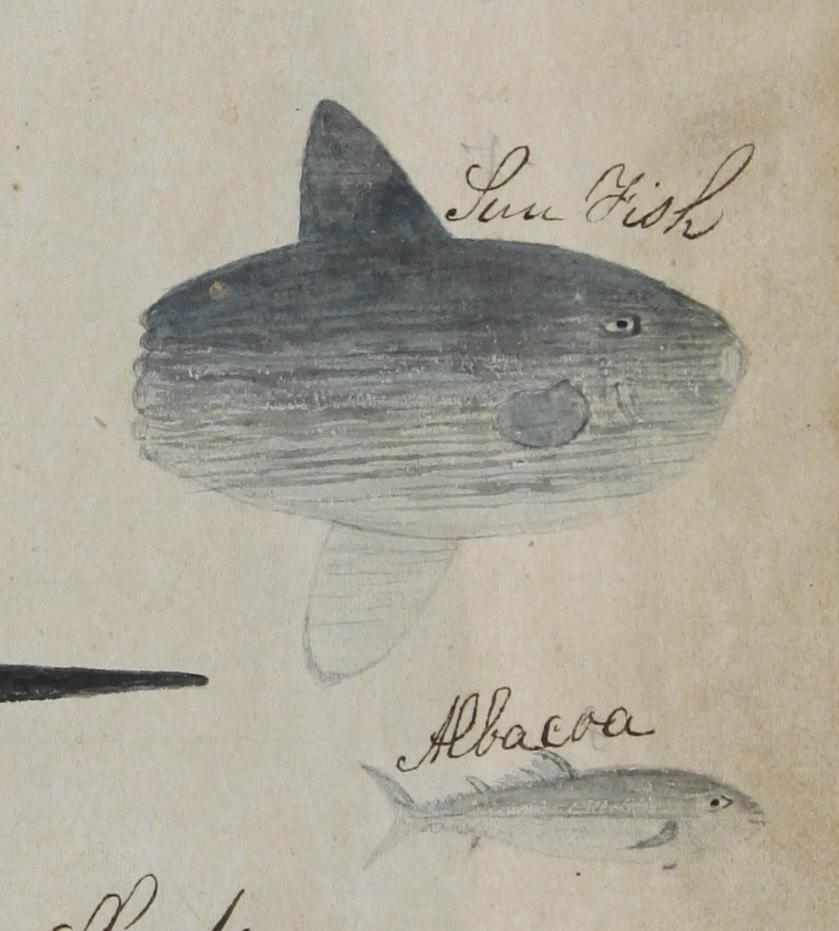
51 | Spring/Summer 2023
Fig. 3. Dean Chase Wright (American, 1819-1895). Detail view of sea creatures including a sunfish drawn in his “Commonplace Book” kept onboard the ship Benjamin Rush of Warren, RI, 18411845. Pencil and watercolor on paper, 12 ½ x 7 ½ inches. NBWM, Kendall Collection. A-145.
The majority of ocean sunfish strandings are the result of navigational issues when fish are migrating south to warmer wintering areas.
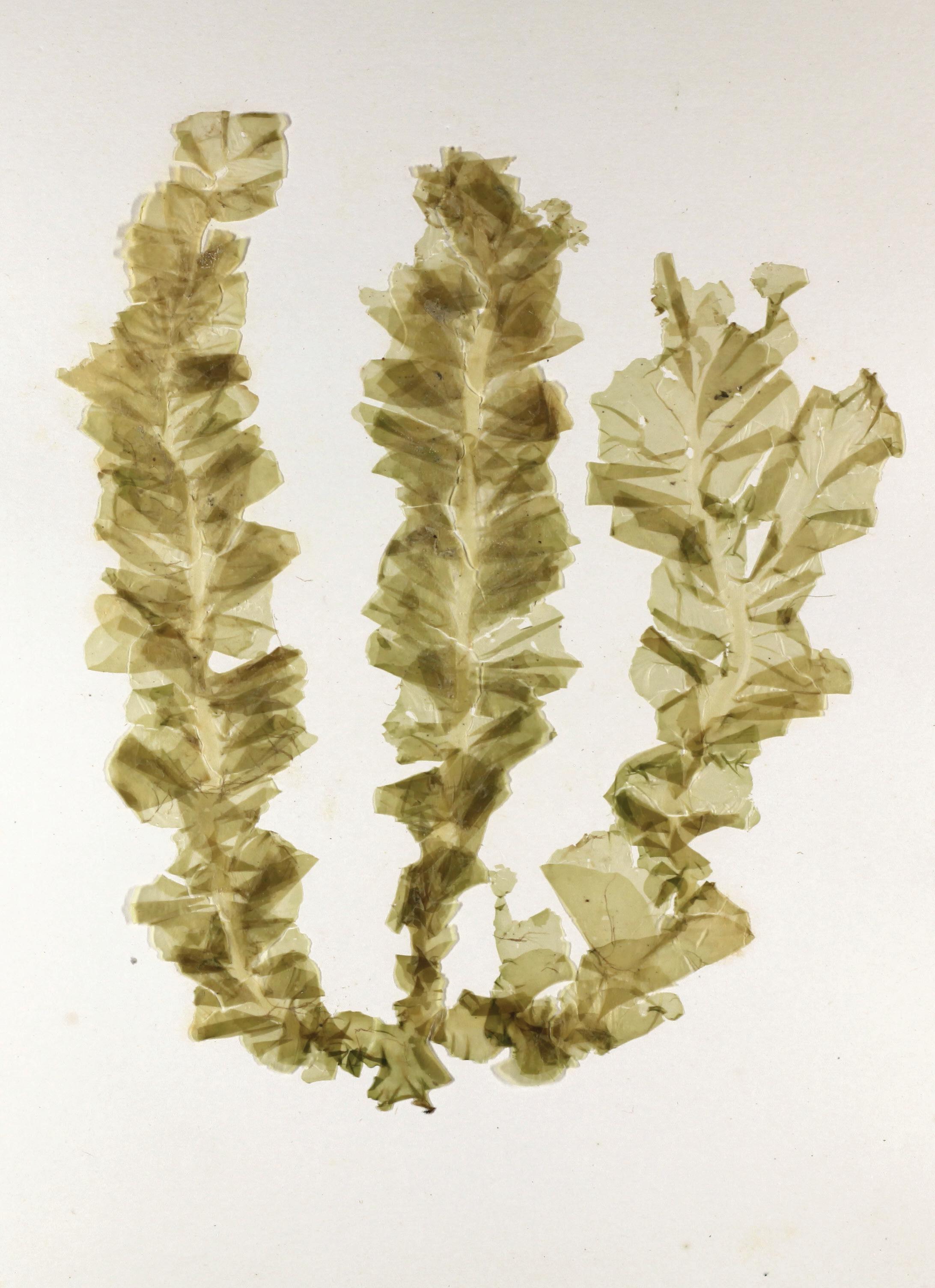 Charles H. Durgin (American, 1842-1917), Seaweed Specimen, Ulva fasciata. Delile, c. 1861-1890. Seaweed on paper, 16 x 10.5 in. (40.6 x 26.7 cm.), New Bedford Whaling Museum, Gift of the Kendall Whaling Museum, Gift of Bernice Mason, 2001.100.1386.
Charles H. Durgin (American, 1842-1917), Seaweed Specimen, Ulva fasciata. Delile, c. 1861-1890. Seaweed on paper, 16 x 10.5 in. (40.6 x 26.7 cm.), New Bedford Whaling Museum, Gift of the Kendall Whaling Museum, Gift of Bernice Mason, 2001.100.1386.
A Singularly Marine & Fabulous Produce: The Cultures of Seaweed
By Maura Coughlin, Co-Curator of The Cultures of Seaweed and Teaching Professor of Art History at Northeastern University in Boston
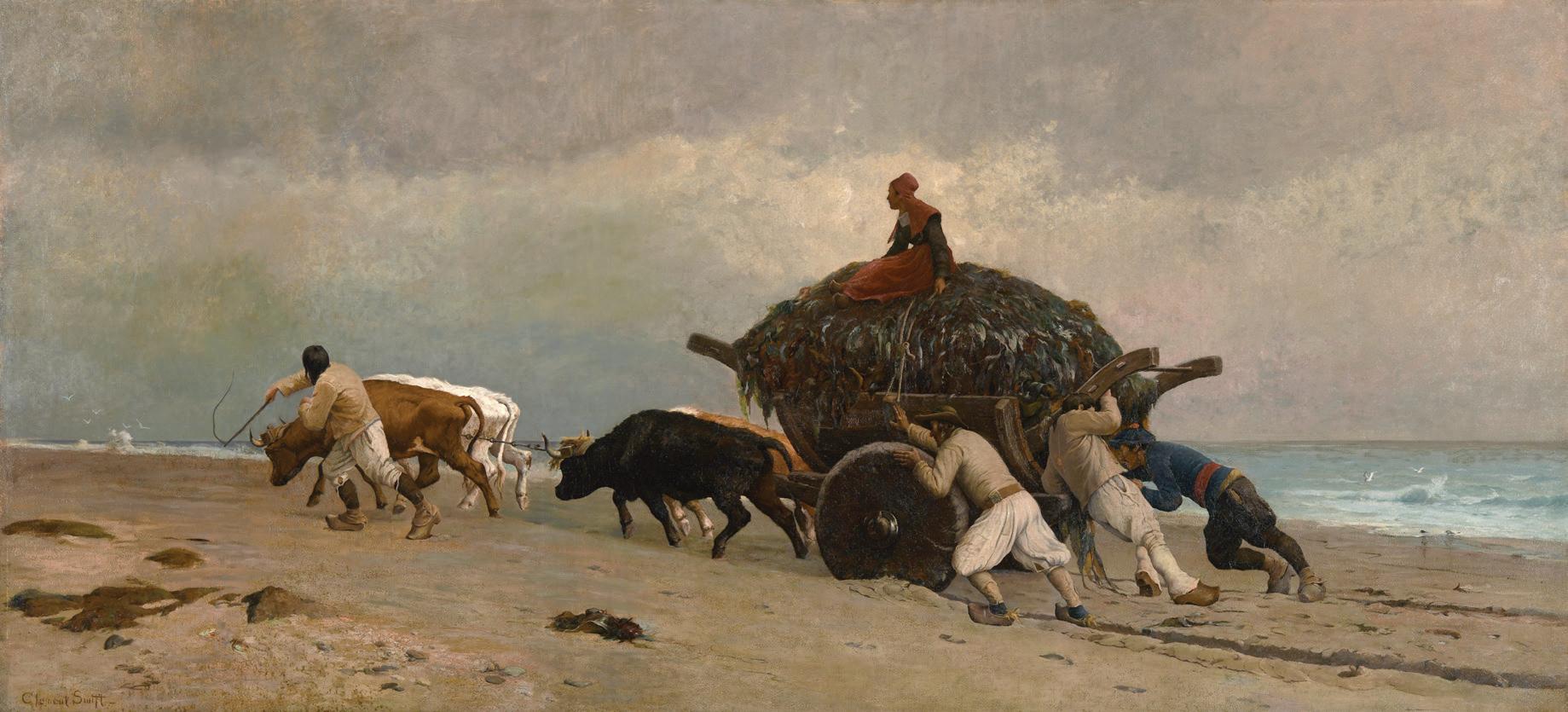
From June 16 – December 3, 2023, the New Bedford Whaling Museum will feature a new exhibition in the Wattles Gallery, A Singularly Marine & Fabulous Produce: The Cultures of Seaweed. This dynamic installation will probe humankind’s fascination with marine flora across the nineteenth century and into today. That keen observer of New England’s natural resources, Henry David Thoreau (1817-1862), described seaweed as a “marine and fabulous product.” We concur, and the exhibit will track a continuous, unwavering cultural interest in this marine vegetation. This unusual exhibition plumbs the archives and collections of the New Bedford Whaling Museum, as well as over fifteen public institutions and private collections along the Eastern seaboard, and a dozen contemporary
artists throughout the Northeast, to tell the story of seaweed’s many material incarnations in subsistence coastal cultures.
Seaweed is a “commons,” or shared natural resource of the shore, that has long been entangled with human culture. For Clement Nye Swift, an aspiring painter and native of Acushnet, MA, the spectacle of peasants and draft animals working together to harvest seaweed on the beaches of northwest France became a large format “Salon-style” painting. This remarkable work came home with him after a decade spent studying art in the studios of Paris and in the artist colony of Pont Aven in Brittany, and is now in the collection of the New Bedford Whaling Museum. It serves as the focal point of an exhibition
53 | Spring/Summer 2023
Exhibit Highlights
Fig. 1. Clement Nye Swift (American, 1846-1918), Seaweed Gatherers, 1878. Oil on canvas, 41 x 93 in. (104.1 x 236.2 cm.), New Bedford Whaling Museum, Gift of the Russell Memorial Library of Acushnet, Massachusetts, 2015.9.1.
that explores how seaweed was viewed, used, and represented in visual art, design, and amateur science of the nineteenth and twentieth centuries in New England, France, and England. On these edges of the Atlantic, seaweed was harvested and exploited for its potential: as fertilizer, food, fuel, a source of iodine, and even as insulation.
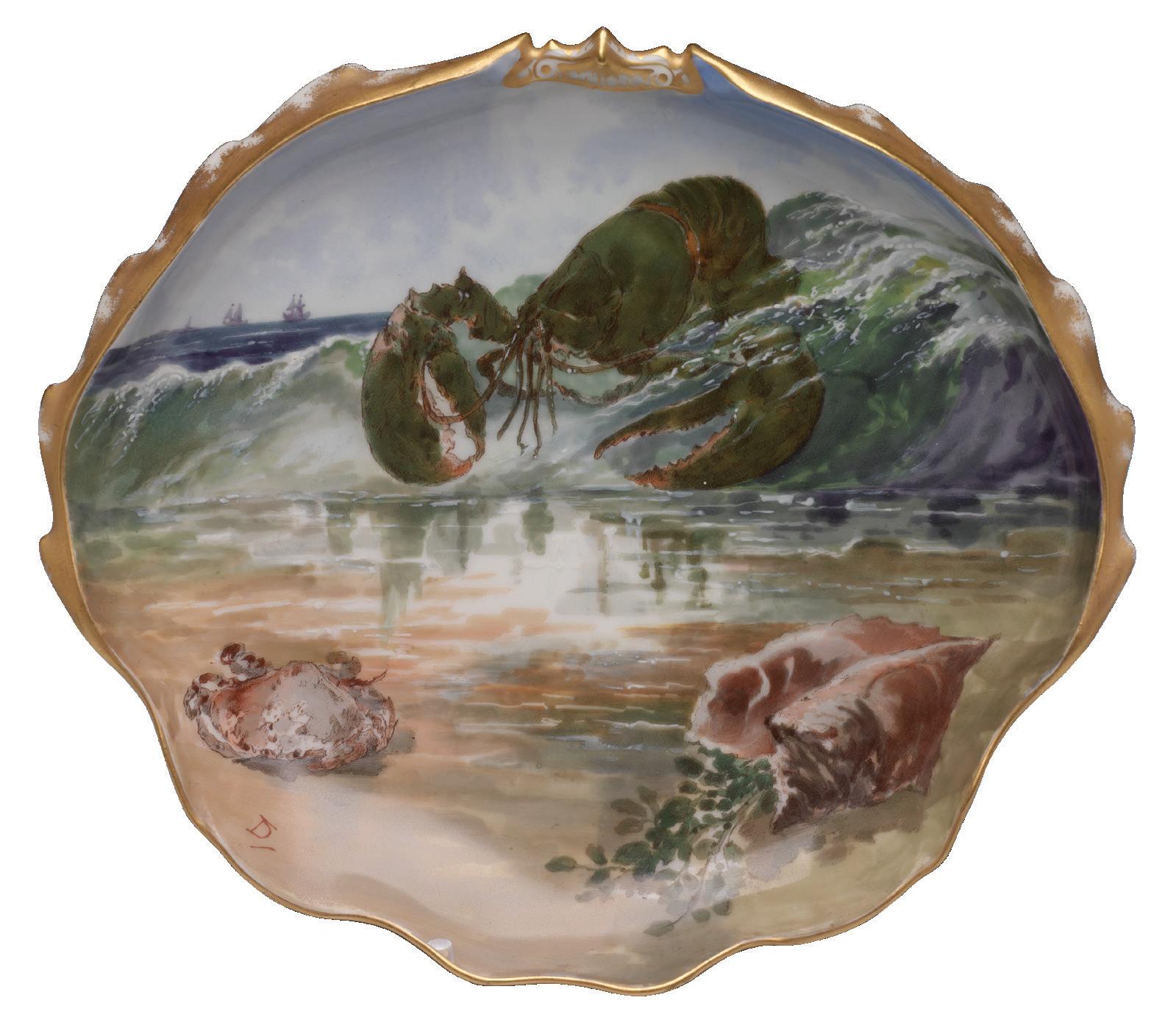
Individuals adopted changing aesthetics and modes of representation to picture this unique material in a wide range of media. The exhibition draws together items from France, the United States, and England, including rarely exhibited watercolors by significant American artists John Singer Sargent (1856-1925) and Andrew Wyeth (1917-2009) to exuberant decorative arts – including glass, silver, and ceramics by Mt. Washington Glass Company, Tiffany and Company, Josiah Wedgewood & Sons, Thomas J. Wheatley, Haviland Limoges, and Georges Hoentschel – to amateur-made seaweed albums, collages, and early salt-paper and cyanotype photographs.
The delicate, intricate shapes of individual plants and dramatic variations of color, shape, and size among species of marine algae made its collection, identification, classification, and preservation a goal of many enthusiastic, amateur marine botanists. In this exhibition, specimens collected and preserved within the past two centuries are put into dialogue with examples of historical seaweed forms in art and design. Looking to natural forms for innovative design or biomimicry has a long history in our relationship to seaweed. Designers evoked the saturated color and playful patterns of seaweed’s many sinuous profiles in textiles, ceramics, glass, and metalworking. They draped seaweed across the surfaces of objects, and studied the repeating patterns and
interlocking shapes that served as environments for sea creatures or stood alone as undersea forests or prairies. Seaweeds were a perfect subject for formal contemplation for modernist painters, cinematographers, photographers, printmakers, and sculptors. Contemporary artists continue to find beauty, wonder, and ecological resilience by creating artwork in many mediums with and about seaweed.
Today, marine science is discovering how seaweed farming offers innovative potential for carbon sequestration, food production, improved ocean health, and vibrant livelihoods for maritime communities. This exhibition is an invitation to explore historical and contemporary relationships with seaweed, and celebrate our collective reliance on the coasts and their dynamic ecosystems.
54
Fig. 2. Limoges, Haviland, and Company (French, founded 1842) and Theodore Russell Davis (American, 1840-1894), Seafood Plate, from the Rutherford B. Hayes Presidential Service, c. 1880. Porcelain with enamels and gilding, 9 x 1.5 in. (22.8 x 3.8 cm.), Rhode Island School of Design Museum, Providence, RI, Gift of Christopher Monkhouse, 2003.111. Image courtesy of the RISD Museum.
Common Ground
A Family Reunited
By Emily Reinl, Common Ground Project Coordinator
Since its inception in 2019, Common Ground developed into an important local oral history project including an exhibition that aims to create a broader picture of the Greater New Bedford region and its residents through story-collection. A key goal of the project is to give voice to the regional community. By gathering the stories of individuals, Common Ground presents a diverse, inclusive, and celebratory accounting of the lived experiences of SouthCoast residents.
Ann O’Leary: So growing up in the south end of New Bedford…I would hear stories of my cousins and sisters talking about how my mom...My cousins and my sisters knew that, thought anyway, that there were seven children. But my mom would always just acknowledge the six and…there were no pictures of that side of the family growing up…
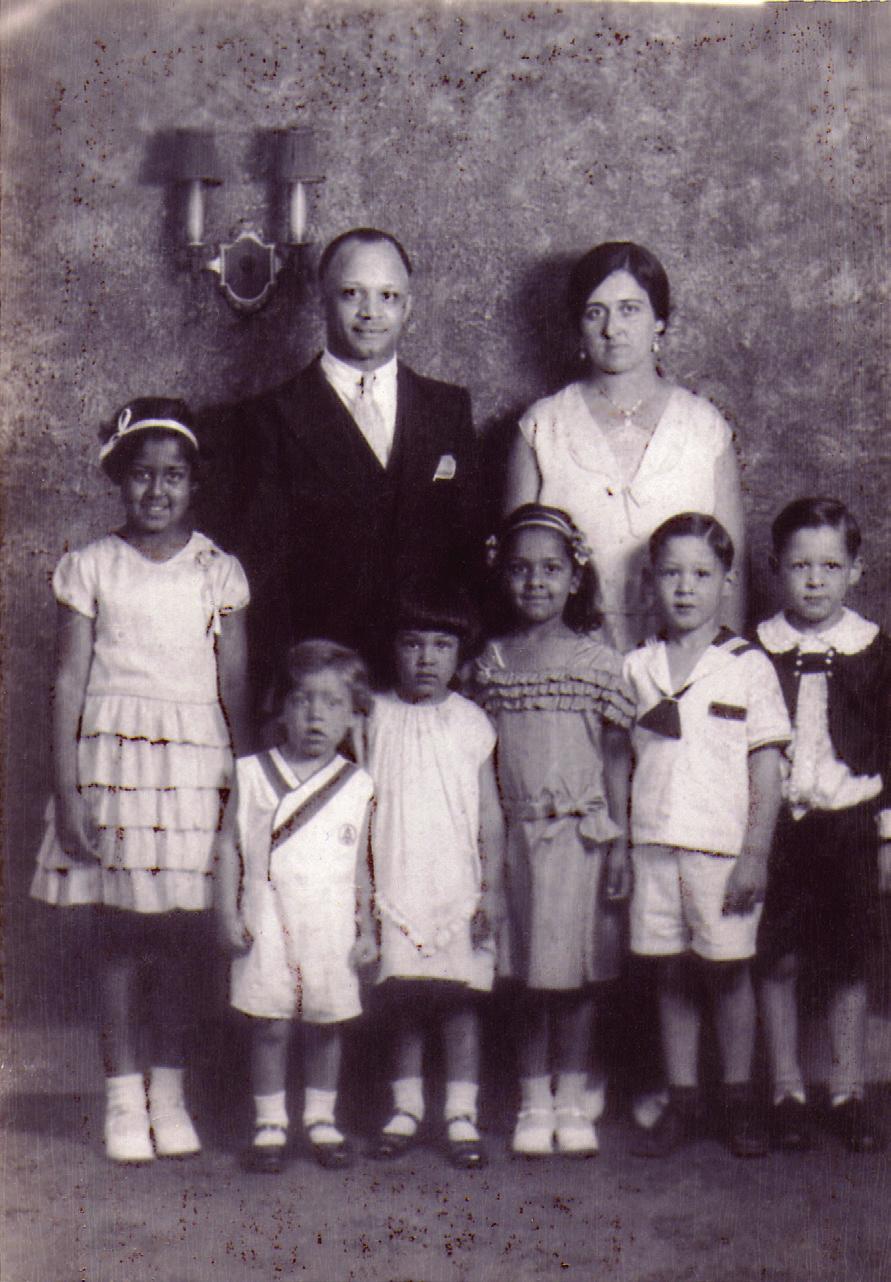
But I did have a cousin who was closer to me in age than my sisters who told me one day that, “We do have an aunt. Her name was Lydia. She left Orchard Street.” Where we lived. “She left the family home when she was 20 and she never came back.” And we would just keep questioning that. And eventually the story was that she married a man whose last name was Ramos and he was Cape Verdean and [Lydia’s parents disowned her]...We were all sad about that and my oldest sister would say, “Well, why don’t we just find her?” And so we found out some things. We found out that my mother was actually 10 when Lydia left the house. And we also found out that she perhaps came back one day and knocked on the door, but they didn’t accept her back. So that was it.
Most Common Ground storytellers tell individual stories, but Ann O’Leary and Jasmine Duncan felt it was important to tell their family’s story together. Read on to hear, in their own words, how they reconnected two estranged halves of their family:
Now my sisters tried to find her, but she...changed her name. We found out later to Eva and she even changed her last name. So, although she stayed in New Bedford and raised children…as Eva Ramos, we just didn’t…know that she had changed her name. So knowing that though, we just kept living our lives. And in 2021, my oldest sister who’s in her eighties said to me, “I still can’t believe that we have never [found her] for over 40 years.” She told me, “How do you not know that last name Ramos? How does that name not come up? And how did you never meet Lydia?” And I’m like, “I don’t know Louise Ann. I don’t know how we never met Lydia.” And then something happened on April 16th, 2021.
Jasmine Duncan:
Hi, my name is Jasmine Duncan. I am a senior at
55 | Spring/Summer 2023
Fig. 1. Eva’s family. Back row: Joseph Ramos and Eva (Lydia) DeMello Front Row, left to right: Dorothy (Ramos) Livramento, Norman Ramos, Blanche Ramos, Josephine (Ramos) Andrews, Alfred Ramos, and Joseph Ramos, Jr.
Bishop Stang High School and I am Lydia/Eva’s greatgreat granddaughter. I have always been interested in this...Known and heard about Ann’s side of the family, but I, being a child just understood they were separated. There was no contact, but we knew they were in New Bedford. We knew they existed, but just never met anyone in person. And then one day, throughout the year prior, so 2020, I had actually looked at Ann’s mother, Louise’s, obituary online and just looking and looking at her children. I see Helena, who is the only one my family knew about. I see her sister Louise Ann, and then I see Ann O’Leary. “I’m like, I know…her as my school’s librarian, am I sure is this real? I’m not sure.” And I waited a good year, maybe 10 months, to actually confront her in 2021 because I had no clue...how that would go.
So that day, April 16th, the courage was building up in me to do so. And I went one day after school to the library and asked if first of all she had ever heard of the surname Ramos. And I remember [Ann saying] “Yeah, there’s many in New Bedford.” And then I had brought up a picture of [Eva’s family]…So I, in short term say the whole story of I am the second great-granddaughter of Eva and I believe you are my relative, you are my cousin. And I just remember you
bursting into tears…I didn’t know how to respond… But I just do remember that whole rest of that [day sharing] information that we could share to try to figure out and share each part of our information… My grandmother is Ann and her siblings’...cousins who they had never met. So my side of the family has a lot of siblings, cousins, aunts, uncles, there’s a whole bunch of them...We had, I believe over the summer of 2021, tried to get those…cousins of my side to meet Ann and her sisters.
And we did make that happen the summer of 2021… [My great-grandmother’s] brother, he’s the only one still living…out of [Eva’s] children...And I remember him saying throughout his life, he has never known first cousins. So this was a very prominent moment… of his. It was just a very great connection…to have.
Ann O’Leary:
I…can’t know why my grandparents did what they did. I can’t speak for them and I’ve even spoken to Jazzy and her mom about this. But we can do the right thing now.
Jasmine Duncan: We’re moving forward.
To read or listen to Ann and Jasmine’s full story, visit the story archive at https://www.commonground.whalingmuseum. org/. Visit the Common Ground exhibit, open now through August 6 at the New Bedford Whaling Museum.

56
Fig. 2. Family reunion at Bishop Stang. Front row (first cousins), left to right: Cynthia (DeMello) Linhares, Leonard Ramos, Louise Ann (Rodrigues) Pearson, and Ann (Rodrigues) O’Leary Back row, left to right: Armando Linhares (Cynthia’s husband), Sandra (Livramento) Grace, Jazzy Duncan, Blanche (Andrews) Perry, Sheryl Duncan
“All Hands”: Yankee Whaling and the U.S. Navy
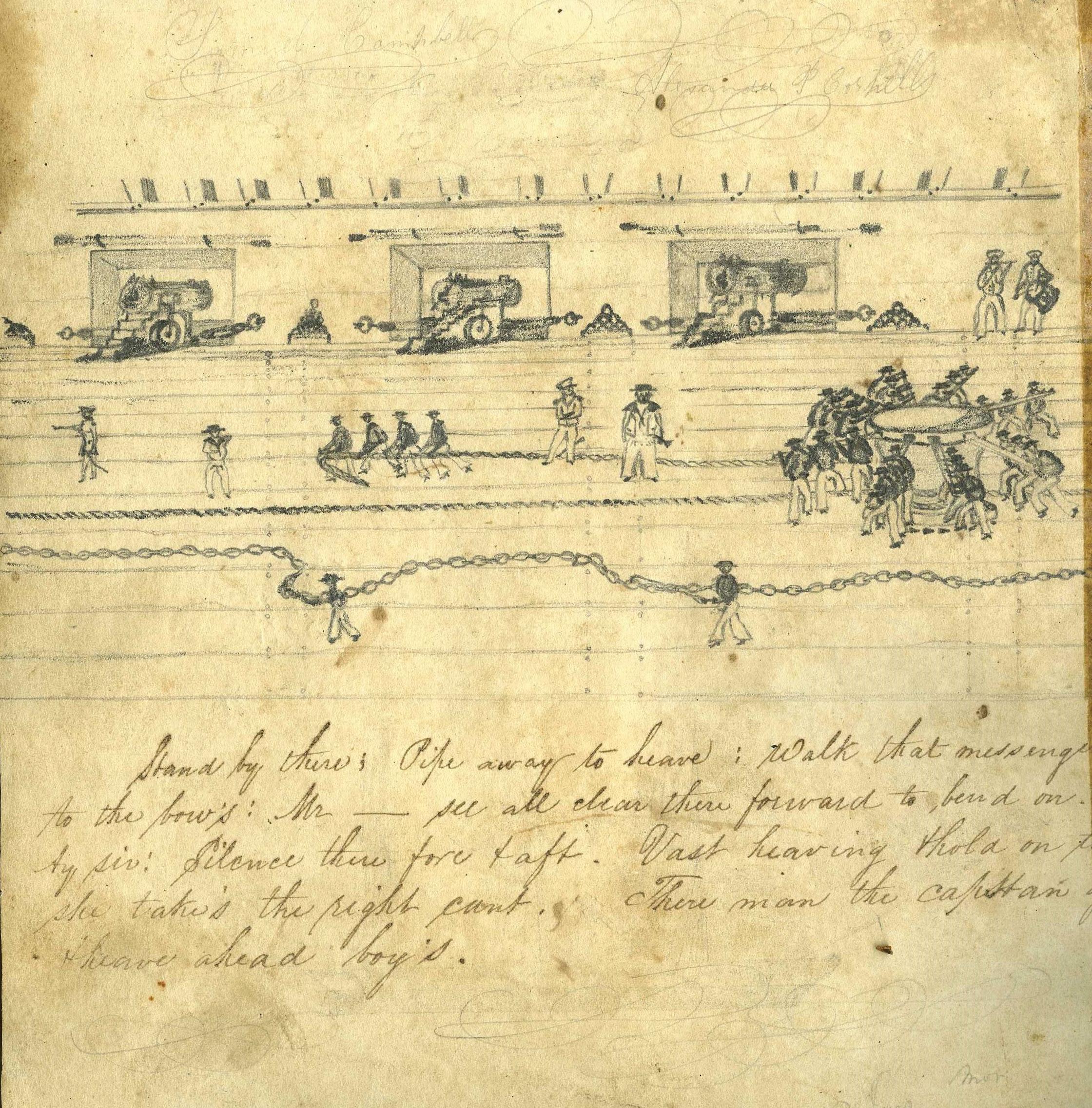 By Emma K. Sylvia, former Visitor Experience Associate
By Emma K. Sylvia, former Visitor Experience Associate
In some respects, American whalemen were pioneers. Colonial whalemen developed a sperm whale fishery in the early eighteenth century taking voyages into the deep ocean for months at a time.
As British subjects, they were under the protection of the British Navy. After the Revolution those protections disappeared and American commerce needed support. Whalemen commonly braved their
57 | Spring/Summer 2023
Fig. 1. Alexander Cornell. “Crew of the Porpoise preparing to weigh anchor,” 1849. Pencil on paper. Cornell was a seaman on the whaling bark Barclay of Westport who went onboard US brig of war Porpoise at the Isle of Sal, Cape Verde in 1849 and made this sketch in his journal. Lieut. Charles Wilkes commanded the Porpoise on her earlier coastal surveying voyage in 1837 and she was later part of the U.S. Exploring Expedition. NBWM, KWM 27.
way through uncharted seas and visited the shores of remote lands in search of often-elusive whales, massive creatures whose oily composition greased the gears of industrialization and innovation. In addition to spermaceti wax, sperm oil, and whale oil, some whales also provided baleen, the “whalebone” of commerce. While whalers were often alone on this pelagic frontier, their seafaring skills shared common origins with another maritime counterpart, the United States Navy. By the early nineteenth century, these two services together pushed the bounds of navigation, exploration, international politics, and commerce.
The New Bedford Whaling Museum’s upcoming exhibition, All Hands: Yankee Whaling and the U.S. Navy (September 1, 2023–February 26, 2024), will highlight and elaborate on the little-known connections between whaling and the Navy. It will feature a thoughtfully curated array of objects, including scrimshaw, sea charts, logbooks, illustrations, and personal artifacts, to form a captivating narrative of this important reciprocal relationship.
This relationship was forged by an abiding sense of patriotism and pride, which in turn sustained a mutual respect; the Navy was first created to protect commerce, American ports and overseas shipping, including the whaling fleet. Whaling endowed the Navy with purpose, particularly in the Pacific Ocean: if whalemen pushed the boundaries of influence on the high seas, then the Navy came to act as their security, and in some cases, such as rounding up mutineers, a police force.
Whalemen and Navy personnel shared similar, but disparate, work histories. The Navy came to value experienced whalemen as navigators and brave fighters. Whalemen would join the Navy during wartime, or, as Herman Melville once did, as a means of conveyance on their journey homeward from distant places. Like whalemen, Navy personnel were known to produce scrimshaw and gained specialized skills common to both trades. These close bonds will be exemplified throughout the exhibition, from scrimshaw depicting impressive naval engagements to detailed illustrations of naval frigates found in whalemen’s journals.
However, the connection between whaling and the Navy is perhaps best summarized by a scrimshawed whale tooth proclaiming “Free Trade and Sailors Rights”; this popular phrase not only captures the sentiments of the time but also inadvertently points to the origins of this special relationship. It was in the early nineteenth century during the Napoleonic Wars, when Britain was at war with France when American sailors were captured on the high seas and forced to serve in the Royal Navy by the thousands, a practice known as impressment. The fledgling United States declared war on Britain in 1812, citing impressment among the causes and merchant seamen, terrified of being fed to slaughter in the British Navy, celebrated American Naval strength. The U.S. Navy matched the much larger and better equipped Royal Navy in several decisive victories, but the wars caused American ports to be blockaded and commerce languished. Sperm and whale oils was one such valuable commodity. The whaling fleet in the Pacific Ocean was afforded special protection, particularly by Captain David Porter and the frigate Essex, and American naval victories were commemorated on whaler’s scrimshaw for generations to come.
Many military conflicts occurred during the peak period of the whale trade. Numerous whalemen enlisted in the US Navy during the Civil War, with some even earning medals of honor for their service. Joaquim Pease, a Cape Verdean immigrant whaleman, joined the Navy and served onboard the USS Kearsarge at the Battle of Cherbourg, when the Confederate commerce raider CSS Alabama was destroyed. Pease earned the Medal of Honor; this medal will be exhibited in the show. Beyond acts of valor, there were figures that leveraged their knowledge of the trade in an attempt to turn the tide of the Civil War. Before his time as a Confederate commander, Raphael Semmes worked for the U.S. Treasury department buying sperm oil for lighthouses, which was then the largest market for American sperm oil. He later commanded the infamous commerce raider CSS Alabama, whereon he targeted whalers and the invaluable oil they carried as a detriment to the war effort.
Even as whaling faced decline and dissolution in the early 20th century, the trade managed to retain
58

59 | Spring/Summer 2023
Fig. 2. Gordon Grant (1875-1962), Will You Supply Eyes for the Navy? Navy Ships Need Binoculars and Spy-Glasses (New York: Sackett & Wilhelms Corporation), c. 1917-1918. Photomechanical print on paper, 29 x 21 inches, NBWM, 2022.60.
relevancy, and in turn created shared legacies. Almost fifty years after the conclusion of the Civil War, the U.S. Navy, under the direction of the Secretary of the Navy, Franklin Delano Roosevelt, a descendant of investors in the Fairhaven whaling industry, began requesting navigating instruments from mariners for use in the North Atlantic during World War I. On exhibit will be one such example, a sextant once belonging to whaling master Daniel W. Gifford, as well as an advertisement created by the Navy to encourage mariners to donate their “eyes,” or unused instruments, to the cause.
Most remarkably, however, whaling contributed greatly to exploration and advancement in cartography. Given the trade’s dependence on the range and migratory habits of various whale species, whalemen often found themselves far from home, in foreign waters and on strange lands. This was especially true in the 1820s and 1830s, when whaler’s started to venture further into the vast Pacific. To further cartographic and hydrologic knowledge, there were numerous expeditions led or in part aided by naval personnel. Artifacts and accounts from these expeditions will be on exhibit, such as a sampling of those retrieved during the U.S. Exploring Expedition (1838–1842) led by Lieutenant Charles Wilkes. These artifacts later formed the foundation of the Smithsonian Institution’s collection.
Similarly, in the mid-1800s Lieutenant Matthew Fontaine Maury undertook an enormous project to chart global winds and currents. As a well-respected researcher, indeed, a pioneer, in hydrography and oceanography, earning the nickname “Pathfinder of the Seas,” he compiled and analyzed countless logbooks from whaling voyages to compile wind and current data. Additionally, he applied that data to tracking whaling grounds and the locations of various whale species by creating and distributing special logbooks for mariners, including whalemen, to record their observations at sea. The result was a massive collection of data that he formulated into a guide for maritime navigation. On exhibit will be selected excerpts from his work, logbooks, and letters, as well as the charts he created in part using data from whaling voyages.
All Hands will offer visitors a rare glimpse into an overlooked yet vitally important relationship in American maritime history between whaling and the US Navy, as well as a view into the past through a collection of objects significant to this connection. The objects in the exhibition will magnify personal accounts, exploring the relationship between American whalemen and the United States Navy, highlighting these contributions not only to whaling history but to the American historical narrative as a whole.
60
Book Reviews
culture in America with the majority of the thirty-seven colonial newspapers located in the north. Boston’s first paper began in 1704, while the first newspaper in Virginia was printed in 1736.
Chapter 1 focuses on early slavery in New England with an examination of English exploration, colonization, and the need for cheap labor. English colonists had already tried to force Indigenous communities to provide labor. When that did not work, indentured servants and eventually African slavery was used to provide the cheap labor needed to build the colonies. New England also became the center of the Caribbean slave trade of the eighteenth century, with Rhode Island merchants, ports, and ships being primary participants. Hardesty delves into the removal of Indigenous communities from their tribal lands and efforts to enslave these people ending the chapter with a discussion on the economic connections between New England, the Caribbean, and the eighteenthcentury sugar revolution.
Black Lives, Native Lands, White Worlds – A History of Slavery in New England
Jared Ross Hardesty
Amherst and Boston, MA: Bright Leaf: An Imprint of University of Massachusetts Press, 2019. 198 pp. Softcover, ISBN: 978-162534-457-1, $22.95
Black Lives, Native Lands, White Worlds provides a concise and readable history of slavery in New England. Hardesty arranges the history chronologically and topically. He uses primary resources, such as diaries, court papers, account books, probate letters, and other primary and secondary resources to elucidate the short history of New England slavery, particularly in Massachusetts, from the 1640s until the 1780s. He argues that the documentary evidence for this topic is rich because New England was the center of print

Chapter 2 uses four case studies to examine human trafficking and slavery during the seventeenth and eighteenth centuries focusing on runaway advertisements, a will, and other first-person narratives about life in the colonies. His language in this chapter is a reminder that New Englanders saw the slave trade as the commodification of people into property and not as humans. He explains how,
“Both the informal and formal slave trades altered New England’s demographics. Nearly twenty thousand enslaved Africans and Indians poured into the region between 1700 and 1775. While the enslaved population never comprised more than 3 percent of the region as a whole, urban centers such as Boston and Newport housed large enslaved populations. Still, rural towns, such as Deerfield, Massachusetts, were sometimes home to dozens of enslaved people by the middle of the eighteenth century.”
He goes on to examine the world of the slave
61 | Spring/Summer 2023
in New England society. New England’s strong religious community overtones resulted in a highly patriarchal society with household members yielding to the authority of the male head of the household resulting in dependence upon the head of the house. Everyone in the household was under that person’s control. Enslaved people were at the bottom of the social hierarchy, but still had access to institutions in New England such as the legal system and religious organizations. During the seventeenth and eighteenth centuries, New England societies began to divide along racial lines where enslaved Africans and Indigenous people were less likely to be considered as humans, much less equals. Slavery moved from being a temporary condition to a lifelong condition. At this point, Hardesty begins deliberation on the differences between northern and southern slave-holding societies. He explains that New England’s slave-holding society is often described as less brutal because enslaved people lived in close contact with their enslavers, unlike the large plantation communities in the south. This close proximity meant that through a higher level of scrutiny, northern enslaved people may have had less control over bodies and chances to form outside relationships. Nonetheless, New England had no formal legal slave codes, meaning that enslaved people did have some opportunity to gain literacy, to make money, and possibly even to own property.
In Chapter 4, Hardesty explores the work life of enslaved people in New England. Here he uses advertisements to show how enslaved people worked and again highlights some of the differences between the urban versus agriculturally based slave societies of the north and south. Enslaved people worked as domestics, blacksmiths, printers, bricklayers, musicians, and farmhands and, as might be expected, more enslaved people worked in seaports, like Boston, Massachusetts or Newport, Rhode Island, than in rural communities. Enslaved people in the northern colonies could also hire out their services to others, negotiating fees for their work. This self-hire and hire-out system provided the enslaved with some monies and saved the owners money on upkeep of their human property.
Despite living lives in a slavery society, Chapter 5 illustrates how enslaved people formed communities, friendships, and families in a world not favorable to them. Legally, enslaved couples could not be married. Most had formal (with the enslaver’s permission) or informal relationships with both enslaved and freeborn partners. Enslaved men, like Kofi Slocum (father to Paul Cuffe) married Indigenous women because they wanted their children to be free and there were fewer enslaved women in New England than Indigenous women. Enslaved people formed religious communities, attending church with their enslavers but also conducting services with itinerant ministers who might also be enslaved. Being part of a religious household might offer the opportunity to become literate, as northern enslavers did not prohibit reading to the same extent as the southern slave society. A by-product of this access to literacy is that enslaved and formerly enslaved people in New England began and maintained an intellectual tradition not seen in the south.
Chapter 6, the last formal chapter, addresses the decline of slavery in New England during the 1760s and 1770s. This period coincides with the advent of the fight for American independence and enslaved people saw themselves as participants in that battle. Beginning in the 1760s, British colonists in North America began to question the impact of royal governance on their lives and thought about independence. As the colonists questioned their desire for freedom from the crown, some also began to question the morality of African slavery and the natural rights of man, white or black. Arguments for freedom came from all segments of the population, from religious leaders to political leaders to the free African population in New England. The ability to self-emancipate through paid work, intermarry with free Indigenous women, and achieve a higher literacy rate than in other colonies led to the growth of a free black population that recognized that freedom and American independence was something that all people deserved. Enslaved men, formerly enslaved men, and freeborn men all participated in the battles for American independence, whether
62
as “Americans” or “Loyalists.” The Continental Army was integrated at this time, even though the American military did not remain this way. After the war, freeborn black men and formerly enslaved men questioned state laws petitioning for the right to vote based on property rights. Finally, Hardesty addresses how New England dismantled slavery, in some cases utilizing gradual emancipation. This phased out slavery but still obligated enslaved people to serve enslavers until their 20s.
Even with gradual emancipation, there were still enslaved people in New England until the passage of the 13th Amendment in 1865, which outlawed slavery. While most formerly enslaved people were free, they suffered from the effects of racism based on new theories of the inferiority of those of African descent. This impacted economic status, living status, and labor status. In addition, memories about the brutality of African slavery diminished with the current population and this history became whitewashed.
Why read this book, you ask? Hardesty acknowledges the dearth of books on the history of New England slavery. Over the past twenty-five years, academic scholars such as Professor Hardesty have added to the written record with the publication of this book and other books including Wendy Warren, New England Bound: Slavery and Colonization in Early America (New York, 2016). Prior to 1990, the best-known books on this topic were Lorenzo Johnston Greene, The Negro in Colonial New England (New York, 1942) and William D. Piersen, Black Yankees: The Development of an Afro-American Subculture in Eighteenth Century New England (Amherst, 1988). Greene’s book used secondary sources to address the history of enslaved Africans and formerly enslaved African Americans in New England. Dr. Piersen’s book, written forty-six years later, added to the written record on this topic. Professor Hardesty and Professor Warren, as well as other academic scholars, are trying to stimulate the conversation on the history of slavery in New England with increased and improved scholarship.
Professor Hardesty has written a concise yet comprehensive book that is readable and hopefully of interest to public historians and the general public. Today’s scholars are attempting to address and refute
the well-crafted and mythological narrative that slavery in New England was benign and drastically different than slavery in the southern region of what was to become the United States. This narrative of benign slavery continued because slavery in New England was abolished much earlier than Southern slavery. A variety of efforts in New England ended human enslavement and included self-emancipation through purchase or legal means, gradual emancipation, and, finally, a general regional belief in “life, liberty and the pursuit of happiness.”
Yankees in the Indian Ocean: American Commerce and Whaling, 1786-1860

Jane Hooper
Athens, OH: Ohio University Press, 2022. 247 pp. A map. Hardcover, ISBN: 978-0-2268-0304-3, $72.00
63 | Spring/Summer 2023
— Janine V. da Silva, New Bedford Whaling National Historical Park
Being the seventh volume in the Ohio University Press Indian Ocean Studies Series, Yankees in the Indian Ocean opens an important dialogue around several marginalized chapters in American maritime history. These include commerce and trade, the whale fishery, developing diplomatic relations around the western Indian Ocean, the slave trade, and a certain nineteenth-century ennui in American national interest in the region. Various international crises of the twentieth century necessitated a strategic military base to be established at the mid-ocean islands of Diego Garcia but for much of the nineteenth century American strategic interests in the region centered around the South Atlantic and East Indies and not the east coasts of Africa and the islands of the ocean. Hooper’s main argument in the book, as she articulated it in a 2022 interview for the web site Current is:
Despite their inability to transform temporary encounters into formal imperial relationships, Americans would shape the development of commercial connections throughout the ocean, support illegal slave trading, and contribute to environmental degradation on the smallest islands of the ocean.
Oddly enough, in some ways, historical understanding of American maritime activities in the Indian Ocean seems best reflected by Moby-Dick; unless whales were to be found, it was simply a body of water to be crossed en route to better things someplace else. It is true that a great body of literature surrounds Americans in the Indian Ocean. Several whaling narratives offer important insights and voyage documentation including important ones like Ben Ezra Stiles Ely, There She Blows: A Narrative of a Whaling Voyage in the Indian and South Atlantic Oceans (Philadelphia, 1849, reprinted 1971); J. Ross Browne, Etchings of a Whaling Cruise (New York, 1846), and Charles H. Robbins, The Gam (New Bedford, 1899), as well as the more systematic types of maritime history like George Granville Putnam, Salem Vessels and their Voyages, 4 vols., (Salem 1924). Hooper mines the whaling texts in her arguments but oddly, while listing volumes 3 and 4 in her bibliography, does not include Putnam’s volume 2 which focuses specifically on Salem and the Zanzibar trade.
Nonetheless, even a major maritime historian like Samuel Elliot Morrison, in The Maritime History of Massachusetts (Boston, 1921), summarizes American trade there as tangential to more lucrative enterprises in China, India, and the East Indies. Hooper breaks this pattern. Over six chapters, she first explores whalemen’s perceptions of the people and landfalls as exotic destinations. She moves on to analyze Salem’s near-monopolistic trade with Mahajanga, Madagascar, for cattle and hides between 18201845, describing how that trade shifted toward Zanzibar and its valuable ivory, ebony, gumcopal and cloves. She describes the significance to whalers of Saint-Augustin Bay off the Mozambique Channel in southwestern Madagascar, describing in the next chapter the environmental havoc that whalers wreaked on smaller islands, particularly the Seychelles, Maldives, and Kerguelen, in their endless quest for free provisions. In the final chapters she examines American attitudes towards the East African slave trade as it expanded from its age-old north/ south propensities generated by Arabs, toward the chattel slavery of the Americas. This trade had been declared illegal by the U.S. (1807), Great Britain (1807), France (1818), and eventually the Portuguese colonies (1869), but remained very lucrative, even by mid-century, as captives were transported to ports in South America and the West Indies.
She concludes by highlighting an 1836 episode where a native burial ceremony at Saint Augustin overlapped with a whale ship’s Fourth of July celebration. The trappings of each assumed much the same pattern, where the American flag was held in esteem and guns were fired in recognition and respect. From this event she suggests that American influence there had reached a profound depth in the native consciousness.
Americans came very late into this ancient sea where Arab dhows followed the monsoons in the slave trade along the east coast of Africa, Portuguese caravels rounded the Cape on the seaway to India, Dutch East-Indiamen made their way to and from the spice islands of the Indies, and British East Indiamen forged the girders of their global colonial structures. Even so, the weight of the American whale fishery was felt from the earliest voyages to Delagoa Bay in Mozambique in the 1790s. At least forty-three American whaling
64
voyages visited the waters between South Africa and the Mozambique Channel from 1789-1819. From that period until the 1880s American whalers hunted sperm whales across the entire ocean from the Gulf of Aden to the Timor Straits, and engaged in extensive right whaling in the southern seas and onto the coast of Western Australia. They used ports of call around the Indian Ocean as they did elsewhere around the world; mainly for obtaining fresh water, fresh food, and firewood.
Whaling merchants liked to target the migratory species of black whales (Eubalaena australis), which, with their generally predictable movements, ensured a return on investment in a relatively short time-frame. Right whaling of this sort predominated in the region with sperm whales being taken as chance allowed. Whaling, more than any other branch of American marine commerce, by its sheer numbers effected the region. Its inherent extractive nature stressed the ecologies of isolated, unpopulated, island groups, and pushed larger, more established, populated places like the ports of Madagascar, into unsustainable trade patterns. Hooper examines these events and relationships in detail.
Yankees in the Indian Ocean would be challenging for the general reader, but it answers many questions and shines light on a number of specialized fields of study. The notes and bibliography are very impressive and useful. Among the challenges to the reader, however, is voyage documentation. The book would be an easier read if the voyages were described in the established standard format including rig, vessel name, port of registry, master, and dates. The first sentence of the Introduction, for instance, identifies an individual observing the coast of Madagascar “from the deck of the Delta” in 1837. The source is a journal held at a public institution, but the voyage is not identified either in the text or the notes. It is the ship Delta of Greenport, NY, Seth Griffing, master, on a right whaling voyage to the South Atlantic, 1836-1838. Greenport specialized in right whaling which explains its presence in those waters. The journal was kept by the carpenter, a man named Leek whom Hooper has identified by first and last name without any supporting documentation. This lack of voyage identification (and general lack of biographical
background for individuals) runs throughout the book giving the reader the task of identifying the voyages properly. Likewise, the volume includes one small map, and no other illustrations of the locales being discussed. As the physical appearance of those locales figures significantly in her historical analysis of them from the viewpoint of the sailors, it would be helpful to both see them identified on a chart, and to see contemporaneous views. Despite these criticism, the book definitely fills a gap in maritime history and with its solid bibliography sets a path for further study.
Connecting Women: National and International Networks during the Long Nineteenth Century
Barton C. Hacker, Joanne Paisana, Margarida Esteves Pereira, Jaime Costa, and Margaret Vining

65 | Spring/Summer 2023
— Michael P. Dyer, New Bedford Whaling Museum
Edited by Barton C. Hacker, Joanne Paisana, Margarida Esteves Pereira, Jaime Costa, and Margaret Vining. Washington, D.C.: Smithsonian Institution Scholarly Press, 2021.
269 pp. Footnotes, bibliography and index. ISBN (Paperback) 978-1-944466-44-2. Online resource.
The world is currently witnessing both one of the largest, prolonged attacks on women’s rights and autonomy, and some of the fiercest, most widespread protests against such attacks. Yet one cannot help but notice, for example, how the fights for abortion rights in the United States and women’s rights in Iran are connected to women’s activism in the past. At their best, women’s movements are inclusive and intersectional. At their worst, they are exclusionary and disconnected. During the period of Reconstruction in the U.S., for example, the woman suffrage movement split into two camps: one that supported the 15th amendment granting Black men the right to vote, another predicated on racist ideologies demanding that White women earn the vote before Black men.
The framework for Connecting Women: National and International Networks during the Long Nineteenth Century rests on these two simple truths: that collectivity and solidarity is a fundamental ingredient for rights-gaining movements, and that not all networks have been inclusive. Each of the eleven essays in this volume probe the ways in which women’s networks throughout the long 19th century have been either inclusive or exclusive, or in some cases, both. The collected edition is divided into two sections: the first focuses on women’s activist networks and their influences, while the second examines the relationships between women and literary networks.
Coming out of the second conference of the Intercontinental Cross-Currents Network, this collection explores an appropriately diverse array of topics. These range from Barton C. Hacker and Margaret Vining’s examination of the relationship between technology and transatlantic activism, to Katherine G. Lacson’s exploration of the imagery of Filipina suffragists, and even Paula Guimarães’ analysis of the ways in which British women poets negotiated complicated social, political, and artistic networks. The essays offer different perspectives on how women’s activism functioned in numerous locales and at various points in time. Further, each
essay draws upon sources and methods from various disciplines: Lacson, for example, examines both visual culture and textual sources, whereas Guimarães draws upon the writings of authors who she examines.
As this collection illustrates, women’s activism has historically been transnational in nature. In many instances, this kind of activism has involved physical movement, even across oceans. Sirpa Salenius’s essay on abolitionist Sarah Parker Remond, for instance, explores how Remond’s participation in “international interracial networks and upper-class social circles… validated her reassessment of Black womanhood.” Transnational activism, however, has not always involved direct communication with people in other spaces. For instance, as Katherine G. Lacson explains, the imagery utilized throughout the woman suffrage movement in the Philippines was on the one hand inherited from the continental United States, and on the other hand a product of the particular cultures of the Philippines. In contemporary periodicals, men represented the female suffragist through the promotion of stereotypes and tropes against the “modern” woman. It was images of traditional maternal women that were considered more suitable for a general audience.
But it is not always the case that women who share a common cause develop an inclusive and interconnected activist network. Many of the essays explore this idea, and the impact of exclusivity more generally. Alice Bailey Cheylan, for instance, explores how well-known American expatriates Edith Wharton, Gertrude Stein, and Amy Lowell formed parallel, but not connected, social networks during World War I. Cheylan aims to answer the central question of why, exactly, these women may not have taken it upon themselves to converse with each other and share ideas; her answer is that the social, sexual, and religious orientations of these three different women likely prevented them from forming such a collective network.
While the essays fit easily within the larger subjects of the two sections (Activist Networks and Literary Networks), where the collection is less cohesive is in the connections across individual essays. For instance, what connects Laura-Isabella Heitz’s piece
66
“Women in Italian and Italian American Organized Crime Networks in the Long Nineteenth Century” with Joanne Paisana’s “Female Friendly Societies in Nineteenth-Century Britain?” One wishes the editors of this volume would have included some guiding commentary at the beginning of each section to better understand these connections.
This collection prompts further research in a number of fields, but especially with regard to how women worked together in transnational spaces, and how these transnational influences may or may not have found a concrete place in local movements. LauraIsabella Heitz, for instance, states explicitly that more work is needed to determine whether the kinds of social structures in place in Italian crime organizations remained the same in Italian American communities.
— Anne Boyd, PhD Candidate, Boston University
67 | Spring/Summer 2023
Looking Back
By Bob Rocha, Associate Curator of Science and Research, and Emma Rocha, Curatorial Assistant
Sometime around 1920, Albert Cook Church (1880-1965) photographed this bizarre assemblage of bones purporting to be a “right whale skeleton.” The skeleton was positioned along the road outside a private museum operated by Charles Q. Eldredge (1845-1938) between 1917 and 1937 and located in West Mystic, CT. Eldredge obtained the bones in 1912 from the estate of whaling captain John O. Spicer of Groton, CT. Eldredge assembled the skeleton himself with no reference images, creating a monster of a whale. The specimen lacked a skull, flippers, lumbar or tail vertebrae. He positioned the mandibles vertically to look like pincers and attached several ribs by the wrong end. Finally, the shoulder blades were located at the wrong end of the whale, fashioned vertically into what could only be guessed was the whale’s tail (real flukes are horizontal, cartilaginous, and lack bones entirely).
The Private Museum of Charles Q. Eldredge was a real old-fashioned curiosity collection. Objects ranged from whaling harpoons and the leather boots Eldredge wore at his wedding, to a candlestick made from the “snoot” of a hippopotamus and a four-foot-long copper-coated cucumber. The whale from which the skeleton supposedly originated was captured by the Schooner Era in Hudson Bay in 1879 when John O. Spicer was master. Regarding the skeleton, Eldredge stated: “When you consider the number of tons of whalebone that this skeleton contains, the high foundation, and platform that it rests upon, it is easy to believe it was quite an undertaking for one man. The ribs, seventeen in number on one side, some of them fifteen feet long, six inches wide, and four inches thick, give some idea of what a mighty fish this was. Many old whalemen, from New Bedford and Sag Harbor, have visited here to see something never met in their experience.” It is undoubtedly true that the whalemen had never seen a whale that looked quite like this one!
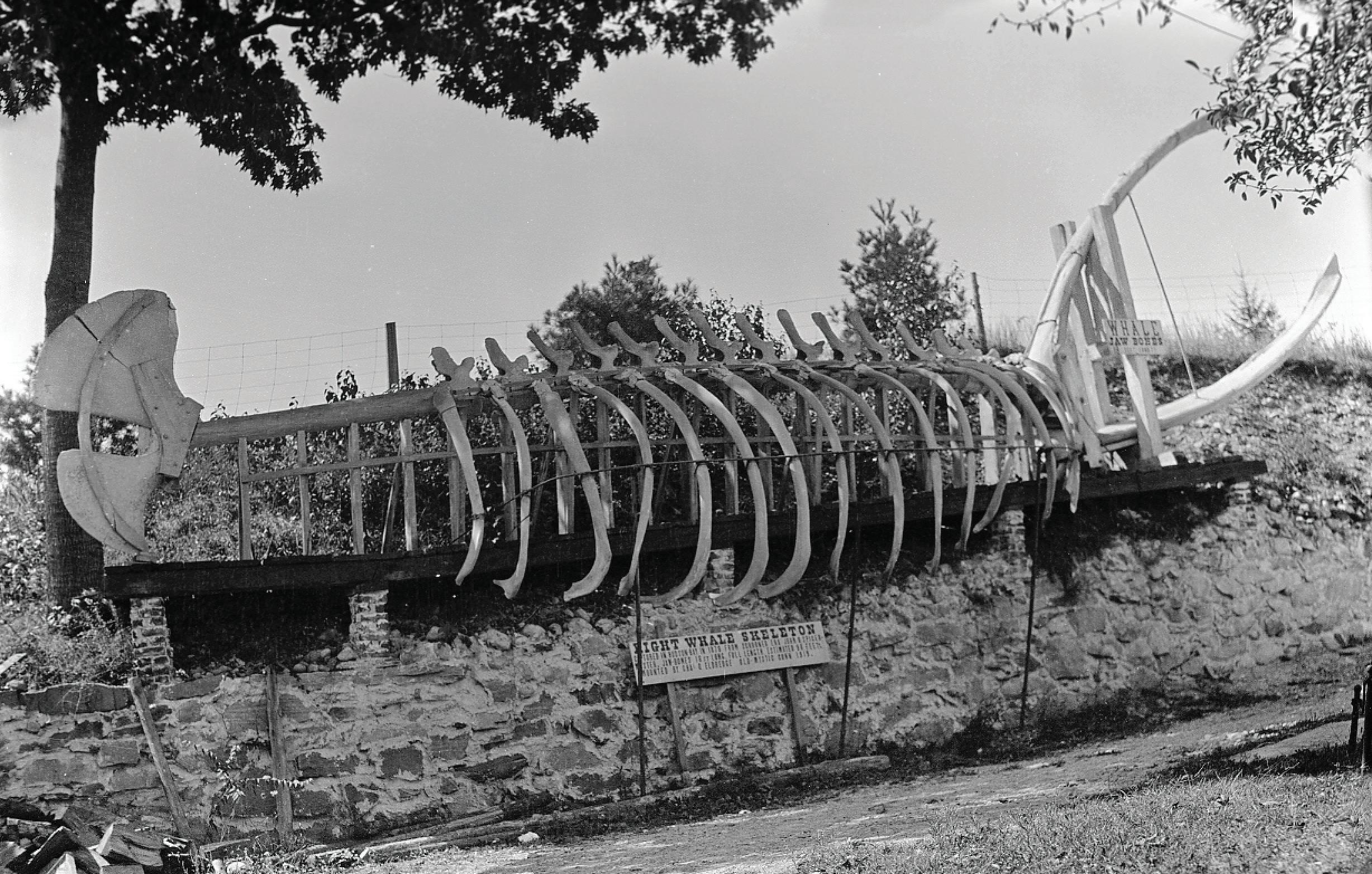
68
Albert Cook Church (American, 1880-1965), Whale Skeleton at West Mystic, Connecticut, c. 1920. Nitrate negative, 4 x 5 in. (10.4 x 12.7 cm.), NBWM, 2001.100.86.833.
18 Johnny Cake Hill
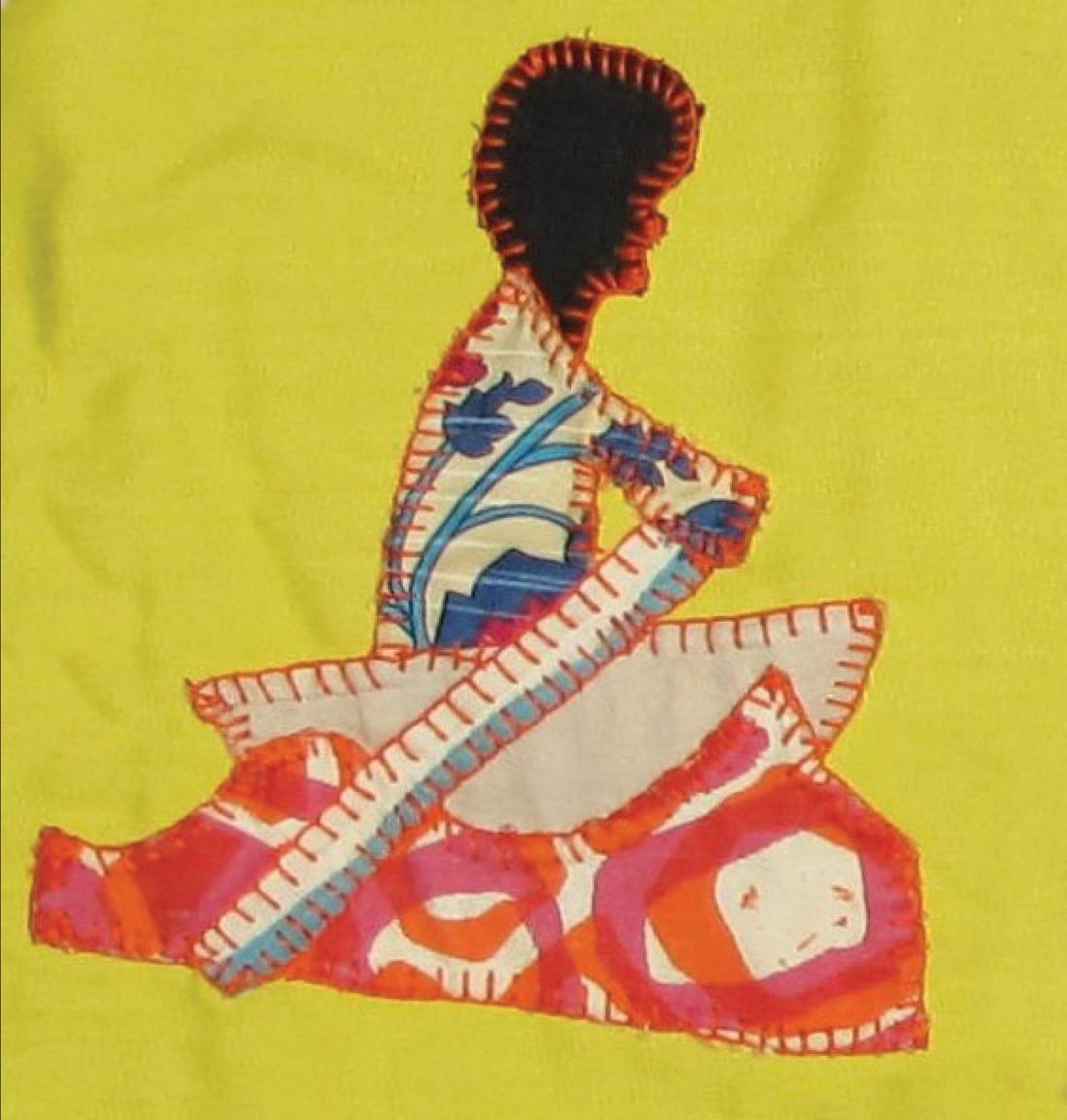
New Bedford, MA 02740
www.whalingmuseum.org
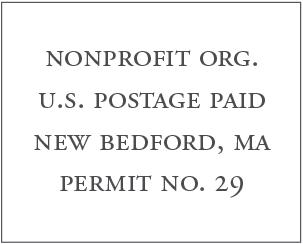





























 By Aidan Goddu, Undergraduate Curatorial Intern, New Bedford Whaling Museum
By Aidan Goddu, Undergraduate Curatorial Intern, New Bedford Whaling Museum












 Charles H. Durgin (American, 1842-1917), Seaweed Specimen, Ulva fasciata. Delile, c. 1861-1890. Seaweed on paper, 16 x 10.5 in. (40.6 x 26.7 cm.), New Bedford Whaling Museum, Gift of the Kendall Whaling Museum, Gift of Bernice Mason, 2001.100.1386.
Charles H. Durgin (American, 1842-1917), Seaweed Specimen, Ulva fasciata. Delile, c. 1861-1890. Seaweed on paper, 16 x 10.5 in. (40.6 x 26.7 cm.), New Bedford Whaling Museum, Gift of the Kendall Whaling Museum, Gift of Bernice Mason, 2001.100.1386.




 By Emma K. Sylvia, former Visitor Experience Associate
By Emma K. Sylvia, former Visitor Experience Associate






